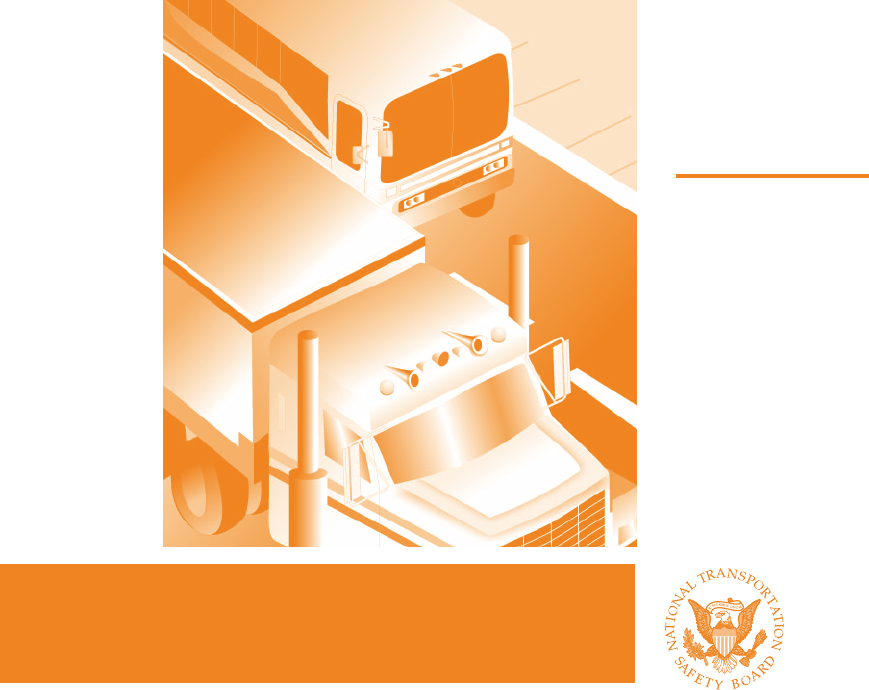
Multivehicle Collision on Interstate 90
Hampshire–Marengo Toll Plaza
Near Hampshire, Illinois
October 1, 2003
Highway Accident Report
NTSB/HAR-06/03
PB2006-916203
Notation 7776A
National
Transportation
Safety Board
Washington, D.C.
National
Transportation
Safety Board
Washington, D.C.
National Transportation
Safety Board
Washington, D.C. 20594
OFFICIAL BUSINESS
Penalty for Private Use, $300
PRSRT STD
Postage & Fees Paid
NTSB
Permit No. G-200

this page intentionally left blank

Highway Accident Report
Multivehicle Collision on Interstate 90
Hampshire–Marengo Toll Plaza
Near Hampshire, Illinois
October 1, 2003
NTSB/HAR-06/03
PB2006-916203 National Transportation Safety Board
Notation 7776A 490 L’Enfant Plaza, S.W.
Adopted April 18, 2006 Washington, D.C. 20594

National Transportation Safety Board. 2006. Multivehicle Collision on Interstate 90, Hampshire–
Marengo Toll Plaza, Near Hampshire, Illinois, October 1, 2003. Highway Accident Report
NTSB/HAR-06/03. Washington, DC.
Abstract: On October 1, 2003, a multivehicle accident occurred on the approach to an Interstate 90 toll
plaza near Hampshire, Illinois. About 2:57 p.m., a 1995 Freightliner tractor-trailer chassis and cargo
container combination unit was traveling eastbound on the interstate, approaching the Hampshire–
Marengo toll plaza at milepost 41.6, when it struck the rear of a 1999 Goshen GC2 25-passenger specialty
bus. As both vehicles moved forward, the specialty bus struck the rear of a 2000 Chevrolet Silverado 1500
pickup truck, which was pushed into the rear of a 1998 Ford conventional tractor-box trailer. As its cargo
container and chassis began to overturn, the Freightliner also struck the upper portion of the pickup truck’s
in-bed camper and the rear left side of the Ford trailer. The Freightliner and the specialty bus continued
forward and came to rest in the median. The pickup truck was then struck by another eastbound vehicle, a
2000 Kenworth tractor with Polar tank trailer. Eight specialty bus passengers were fatally injured, and 12
passengers sustained minor-to-serious injuries. The bus driver, the pickup truck driver, and the Freightliner
driver received minor injuries. The Ford driver and codriver and the Kenworth driver were not injured.
Major safety issues identified in this investigation include toll plaza design and the lack of national
standards for toll plaza design, Federal Motor Carrier Safety Administration oversight of passenger motor
carriers operating on revoked authority, collision warning system performance standards and requirements
for new commercial vehicles, and vehicle incompatibility and heavy truck aggressivity. As a result of this
accident investigation, the Safety Board makes recommendations to the U.S. Department of Energy, the
U.S. Department of Transportation, the Federal Motor Carrier Safety Administration, the Federal Highway
Administration, the American Association of State Highway and Transportation Officials, and the
International Bridge, Tunnel and Turnpike Association. The Safety Board reiterates two recommendations
to the National Highway Traffic Safety Administration.
The National Transportation Safety Board is an independent Federal agency dedicated to promoting aviation, railroad, highway, marine,
pipeline, and hazardous materials safety. Established in 1967, the agency is mandated by Congress through the Independent Safety Board
Act of 1974 to investigate transportation accidents, determine the probable causes of the accidents, issue safety recommendations, study
transportation safety issues, and evaluate the safety effectiveness of government agencies involved in transportation. The Safety Board
makes public its actions and decisions through accident reports, safety studies, special investigation reports, safety recommendations, and
statistical reviews.
Recent publications are available in their entirety on the Web at <http://www.ntsb.gov>. Other information about available publications also
may be obtained from the Web site or by contacting:
National Transportation Safety Board
Records Management Division, CIO-40
490 L’Enfant Plaza, S.W.
Washington, D.C. 20594
(800) 877-6799 or (202) 314-6551
Safety Board publications may be purchased, by individual copy or by subscription, from the National Technical Information Service. To
purchase this publication, order report number PB2006-916203 from:
National Technical Information Service
5285 Port Royal Road
Springfield, Virginia 22161
(800) 553-6847 or (703) 605-6000
The Independent Safety Board Act, as codified at 49 U.S.C. Section 1154(b), precludes the admission into evidence or use of Board reports
related to an incident or accident in a civil action for damages resulting from a matter mentioned in the report.

iii Highway Accident Report
Contents
Acronyms and Abbreviations . . . . . . . . . . . . . . . . . . . . . . . . . . . . . . . . . . . . . . . . . . . . . . . . . . . v
Executive Summary . . . . . . . . . . . . . . . . . . . . . . . . . . . . . . . . . . . . . . . . . . . . . . . . . . . . . . . . . . .vii
Factual Information . . . . . . . . . . . . . . . . . . . . . . . . . . . . . . . . . . . . . . . . . . . . . . . . . . . . . . . . . . . . 1
Accident Narrative . . . . . . . . . . . . . . . . . . . . . . . . . . . . . . . . . . . . . . . . . . . . . . . . . . . . . . . . . . . . . 1
Synopsis . . . . . . . . . . . . . . . . . . . . . . . . . . . . . . . . . . . . . . . . . . . . . . . . . . . . . . . . . . . . . . . . . . 1
Freightliner Tractor-Trailer . . . . . . . . . . . . . . . . . . . . . . . . . . . . . . . . . . . . . . . . . . . . . . . . . . 6
Goshen Specialty Bus . . . . . . . . . . . . . . . . . . . . . . . . . . . . . . . . . . . . . . . . . . . . . . . . . . . . . . 6
Chevrolet Pickup, Ford Tractor-Box Trailer, and Kenworth Tractor-Tank Trailer . . . 7
Injuries . . . . . . . . . . . . . . . . . . . . . . . . . . . . . . . . . . . . . . . . . . . . . . . . . . . . . . . . . . . . . . . . . . . . . . . 8
Emergency Response . . . . . . . . . . . . . . . . . . . . . . . . . . . . . . . . . . . . . . . . . . . . . . . . . . . . . . . . . 10
Damage . . . . . . . . . . . . . . . . . . . . . . . . . . . . . . . . . . . . . . . . . . . . . . . . . . . . . . . . . . . . . . . . . . . . . 10
Vehicle 1: Freightliner Tractor-Trailer . . . . . . . . . . . . . . . . . . . . . . . . . . . . . . . . . . . . . . . 10
Vehicle 2: Goshen Specialty Bus . . . . . . . . . . . . . . . . . . . . . . . . . . . . . . . . . . . . . . . . . . . . 11
Vehicle 3: Chevrolet Pickup Truck . . . . . . . . . . . . . . . . . . . . . . . . . . . . . . . . . . . . . . . . . . 12
Vehicle 4: Ford Tractor-Box Trailer . . . . . . . . . . . . . . . . . . . . . . . . . . . . . . . . . . . . . . . . . 13
Vehicle 5: Kenworth Tractor-Tank Trailer . . . . . . . . . . . . . . . . . . . . . . . . . . . . . . . . . . . . 13
Driver Information . . . . . . . . . . . . . . . . . . . . . . . . . . . . . . . . . . . . . . . . . . . . . . . . . . . . . . . . . . . . 13
Freightliner Driver . . . . . . . . . . . . . . . . . . . . . . . . . . . . . . . . . . . . . . . . . . . . . . . . . . . . . . . . 13
Bus Driver . . . . . . . . . . . . . . . . . . . . . . . . . . . . . . . . . . . . . . . . . . . . . . . . . . . . . . . . . . . . . . . 14
Other Drivers . . . . . . . . . . . . . . . . . . . . . . . . . . . . . . . . . . . . . . . . . . . . . . . . . . . . . . . . . . . . . 15
Vehicle Information . . . . . . . . . . . . . . . . . . . . . . . . . . . . . . . . . . . . . . . . . . . . . . . . . . . . . . . . . . 15
Freightliner Tractor-Trailer . . . . . . . . . . . . . . . . . . . . . . . . . . . . . . . . . . . . . . . . . . . . . . . . . 15
Goshen Specialty Bus . . . . . . . . . . . . . . . . . . . . . . . . . . . . . . . . . . . . . . . . . . . . . . . . . . . . . 17
Chevrolet Pickup Truck . . . . . . . . . . . . . . . . . . . . . . . . . . . . . . . . . . . . . . . . . . . . . . . . . . . . 18
Ford Tractor-Box Trailer . . . . . . . . . . . . . . . . . . . . . . . . . . . . . . . . . . . . . . . . . . . . . . . . . . . 18
Kenworth Tractor-Tank Trailer . . . . . . . . . . . . . . . . . . . . . . . . . . . . . . . . . . . . . . . . . . . . . 19
Operations Information . . . . . . . . . . . . . . . . . . . . . . . . . . . . . . . . . . . . . . . . . . . . . . . . . . . . . . . . 19
Frontline Transportation Company . . . . . . . . . . . . . . . . . . . . . . . . . . . . . . . . . . . . . . . . . . 19
Leisure Pursuit Charters, Inc. . . . . . . . . . . . . . . . . . . . . . . . . . . . . . . . . . . . . . . . . . . . . . . . 20
Federal Motor Carrier Safety Administration . . . . . . . . . . . . . . . . . . . . . . . . . . . . . . . . . 22
Highway Information . . . . . . . . . . . . . . . . . . . . . . . . . . . . . . . . . . . . . . . . . . . . . . . . . . . . . . . . . 27
General . . . . . . . . . . . . . . . . . . . . . . . . . . . . . . . . . . . . . . . . . . . . . . . . . . . . . . . . . . . . . . . . . . 27
Traffic . . . . . . . . . . . . . . . . . . . . . . . . . . . . . . . . . . . . . . . . . . . . . . . . . . . . . . . . . . . . . . . . . . . 28
Illinois State Toll Highway Authority System . . . . . . . . . . . . . . . . . . . . . . . . . . . . . . . . . 28
Hampshire–Marengo Tollbooth Configuration . . . . . . . . . . . . . . . . . . . . . . . . . . . . . . . . 28
Rumble Strips . . . . . . . . . . . . . . . . . . . . . . . . . . . . . . . . . . . . . . . . . . . . . . . . . . . . . . . . . . . . 30
Meteorological Information . . . . . . . . . . . . . . . . . . . . . . . . . . . . . . . . . . . . . . . . . . . . . . . . . . . . 32
Toxicological Information . . . . . . . . . . . . . . . . . . . . . . . . . . . . . . . . . . . . . . . . . . . . . . . . . . . . . 32
Tests and Research . . . . . . . . . . . . . . . . . . . . . . . . . . . . . . . . . . . . . . . . . . . . . . . . . . . . . . . . . . . 32
Specialty Bus Tail Lights . . . . . . . . . . . . . . . . . . . . . . . . . . . . . . . . . . . . . . . . . . . . . . . . . . 32
Freightliner Gear Speed Calculations . . . . . . . . . . . . . . . . . . . . . . . . . . . . . . . . . . . . . . . . 33
Forensic Evidence Documentation and Accident Simulation . . . . . . . . . . . . . . . . . . . . 33
Other Information . . . . . . . . . . . . . . . . . . . . . . . . . . . . . . . . . . . . . . . . . . . . . . . . . . . . . . . . . . . . 40

Contents iv Highway Accident Report
Toll Roads . . . . . . . . . . . . . . . . . . . . . . . . . . . . . . . . . . . . . . . . . . . . . . . . . . . . . . . . . . . . . . . 40
American Association of State Highway and Transportation Officials . . . . . . . . . . . . 43
Federal Highway Administration . . . . . . . . . . . . . . . . . . . . . . . . . . . . . . . . . . . . . . . . . . . . 43
International Toll Roads . . . . . . . . . . . . . . . . . . . . . . . . . . . . . . . . . . . . . . . . . . . . . . . . . . . 44
Safe, Accountable, Flexible, Efficient Transportation Equity Act . . . . . . . . . . . . . . . . 45
State Vehicle Codes for Intermodal Trailer, Chassis, and Safety . . . . . . . . . . . . . . . . . 46
Vehicle Incompatibility and Heavy Truck Aggressivity . . . . . . . . . . . . . . . . . . . . . . . . 46
Analysis . . . . . . . . . . . . . . . . . . . . . . . . . . . . . . . . . . . . . . . . . . . . . . . . . . . . . . . . . . . . . . . . . . . . . . . 48
Exclusions . . . . . . . . . . . . . . . . . . . . . . . . . . . . . . . . . . . . . . . . . . . . . . . . . . . . . . . . . . . . . . . . . . . 48
Accident Discussion . . . . . . . . . . . . . . . . . . . . . . . . . . . . . . . . . . . . . . . . . . . . . . . . . . . . . . . . . . 49
Freightliner Driver Performance . . . . . . . . . . . . . . . . . . . . . . . . . . . . . . . . . . . . . . . . . . . . . . . . 50
Collision Warning Systems . . . . . . . . . . . . . . . . . . . . . . . . . . . . . . . . . . . . . . . . . . . . . . . . . . . . 52
Highway . . . . . . . . . . . . . . . . . . . . . . . . . . . . . . . . . . . . . . . . . . . . . . . . . . . . . . . . . . . . . . . . . . . . 54
Federal Motor Carrier Safety Administration . . . . . . . . . . . . . . . . . . . . . . . . . . . . . . . . . . . . . 57
Intermodal Chassis . . . . . . . . . . . . . . . . . . . . . . . . . . . . . . . . . . . . . . . . . . . . . . . . . . . . . . . . 57
Oversight of Passenger Carriers Operating on Revoked Authority . . . . . . . . . . . . . . . 58
Vehicle Incompatibility and Heavy Truck Aggressivity . . . . . . . . . . . . . . . . . . . . . . . . . . . . 61
Conclusions . . . . . . . . . . . . . . . . . . . . . . . . . . . . . . . . . . . . . . . . . . . . . . . . . . . . . . . . . . . . . . . . . . . . 66
Findings . . . . . . . . . . . . . . . . . . . . . . . . . . . . . . . . . . . . . . . . . . . . . . . . . . . . . . . . . . . . . . . . . . . . . 66
Probable Cause . . . . . . . . . . . . . . . . . . . . . . . . . . . . . . . . . . . . . . . . . . . . . . . . . . . . . . . . . . . . . . . 67
Recommendations . . . . . . . . . . . . . . . . . . . . . . . . . . . . . . . . . . . . . . . . . . . . . . . . . . . . . . . . . . . . . 68
New Recommendations . . . . . . . . . . . . . . . . . . . . . . . . . . . . . . . . . . . . . . . . . . . . . . . . . . . . . . . 68
Reiterated Recommendations . . . . . . . . . . . . . . . . . . . . . . . . . . . . . . . . . . . . . . . . . . . . . . . . . . 69
Appendixes
A: Investigation . . . . . . . . . . . . . . . . . . . . . . . . . . . . . . . . . . . . . . . . . . . . . . . . . . . . . . . . . . . 71
B: Freightliner Combination Vehicle Information . . . . . . . . . . . . . . . . . . . . . . . . . . . . 72
C: SDM Data . . . . . . . . . . . . . . . . . . . . . . . . . . . . . . . . . . . . . . . . . . . . . . . . . . . . . . . . . . . . . . 74
D: State Toll Facilities . . . . . . . . . . . . . . . . . . . . . . . . . . . . . . . . . . . . . . . . . . . . . . . . . . . . . 77
E: SAFETEA-LU 2005 . . . . . . . . . . . . . . . . . . . . . . . . . . . . . . . . . . . . . . . . . . . . . . . . . . . . 78
F: Illinois Vehicle Code, Intermodal Equipment Exchange . . . . . . . . . . . . . . . . . . . 84

v Highway Accident Report
Acronyms and Abbreviations
AASHTO American Association of State Highway and Transportation
Officials
ACC adaptive cruise control
AE algorithm enable
CDL commercial driver’s license
CFR Code of Federal Regulations
COSCO China Ocean Shipping Company
CSA Comprehensive Safety Analysis 2010 Initiative
CVSA Commercial Vehicle Safety Alliance
CWS collision warning system
DMV Department of Motor Vehicles
DOE U.S. Department of Energy
DOT U.S. Department of Transportation
ECE Economic Commission for Europe
ECM electronic control module
EDGEN Engineering Dynamics Corporation General Analysis Tool
EDSMAC4 Engineering Dynamics Corporation Simulation of Automobile
Collisions
EEPROM electronically erasable programmable read-only memory
ETC electronic toll collection
FHWA Federal Highway Administration
Florida DOT Florida Department of Transportation
FMCSA Federal Motor Carrier Safety Administration
FMCSRs Federal Motor Carrier Safety Regulations
FY fiscal year
GCWR gross combination weight rating
GVWR gross vehicle weight rating
HM hazardous materials
HVE Human Vehicle Environment
I-90 Interstate 90
IBTTA International Bridge, Tunnel and Turnpike Association
ICC Interstate Commerce Commission
ITS intelligent transportation systems

Acronyms and Abbreviations vi Highway Accident Report
ISP Illinois State Police
ISTHA Illinois State Toll Highway Authority
IVI Intelligent Vehicle Initiative (NHTSA)
LTV light trucks and vans
MCMIS Motor Carrier Management Information System
MCSAP Motor Carrier Safety Assistance Program
MP milepost
MUTCD Manual on Uniform Traffic Control Devices
NCHRP National Cooperative Highway Research Program
NHS National Highway System
NHTSA National Highway Traffic Safety Administration
OOS out of service
ORT open road tolling
PRISM Performance Registration Information Systems Management
psi pound per square inch
SafeStat Safety Status Measurement System
SAFETEA-LU Safe, Accountable, Flexible, Efficient Transportation Equity Act: A
Legacy for Users
SDM sensing diagnostic module
SIMON Simulation Model Nonlinear
TEA-21 Transportation Equity Act for the 21st Century
U.S.C. United States Code
VMT vehicle miles traveled

vii Highway Accident Report
Executive Summary
On October 1, 2003, a multivehicle accident occurred on the approach to an
Interstate 90 (I-90) toll plaza near Hampshire, Illinois. About 2:57 p.m., a 1995
Freightliner tractor-trailer chassis and cargo container combination unit was traveling
eastbound on I-90, approaching the Hampshire–Marengo toll plaza at milepost 41.6, when
it struck the rear of a 1999 Goshen GC2 25-passenger specialty bus. As both vehicles
moved forward, the specialty bus struck the rear of a 2000 Chevrolet Silverado 1500
pickup truck, which was pushed into the rear of a 1998 Ford conventional tractor-box
trailer. As its cargo container and chassis began to overturn, the Freightliner also struck the
upper portion of the pickup truck’s in-bed camper and the rear left side of the Ford trailer.
The Freightliner and the specialty bus continued forward and came to rest in the median.
The pickup truck was then struck by another eastbound vehicle, a 2000 Kenworth tractor
with Polar tank trailer. Eight specialty bus passengers were fatally injured, and 12
passengers sustained minor-to-serious injuries. The bus driver, the pickup truck driver, and
the Freightliner driver received minor injuries. The Ford driver and codriver and the
Kenworth driver were not injured.
The National Transportation Safety Board determines that the probable cause of
the accident was the failure of the Freightliner truck driver, who was operating his vehicle
too fast for traffic conditions, to slow for traffic. Contributing to the accident was the
traffic backup in a 45-mph zone, created by vehicles stopping for the Hampshire–Marengo
toll plaza. The structural incompatibility between the Freightliner tractor-trailer and the
specialty bus contributed to the severity of the accident.
The following safety issues were identified in this investigation:
• Toll plaza design and the lack of national standards for toll plaza design,
• Federal Motor Carrier Safety Administration (FMCSA) oversight of passenger
motor carriers operating on revoked authority,
• Collision warning system performance standards and requirements for new
commercial vehicles, and
• Vehicle incompatibility and heavy truck aggressivity.
As a result of this accident investigation, the Safety Board makes
recommendations to the U.S. Department of Energy, the U.S. Department of
Transportation, the FMCSA, the Federal Highway Administration, the American
Association of State Highway and Transportation Officials, and the International Bridge,
Tunnel and Turnpike Association. The Safety Board reiterates two recommendations to
the National Highway Traffic Safety Administration.

this page intentionally left blank

1 Highway Accident Report
Factual Information
Accident Narrative
Synopsis
About 2:57 p.m.
1
on October 1, 2003, a 1995 Freightliner tractor-trailer chassis
and cargo container combination unit, operated by Frontline Transportation Company of
Elk Grove Village, Illinois, was traveling eastbound on Interstate 90 (I-90) approaching
the Hampshire–Marengo toll plaza (plaza 7) at milepost (MP) 41.6 near Hampshire,
Illinois (see figures 1 and 2), when it struck the rear of a 1999 Goshen GC2 25-passenger
specialty bus operated by Leisure Pursuit Charters, Inc. (Leisure), of Lake Bluff, Illinois.
(See figures 3 and 4.) As both vehicles moved forward, the specialty bus struck the rear of
a 2000 Chevrolet Silverado 1500 extended cab pickup truck, which was pushed into the
rear of a 1998 Ford conventional tractor-box trailer. (See figures 5 and 6.)
The Freightliner also struck the upper portion of the pickup truck’s in-bed camper
and the rear left side of the Ford trailer as the Freightliner’s cargo container and chassis
began to overturn. The Freightliner and the specialty bus continued forward and came to
rest in the median; the Freightliner’s trailer overturned completely. The pickup truck was
then struck by another eastbound vehicle, a 2000 Kenworth tractor with Polar tank trailer.
(See figures 7 and 8.) Eight bus passengers were fatally injured, and 12 passengers
sustained minor-to-serious injuries. The bus driver, the pickup truck driver, and the
Freightliner driver received minor injuries. The Ford driver and codriver and the
Kenworth driver were not injured.
.
1
Unless otherwise indicated, all times in this report are central daylight time.
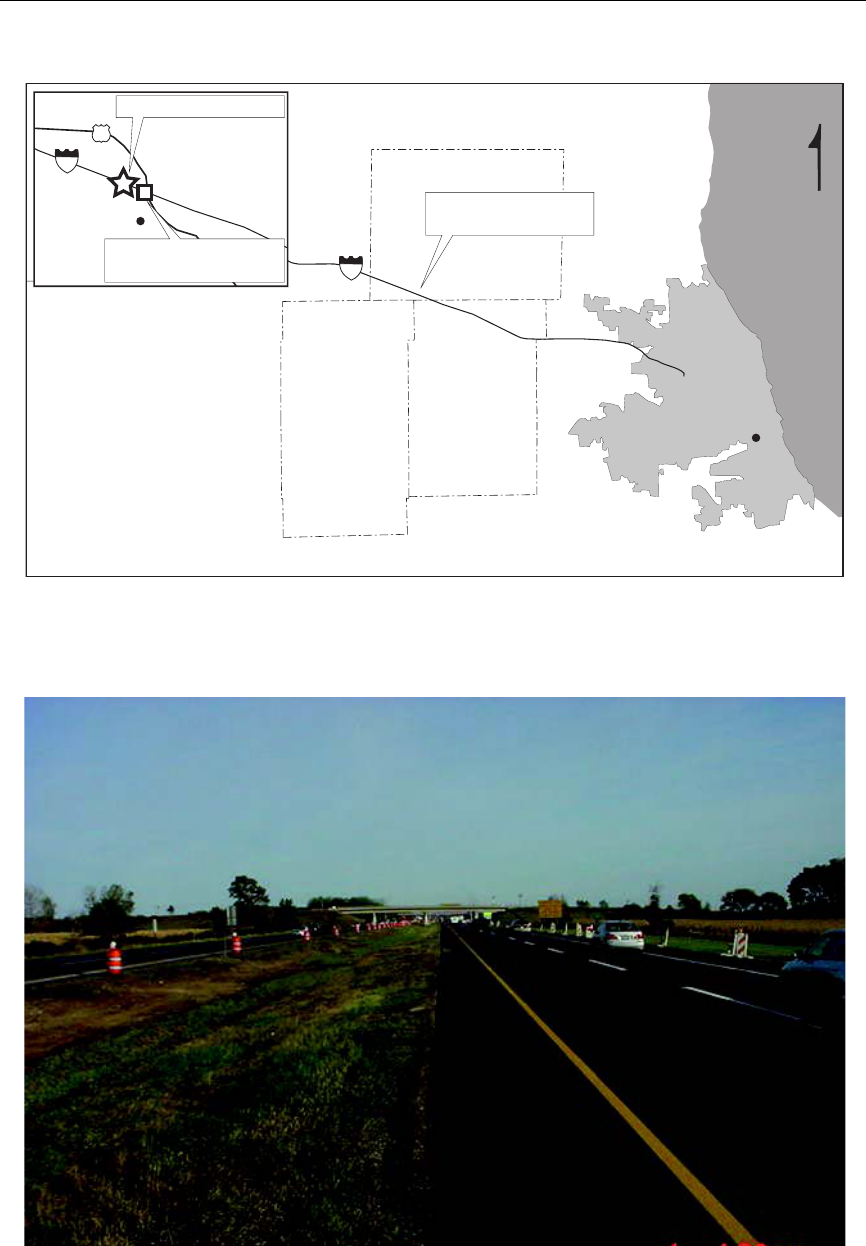
Factual Information 2 Highway Accident Report
Figure 1. Regional map of accident location.
Figure 2. View of accident location, I-90 eastbound.
KANE
COUNTY
90
Lake
Michigan
DE KALB
COUNTY
McHENRY
COUNTY
Chicago
Accident location
(see inset)
N
90
Accident location
PLAZA 7
Hampshire-Marengo
Hampshire
20
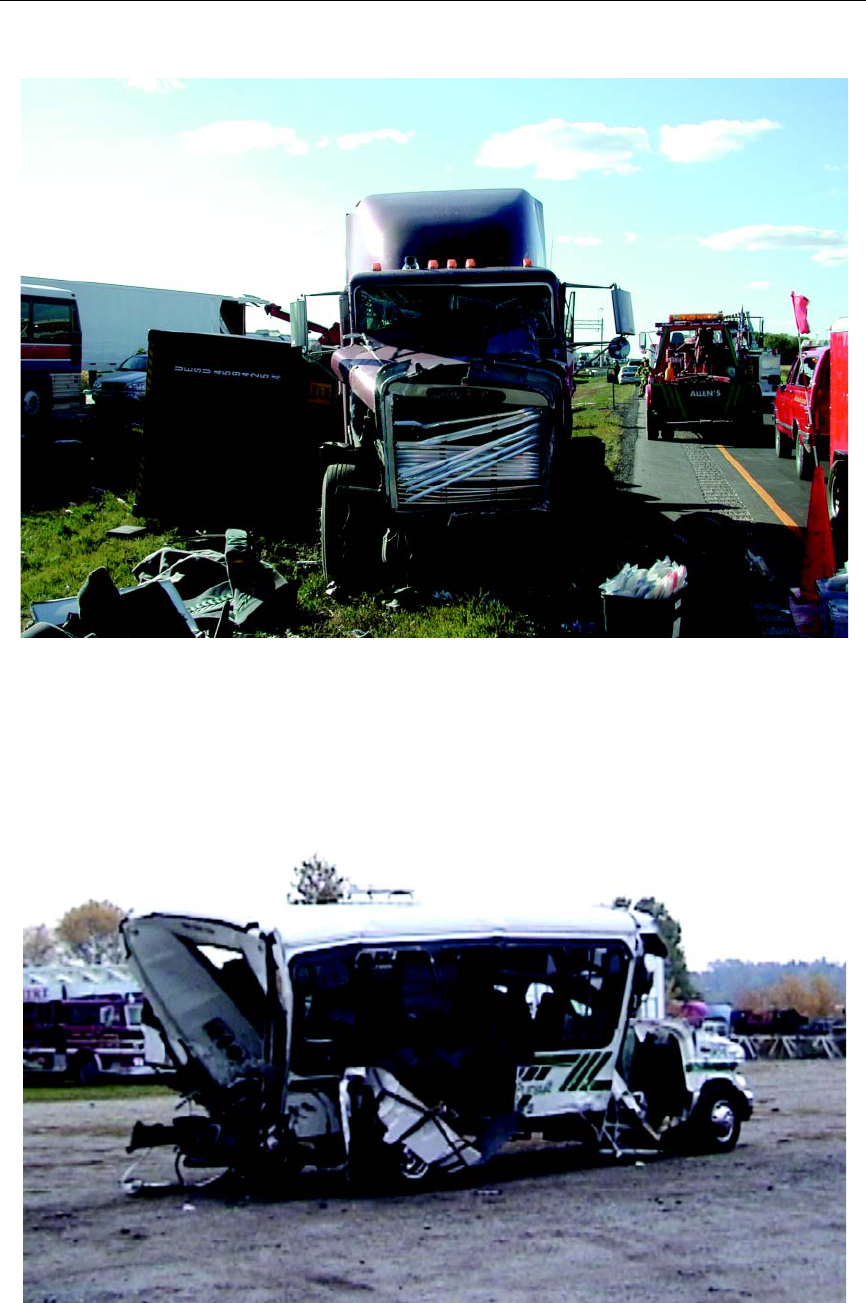
Factual Information 3 Highway Accident Report
Figure 3. Damaged Freightliner tractor-trailer. (Courtesy of Illinois State Police)
Figure 4. Damaged Goshen specialty bus.
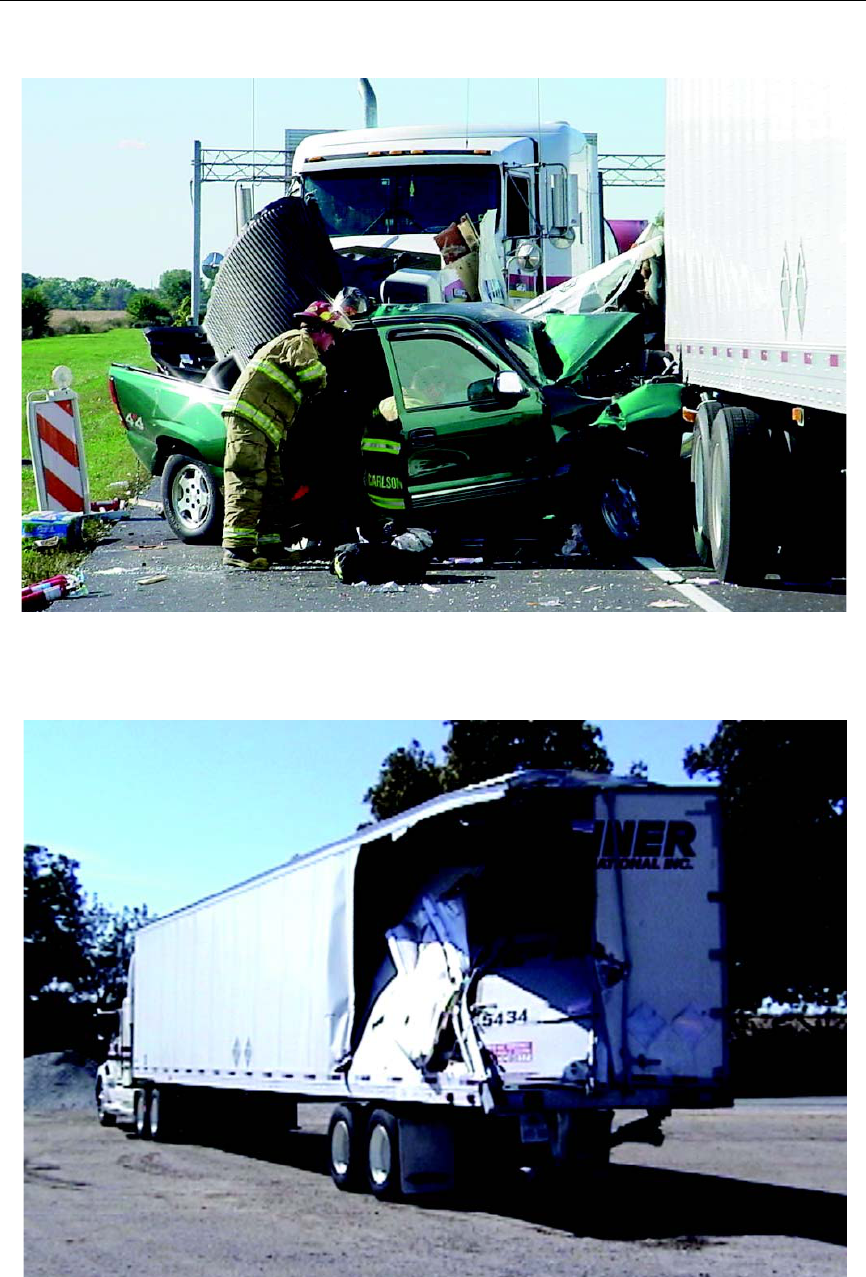
Factual Information 4 Highway Accident Report
Figure 5. Damaged pickup truck. (Courtesy of Illinois State Police)
Figure 6. Damaged Ford tractor-box trailer.

Factual Information 5 Highway Accident Report
Figure 7. Damaged Kenworth tractor-tank trailer.
Figure 8. Accident scene diagram.
Goshen
specialty bus
Freightliner
tractor-trailer position
Furrow and
plow marks
Gouge and
scrape marks
I-90
Westbound
Center median
I-90
Eastbound
Utility pole
Tire marks
Gouge and
scrape marks
Curved
tire marks
Kenworth tractor-tank
trailer position
Chevrolet
pickup truck
Ford tractor-box
trailer position
Milepost
41.5
Scale in feet
0 50 100 150 200
NORTH

Factual Information 6 Highway Accident Report
Freightliner Tractor-Trailer
The Freightliner driver reported that on the morning of the accident, about
6:00 a.m., he picked up his tractor at a rental space in Chicago, Illinois, and completed a
10- to 15-minute pretrip inspection, verifying that the lights, tires, brakes, and other
equipment were in safe operating condition. Before picking up the accident chassis, he
picked up another chassis trailer and cargo container and delivered both to a rail yard. He
then drove to the Hamilton rail yard, where he picked up the accident chassis and empty
cargo container. He reported conducting a 14-minute inspection of the chassis trailer and
container—including the brakes,
2
tires, and lights—and also said that he inspected the
cargo container for cleanliness and damage. From the Hamilton yard, he drove to Midwest
Recycling in Rockford, Illinois, where the cargo container was loaded with bundled
recycling paper. He then departed for the return trip to Chicago.
The Freightliner driver reported that he was traveling at a speed of 40 to 45 mph in
the right lane of I-90 east, following a specialty bus by about two car lengths.
3
He stated
that he routinely maintained this vehicle separation distance to prevent other vehicles from
changing lanes into his path.
4
He reported that he remained in the right lane from the time
he departed Rockford until he reached the accident location and that he experienced
difficulty pulling the loaded container because of the small engine in his truck. The driver
said that traffic was moving normally into the toll plaza and that the sun was high and to
his rear, without glare or reflection. He stated that he maintained a constant view ahead
and was startled when he saw the specialty bus stopped just in front of his vehicle.
According to the Freightliner driver, the bus was not displaying brake lights. The driver
stated that he braked hard and turned the steering wheel to the left in an unsuccessful
attempt to avoid a collision. He said that he felt the truck brakes “grab,” but the braking
action was insufficient to stop the truck, and the trailer shifted to his left
5
and went out of
control; the trailer overturned and the truck came to a stop in the median. The driver
remained in his truck until the police arrived and asked him to exit the vehicle.
Goshen Specialty Bus
On October 1, 2003, about 9:25 a.m., the accident specialty bus left Chicago with
20 passengers on board for a roundtrip sightseeing charter to Rockford. About 2:15 p.m.,
the bus departed Rockford for the return trip to Chicago. The bus driver stated that he was
in the left lane while on I-90 east and switched to the right lane 1 to 1.5 miles prior to the
accident location. He reported that he was traveling at a speed of approximately 45 mph
2
To ensure that the brakes were operational, the driver said that he visually inspected them, then
pulled the trailer forward and applied the brakes to bring the trailer to a stop.
3
A car length is typically 15 to 20 feet.
4
Illinois Department of Motor Vehicles, Illinois Commercial Driver’s License Study Guide
(Springfield, Illinois: Illinois DMV, 2003) 11, 43–44. “Following the vehicle ahead too closely is the failure
of a truck to leave sufficient distance for being overtaken by another vehicle.” One example given for proper
following speed is: “Over 40 mph, you would need 7 seconds for a 60-foot vehicle. Remember to add 1
second for speeds above 40 mph.” At 40 mph, a driver would need a headway of 410 feet—and at 45 mph,
462 feet. Both of these distances are more than 10 times the 2 car lengths (40 feet) described by the driver as
his typical following distance.
5
The trailer actually shifted and rolled to the right.

Factual Information 7 Highway Accident Report
about 1 mile west of the Hampshire–Marengo toll plaza when he observed a line of
vehicles approaching the plaza and gradually began to reduce speed to ensure passenger
comfort. The driver stated that the line of traffic was a little longer than usual and that only
one manual toll booth appeared to be in operation. According to the driver, this toll plaza
does not operate an automatic toll lane for commercial vehicles.
The bus driver reported that the sun was above and behind him at the time of the
accident and that he did not experience adverse sun glare or reflection. He said that he was
driving 10 mph about 0.5 mile from the toll plaza, when he observed in his left side mirror
a red tractor-trailer approaching in his lane at a high rate of speed. The driver reported
feeling the impact of the tractor-trailer and feeling his vehicle hit a vehicle ahead of him in
the right lane. The driver’s air bag deployed, the bus was pushed into the median, and the
driver reported steering to the right to avoid entering the westbound traffic lanes. The
driver said that he unbuckled his seat belt and stepped out of the bus to call for emergency
assistance.
Chevrolet Pickup, Ford Tractor-Box Trailer, and Kenworth Tractor-Tank
Trailer
When the specialty bus was struck by the Freightliner, it was pushed forward and
struck a 2000 Chevrolet Silverado pickup truck equipped with a bed-mounted camper. The
pickup truck driver stated that he had been traveling in the right lane at a constant speed of
50 mph when he suddenly heard a loud crash and was simultaneously forced back into his
seat by the impact of something striking his vehicle from behind. The driver reported that
he had been looking forward and did not observe the traffic behind him and had no
recollection of the vehicles ahead of him. He stated that he heard no other sounds prior to
the collision and had not braked, changed lanes, or made any other maneuver before the
accident. He remembered that his vehicle came to rest beneath a large truck and that he
was trapped in the driver’s seat. He had been wearing his three-point seat belt, and his air
bag deployed.
When the pickup truck was struck from behind by the specialty bus, the truck was
pushed forward into the rear of a 1998 Ford tractor pulling a box trailer. The driver of the
Ford combination unit stated to Safety Board investigators that he had been traveling in
the right lane at a speed of 30 to 35 mph while approaching the toll plaza. He recalled
following another tractor-semitrailer that was about two truck lengths ahead of him and
said that he had not noticed the traffic to his rear. He reported hearing a loud “explosion”
and feeling a simultaneous impact involving the rear of his vehicle, followed by two other
impacts, and immediately brought his truck to a stop. After departing his vehicle, he said
that he talked to the driver trapped in the cab of the pickup truck until emergency
personnel arrived.
The fifth vehicle involved in this accident was a 2000 Kenworth tractor-tank
trailer. The driver reported that he drove the same route weekly and, on the day of the
accident, was traveling in the right lane after reducing his speed from 62 mph in the posted
45-mph work area speed zone, anticipating slower traffic on the approach to the toll plaza.
He stated that he was following a pickup truck, which was 50 to 100 feet ahead of his

Factual Information 8 Highway Accident Report
vehicle, and the pickup truck was closely following a Ford tractor-box trailer, when the
specialty bus and the Freightliner tractor-trailer passed him in the left lane and then
merged back into the right lane in front of him. He reported that, as he approached the toll
plaza, he did not notice whether a line of vehicles was waiting to go through the manual toll
booth. The Kenworth driver said that he observed the Freightliner in the left lane, braking
hard with brake lights illuminated, and then watched it collide with the Ford tractor-box
trailer and overturn. According to the Kenworth driver, he saw the pickup truck collide with
the Ford and then lost sight of it as his vehicle skidded forward. During this sequence, he
reported that he braked hard in an attempt to avoid becoming involved in the accident and
later realized that the front of his vehicle had collided with the pickup truck.
Injuries
Eight specialty bus passengers were killed, four passengers received serious
injuries, and eight received minor injuries. (See figure 9.) The bus driver, the pickup truck
driver, and the Freightliner driver sustained minor injuries.
6
The Ford driver and codriver
and the Kenworth driver were not injured. (See table 1.)
Table 1. Injuries.
6
Safety Board postaccident inspection of the specialty bus, pickup truck, and Freightliner drivers’
three-point seat belts revealed abrasions or “load marks” indicative of use at the time of the accident.
Injury
A
Specialty bus
driver
Specialty bus
passengers
Pickup truck and
tractor-trailer
drivers
B
Total
Fatal 0 8 0 8
Serious 0 4 0 4
Minor 1 8 2 11
None 0 0 3 3
Tota l 1 20 5 26
A
Title 49 Code of Federal Regulations (CFR) 830.2 defines a fatal injury as any injury that results
in death within 30 days of the accident. It defines a serious injury as any injury that requires
hospitalization for more than 48 hours, commencing within 7 days of the date of injury; results in a
fracture of any bone (except simple fractures of fingers, toes, or nose); causes severe
hemorrhages or nerve, muscle, or tendon damage; involves any internal organ; or involves second-
or third-degree burns, or any burn affecting more than 5 percent of the body surface.
B
Chevrolet pickup truck, Freightliner tractor-trailer, Ford tractor-box trailer (including codriver), and
Kenworth tractor-tank trailer.
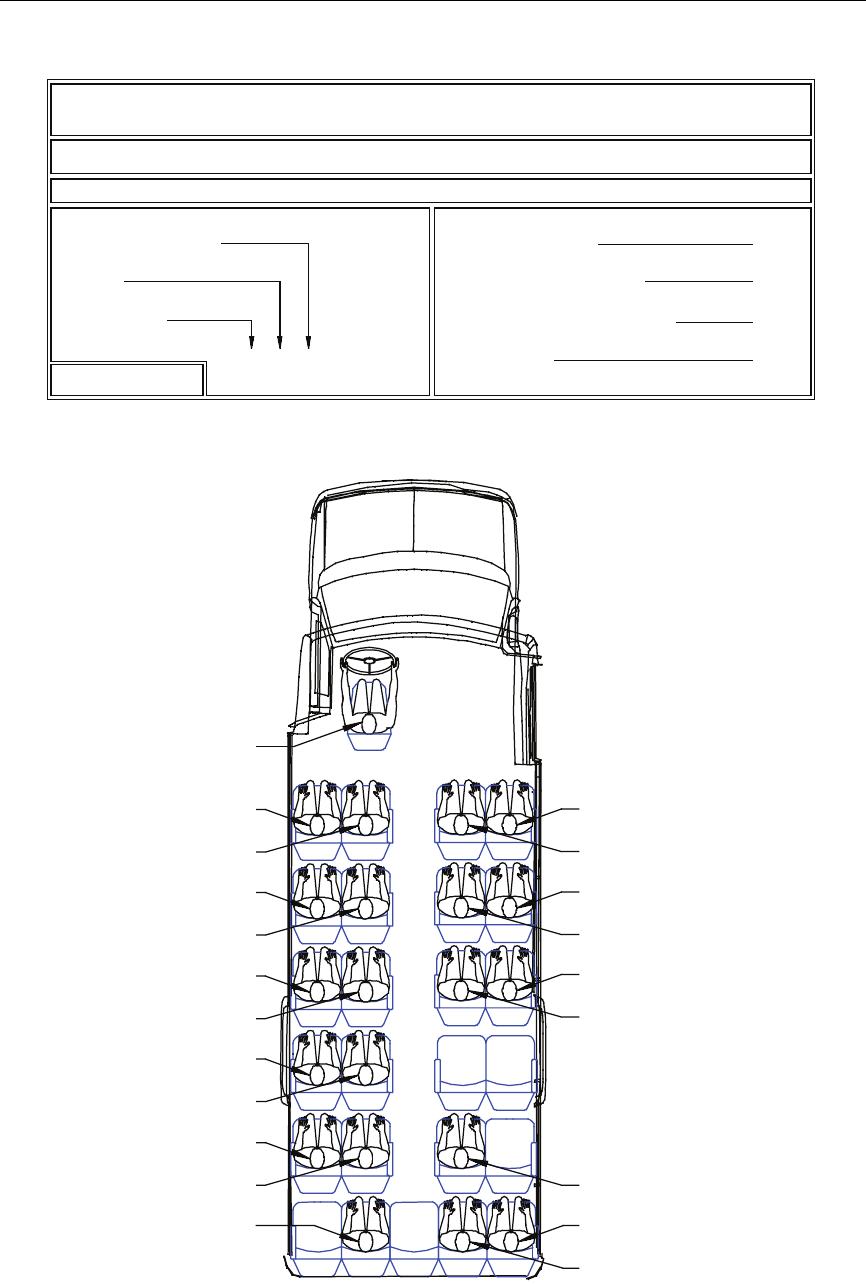
Factual Information 9 Highway Accident Report
Figure 9. Specialty bus seating diagram.
INTERNATIONAL CIVIL AVIATION ORGANIZATION
INJURY LEGEND
F = FEMALE M = MALE # = AGE
Source: NTSB
M S F
=
=
None
Minor Serious Fatal
N =
=
(E)
(R)
(NR)
(PE)
RESTRAINED
NOT RESTRAINED
PARTIALLY EJECTED
EJECTED
SAMPLE
F - 14 : M
INJURY LEVEL
AGE
GENDER
3
1
2
4
5
6
F - 76 : F (NR-PE)
F - 66 : M (NR)
F - 52 : M (R)
F - 66 : S (NR-E)
F - 40 : S (R)
F - 70 : S (NR)
F - 64 : F (NR-E)
F - 66 : F (R)
F - 75 : F (NR-PE)
M - 57 : M (R)
F - 73 : M (R)
F - 56 : M (R)
F - 53 : F
F - 67 : M (R-PE)
F - 74 : F (R)
F - 54 : F (R)
M - 74 : S (NR)
F - 73 : M (NR)
F - 66 : F (NR-PE)
F - 78 : M (NR)
F - 58 : M (NR)
A B C D
A B C D E

Factual Information 10 Highway Accident Report
Safety Board investigators interviewed 11 of the 12 surviving specialty bus
passengers, and most stated that they were sleeping when the accident occurred. Those
passengers who reported that they were restrained
7
recalled their seats being thrown
forward and becoming entangled in the interior vehicle wreckage. Some passengers exited
the bus onto the roadside, and rescue personnel extricated the entrapped passengers. Two
passengers seated in the first row on the right were ejected from the bus, and one was
fatally injured. One passenger seated in the fourth row on the left, though restrained with a
lap belt, was partially ejected and sustained minor injuries. Three other fatally injured
passengers, seated in the fifth and sixth rows, were partially ejected.
Emergency Response
At 2:56 p.m., Kane County Sheriff’s dispatchers and the Illinois State Police (ISP)
were notified of the accident through 911 communications, and they immediately initiated
an emergency response. The first emergency medical personnel and police and fire
responders arrived on scene at 3:05 p.m. The ISP and 27 local fire and rescue departments
and other emergency service agencies responded to the accident, as did 13 ambulances
and 4 medical flight helicopters. A lieutenant from the Hampshire Fire Department served
as incident commander for the medical and fire response.
Damage
Vehicle 1: Freightliner Tractor-Trailer
The Safety Board’s postaccident inspection of the 1995 Freightliner FLD tractor
and Theurer trailer cargo container combination unit revealed tire damage to the steer axle
left and right tires and to the outside tires on the second and third axles; the fourth and fifth
axle outside tires received superficial cuts. The steering and suspension systems were not
damaged. The brake system accessory line had a small air leak due to accident damage.
The trailer frame, which had overturned on the roadway and traveled through the median
before coming to rest, was deformed; the tractor remained upright and attached to the
trailer by the kingpin. The trailer chassis remained engaged to the cargo container at the
rear lock pins (the front left and right lock pins were disengaged, and mud was embedded
in the lock pin opening).
In the tractor cab interior, the floorboard—as well as the firewall and steering
wheel—were displaced aft approximately 11 inches. The dashboard and accessory panel
were deformed rearward within a few inches of the driver’s seat. The driver’s three-point
restraint showed abrasions to the webbing.
7
Although the Federal Motor Vehicle Safety Standards do not require restraints, the passenger seats
were equipped with lap belts.
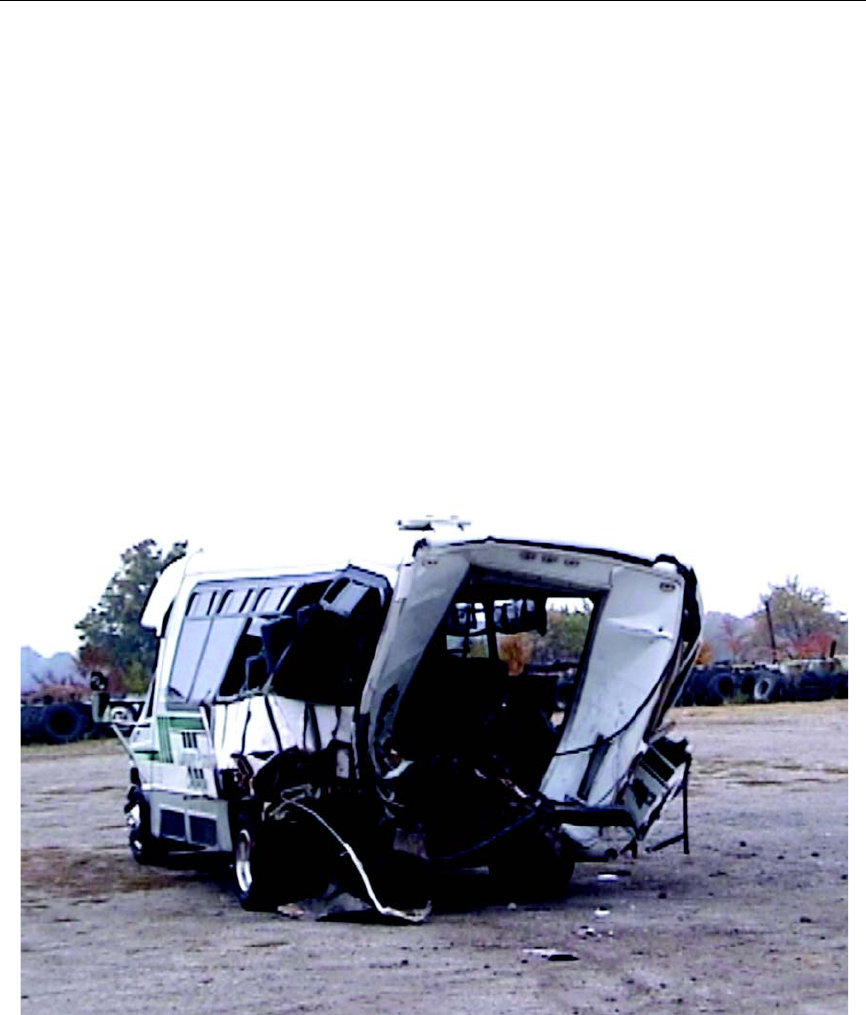
Factual Information 11 Highway Accident Report
Vehicle 2: Goshen Specialty Bus
Postaccident inspection of the 1999 Goshen GC2 25-passenger specialty bus
showed accident damage both to the front and rear of the vehicle. The right front corner of
the bus, which struck the bumper of the pickup truck, sustained damage that continued
down the right side of the bus, crushing the boarding door area and sidewall rearward, and
intruded approximately 4 feet into the front of the passenger compartment. Impact damage
from the Freightliner displaced the rear of the passenger compartment interior forward
approximately 5 feet. The right front and right rear tires sustained abrasion damage. (See
figure 10.) Longitudinal deformation of the frame rails was less than 5 inches when
measured from the inside edge on an exemplar vehicle’s bumper. (See figure 11.)
Figure 10. Specialty bus rear-impact damage.
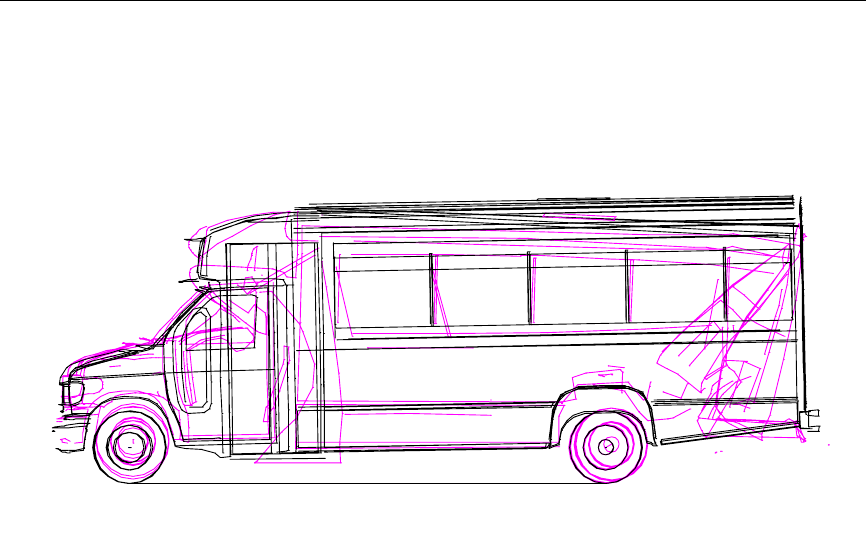
Factual Information 12 Highway Accident Report
Damage to the bus interior was also documented. The 3/4-inch plywood flooring,
which had been bolted through a rubber grommet to anchorage points on the vehicle
chassis frame rails, was buckled in the rear at the floor seam and pushed forward.
Emergency response personnel had removed four seats—the right side pair of seats in
rows four and five—for passenger extrication. In the sixth row, the rear impact tore the
passenger seats (all but the right side window seat) from the floor mountings; the floor-
mounted rails connecting the seats were cut to gain access to passengers during the
emergency response. Several seatback tray tables were broken, and several seat footrests
and both the left and right modesty panels at the front of the bus were deformed. The
driver’s air bag deployed. Seat belt webbing abrasions were observed at the driver’s
location and at passenger seats 2C, 3A, 3B, 3D, 4A, 4B, and 5A. The restraint webbing at
passenger seat 4B was cut during the emergency response.
Vehicle 3: Chevrolet Pickup Truck
The front-loading door area of the specialty bus struck the rear bumper of the 2000
Chevrolet 1500 extended cab pickup truck, and the overturning Freightliner trailer struck
the camper shell in the truck bed. After impact with the rear of the Ford tractor-box trailer,
the pickup truck was struck in the rear by the Kenworth tractor-tank trailer. The roof and
left side rail of the cab were crushed downward, touching the headrest atop the driver’s
bucket seat. Intrusion of the back panel of the extended cab into the driver’s seatback was
significant. The left portion of the dashboard was deformed rearward toward the driver’s
seat. Inspection of the driver’s three-point restraint showed evidence of abrasion to the
webbing near the D-ring on the B-pillar; the driver’s air bag deployed. In addition, the
master cylinder and brake booster were damaged, the left rear wheel assembly was
detached, and the electronic and hydraulic lines were severed.
Figure 11. Overlay of exemplar specialty bus to accident vehicle.

Factual Information 13 Highway Accident Report
Vehicle 4: Ford Tractor-Box Trailer
The 1998 Ford conventional tractor was not damaged. The Trailmobile box
trailer—approximately 53 feet long and 8.5 feet wide—was damaged at the left rear
corner, where approximately 11.5 feet had been scraped and crushed downward and
inward by the Freightliner trailer as it overturned. Of the two loading doors at the rear of
the trailer, the left door and left corner framing were broken and crushed into the cargo
area, and the center latch area of the right door was damaged. At the left rear corner, the
roof of the trailer had bent upward.
Vehicle 5: Kenworth Tractor-Tank Trailer
The 2000 Kenworth T803 tractor sustained damage to the quick-connect valve on
the brake’s air system and to the right front of the grill and bumper when it struck the rear
of the pickup truck. The Polar tank trailer of this combination unit was not damaged.
Driver Information
Freightliner Driver
Certification and Experience. The 49-year-old Freightliner driver held a valid
Illinois class A
8
commercial driver’s license (CDL), with a corrective lenses restriction
and an expiration date of January 5, 2006. He possessed a valid medical certificate issued
August 6, 2003, approximately 2 months prior to the accident, with an expiration date of
August 6, 2005. The driver had 13 years of truck driving experience and had been
employed full time by Frontline Transportation Company for 6 weeks at the time of the
accident.
Medical. According to the Freightliner driver, he did not take any prescription
medications, was wearing his prescription eyeglasses at the time of the accident, and was
not fatigued.
Duty Status. The Freightliner driver reported that he picked up his tractor about
6:00 a.m.; picked up and delivered a chassis trailer and cargo container; and then picked
up the accident chassis and cargo container and traveled to Midwest Recycling in
Rockford, Illinois, where the container was loaded. He said that he had driven the
Chicago–Rockford route on four or five previous occasions. Table 2 summarizes his 72-
hour history based on the Safety Board’s interview of the driver.
8
Class A license classification includes any combination of vehicles with a gross combination weight
rating (GCWR) of 26,001 pounds or more, provided that the gross vehicle weight rating (GVWR) of the
vehicle(s) being towed exceeds 10,000 pounds. (Holders of a class A license may, with appropriate
endorsements, operate all vehicles within classes B, C, and D.)

Factual Information 14 Highway Accident Report
Table 2. Freightliner driver’s 72-hour history.
Bus Driver
Certification and Experience. At the time of the accident, the 57-year-old bus
driver held an Illinois class B
9
CDL, with a passenger endorsement and an expiration date
of September 27, 2007. The bus driver did not possess a valid medical certificate in
accordance with 49 CFR 391.41. His medical certificate had been issued in 1999 and had
expired in 2001.
While working for Leisure, the bus driver had accumulated 6.5 years of experience
driving buses similar to the accident bus. He said that he was very familiar with the I-90
route, having traveled it many times. He had previously worked as a professional
firefighter with the Great Lakes Naval Training Center, where he operated heavy fire
department vehicles and served as a driving instructor.
Medical. During an interview with Safety Board investigators, the bus driver
stated that he was a Type II diabetic and used prescribed medications to control the
condition. The driver reported that he was taking the prescription medications Lotensin,
Actose, Amoryl, and Metformin daily; monitored his blood sugar and diet; and had
undergone cataract surgery on his right eye during the year prior to the accident. On
October 10, 2003, following the accident, the bus driver passed a complete physical
examination for commercial driver fitness and was issued a valid medical certificate. The
medical examination report indicated that the driver’s Type II diabetes was well controlled
through the use of prescribed oral medication.
Duty Status. The bus driver reported for duty at 7:00 a.m. on October 1, 2003. He
then drove the accident bus 35 miles from the company headquarters in Lake Bluff,
Illinois, to downtown Chicago, where he arrived at 9:15 a.m. He loaded his passengers
and departed on a round-trip route from Chicago to Rockford at 9:25 a.m. At 2:15 p.m., he
departed Rockford for the return trip to Chicago. Table 3 presents his 72-hour history
based on the Safety Board’s interview of the driver. The bus driver was not required to
keep driver logs due to the local nature of his operations.
10
9
Class B license classification includes any single vehicle with a GVWR of 26,001 pounds or more, or
any such vehicle towing a vehicle not exceeding 10,000 pounds GVWR. (Holders of a class B license may,
with appropriate endorsements, operate all vehicles within class C, which includes any vehicle weighing
26,000 pounds [GVWR] or less designed to transport 16 or more people.)
10
The bus driver’s operations fell within the 100-air-mile exemption. See <www.fmcsa.dot.gov/rules-
regulations/administration/fmcsr/395.1.htm#e>, January 31, 2006.
DAY TIME (DAYLIGHT)
1:00
2:00
3:00
4:00
5:00
6:00
7:00
8:00
9:00
10:00
11:00
12:00
13:00
14:00
15:00
16:00
17:00
18:00
19:00
20:00
21:00
22:00
23:00
24:00
9/28/2003
9/29/2003
9/30/2003
10/1/2003
Off Duty On Duty Sleeping
NIGHT TIME (DARKNESS)
NIGHT TIME (DARKNESS)

Factual Information 15 Highway Accident Report
Table 3. Bus driver’s 72-hour history.
Other Drivers
Chevrolet Pickup Truck. The 67-year-old pickup truck driver was traveling
eastbound on I-90 from Beaver Dam, Wisconsin, to Bartlett, Illinois. The evening prior to
the accident day he had been camping in Horicon, Wisconsin, and reported that he slept
from 11:00 p.m. until 8:00 a.m. in his camper, which was mounted in the bed of his truck.
Ford Tractor-Box Trailer. The 56-year-old Ford driver had 27 years of truck
driving experience as an employee of Penner International, Inc. At the time of the
accident, he was driving eastbound on I-90 en route to Durham, North Carolina, from
Steinbach, Manitoba, Canada, transporting a box trailer containing 25 pallets of
prescription medication. His codriver was asleep in the sleeper berth.
Kenworth Tractor-Tank Trailer. The 59-year-old Kenworth driver was an
employee of Carl Klemm, Inc., and had 36 years of truck driving experience. At the time
of the accident, he was transporting a tanker load of ink dye capsule liquid and was
traveling eastbound on I-90, en route to West Carrollton, Ohio, from Portage, Wisconsin.
The driver said that he had been on vacation for several days before returning to work on
the day of the accident.
Vehicle Information
Freightliner Tractor-Trailer
The 1995 Freightliner model FLD tractor was equipped with a Cummins Inc.
M11-330E electronic diesel fuel injection engine and nine-speed manual Eaton Fuller
Corporation RTX transmission. The tractor was owned and operated by the accident
driver, who was working for Frontline Transportation Company
11
of Elk Grove Village,
Illinois. The wheel base was 235 inches, and the tractor’s GVWR was 46,000 pounds.
12
The 1984 Theurer Inc. model 220-CC-40GN trailer chassis was owned by TRAC Lease
Incorporated of New York, New York,
13
and leased to China Ocean Shipping Company
(COSCO). The accident trailer had a DOT Federal Highway Administration (FHWA)
inspection sticker dated June 2003.
11
U.S. Department of Transportation (DOT) No. 880860.
12
For tractor, chassis trailer, and cargo container details, see appendix B.
13
At the time of the accident, TRAC Lease owned approximately 205,000 chassis trailers nationwide.
DAY TIME (DAYLIGHT)
1:00
2:00
3:00
4:00
5:00
6:00
7:00
8:00
9:00
10:00
11:00
12:00
13:00
14:00
15:00
16:00
17:00
18:00
19:00
20:00
21:00
22:00
23:00
24:00
9/28/2003
9/29/2003
9/30/2003
10/1/2003
Off Duty On Duty Sleeping
NIGHT TIME (DARKNESS)
NIGHT TIME (DARKNESS)

Factual Information 16 Highway Accident Report
The trailer was about 41 feet long and 8 feet wide and had a GVWR of 72,715
pounds. The tractor-trailer chassis combination unit was equipped with Rockwell
automatic slack adjusters on the first, second, and third axles.
14
The fourth and fifth trailer
axles
15
were equipped with 6-inch manual slack adjusters. The tractor container trailer
combination unit was equipped with a pneumatic air brake system. COSCO had a contract
with Hamilton Container Service of Chicago, Illinois, to inspect, maintain, and store its
chassis trailers. Hamilton had last inspected the accident trailer on June 5, 2003, and the
last brake adjustment on the trailer had been completed in November 2002. The 40-foot-
long, 9.5-foot-high cargo container on the chassis was filled with bundled magazines and
newspapers. The gross maximum weight of the chassis, cargo container, and cargo was
67,200 pounds.
The Theurer chassis front lock pins (left and right) could be set in an unlocked or a
slide-in locked position in a metal bracket. During Safety Board inspection of the trailer,
the front two lock pins appeared to be in the unlocked position. Small-gauge wire was
wrapped around the area of the left front lock pin. The rear lock pins were twist locks that
secured the cargo container to the chassis.
During postaccident inspection, Safety Board investigators took pushrod stroke
measurements and compared them to adjustment limits to determine whether they were
within the limit (2 inches) for nondefective brakes. The fourth axle right-side brake
exceeded the 2-inch adjustment limit by 1/16 inch. The left and right brakes on the fifth
axle exceeded the 2-inch limit by 1/2 inch. As clamp-type pneumatic brakes, the fourth
axle right brake and the left and right brakes on the fifth axle would be considered out of
adjustment.
16
Postaccident, the ISP weighed the Freightliner and chassis cargo container
combination unit at 76,480 pounds. The heights of the bumper and underlying structural
members were also documented. On a Freightliner exemplar tractor, the front bumper,
17
which was 16.8 to 28.8 inches above ground, was about 12 inches high. The structural
member of the truck-tractor front bumper was a 9.25- by 74.3- by 0.179-inch seven-gauge
steel channel. The bottom of the channel on the loaded truck-tractor was approximately
22.1 inches above ground,
18
and the top of the channel was approximately 31.4 inches
above ground. (See figure 12.)
14
The steer axle was equipped with 15-inch brake drums; the second and third axles had 16.5-inch
brake drums.
15
The trailer chassis was equipped with 16.5-inch brake drums on the fourth and fifth axles.
16
Commercial Vehicle Safety Alliance, North American Standard Out-of-Service Criteria
(Washington, DC: CVSA, 2002) 15.
17
The front bumper is constructed of flexible, aerodynamic molded plastic.
18
Freightliner LLC told investigators that the structural component behind the bumper is about 1.75
inches higher in the unloaded condition.

Factual Information 17 Highway Accident Report
Goshen Specialty Bus
The 1999 Ford E-450 Super-Duty chassis was equipped with a 6.8-liter V-10
engine, a four-speed automatic Ford 4R100 transmission, and a 1999 Goshen GC2 body
unit. When inspected postaccident, the odometer indicated 165,457 miles. The chassis was
equipped with four-wheel hydraulic disc brakes with two piston calipers. During
postaccident inspection, the ISP and Safety Board investigators noted no brake system
defects. The GVWR of the specialty bus was 14,050 pounds, and the wheel base was 158
inches. The ISP weighed the specialty bus at 9,860 pounds. On an exemplar bus, the rear
bumper, which was 20.4 to 28.8 inches above ground, was about 8.4 inches high. The
bumper mounts directly to the end of the frame rails on the chassis. (See figure 13.)
The 25-passenger bus body was equipped with a driver’s bucket seat and five rows
of four bench seats, two on each side of the bus. The sixth row, which spanned the width
of the bus, was a bench seat with five passenger positions. Each passenger seat was
equipped with a two-point (lap belt only) restraint system. The driver’s seat was equipped
with a three-point restraint and frontal air bag.
Figure 12. Freightliner bumper heights.
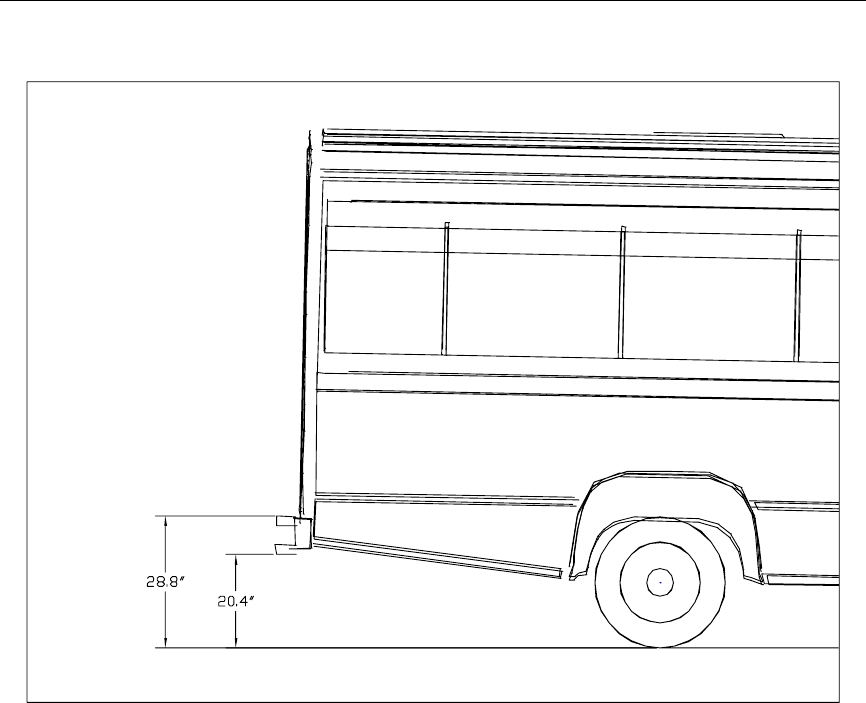
Factual Information 18 Highway Accident Report
Chevrolet Pickup Truck
The 2000 Chevrolet Silverado 1500 extended cab pickup truck was equipped with
a 5.3-liter V8 engine, automatic transmission, and Shadow Cruiser camper mounted in the
pickup bed. The camper was approximately 7 feet wide, 8 feet long, and 62 inches high
when closed. The pickup had a four-wheel antilock braking system, four-wheel hydraulic
disc brakes, and single-piston calipers. This vehicle was also equipped with a driver’s
frontal air bag, which deployed during the accident sequence. The air bag system was
electronically controlled by a sensing diagnostic module (SDM) located under the driver’s
seat. In addition to its primary function of sensing a crash event and deploying the
vehicle’s air bag, the SDM was also capable of recording a limited amount of crash data
related to the air bag deployment. Safety Board investigators and the ISP conducted a
download of the SDM data on October 4, 2003, using the ISP’s Vetronix Corporation
Crash Data Retrieval Tool. (See appendix C for details.)
Ford Tractor-Box Trailer
The 1998 Ford tractor was equipped with a Cummins N14-370F diesel engine and
Fuller transmission. When inspected postaccident, the vehicle odometer indicated 395,896
miles. The Ford did not have a dedicated event data recorder, and the engine’s electronic
control module (ECM) was not designed to capture or monitor operational or accident-
Figure 13. Specialty bus bumper heights.

Factual Information 19 Highway Accident Report
related data. The tractor was not damaged in the accident. The 2003 Trailmobile Canada
Limited trailer, which sustained some damage, was 53 feet long and 8.5 feet wide. During
postaccident inspection, Safety Board investigators found no anomalies in the vehicle’s
operating systems.
Kenworth Tractor-Tank Trailer
The 2000 Kenworth T803 tractor was equipped with a Cummins model C12-380
diesel engine and 10-speed Fuller manual transmission. When inspected postaccident, the
vehicle odometer indicated 506,934 miles. The 1981 Polar tank trailer was owned by
Klemm Tank Lines and had a postaccident hub meter reading of 96,509 miles.
Operations Information
Frontline Transportation Company
The Freightliner driver, an owner/operator of his tractor, had leased the tractor to
Frontline and was an employee of Frontline. According to the Federal Motor Carrier
Safety Administration (FMCSA) registration, Frontline Transportation Company
19
was an
authorized interstate for-hire carrier
20
of general freight and intermodal containers,
headquartered in Elk Grove Village, Illinois. The company began business in 1999. In
October 2003, Frontline reported 14 full-time drivers, 2 company tractors, 12 leased
tractors, and 20 leased trailers. Other employees included the company president, one
manager/supervisor, and two dispatchers.
Frontline operated under contract to COSCO, which operated a fleet of vessels and
leased the intermodal chassis equipment.
21,22
Because COSCO was not an interstate for-
hire carrier, it was not registered with the FMCSA. Ocean carriers such as COSCO use
trailer chassis to move their international shipping cargo containers from ports to rail
yards, from rail yards to customers, or directly from ports to customers. Like COSCO,
which was leasing the accident trailer from TRAC Lease, many ocean carriers contract
with other companies to provide chassis on demand at the port where the cargo is
unloaded.
23
19
DOT No. 880860.
20
A “for-hire” carrier is a person or company that transports cargo or passengers for compensation.
21
Most international ocean carrier regulation falls under the Federal Maritime Commission, which is
outside DOT oversight.
22
When COSCO freight arrived at the ports in containers, it was loaded onto chassis trailers for
transport to customers or delivered to rail yards for transport to other rail yards. Once the freight arrived at
the port or final rail yard, Frontline transported the chassis-contained freight to COSCO customers.
23
Peter F. Swan, A Study of the Economic Impacts and the Need for Proposed Changes to Intermodal
Container Chassis Inspection Rules (Alexandria, VA: American Trucking Associations, 2004) 6. See
<www.truckline.com>, January 31, 2006.

Factual Information 20 Highway Accident Report
According to the FMCSA, Frontline received a compliance review on August 23,
2002, that resulted in a conditional rating. Frontline was cited for driver logbook
violations and vehicle and maintenance record violations, as defined in Federal Motor
Carrier Safety Regulations (FMCSRs), 49 CFR 396.11(a) and 395.8(a). The FMCSA did
not conduct another compliance review until October 7, 2003. This postaccident review
resulted in an unsatisfactory rating. Frontline was cited for multiple violations, some of
which included:
• Failing to conduct preemployment drug testing (49 CFR 382.301(a)),
• Failing to maintain an accident register (49 CFR 390.15(b)),
• Failing to conduct inquiries with previous employers (49 CFR 40.25(b) and
382.105),
• Failing to maintain vehicle maintenance records (49 CFR 396.3(b)), and
• Failing to require drivers to make a record-of-duty status (49 CFR 395.8(a)).
After receiving the unsatisfactory rating, Frontline had 60 days to correct its
deficiencies or the FMCSA could prohibit it from operating in interstate commerce. On
November 26, 2003, the FMCSA conducted a followup compliance review of Frontline
and found several noncritical violations;
24
the FMCSA concluded that Frontline had
improved and gave the company an overall conditional rating.
25
In April 2004,
Frontline ceased operations after the FMCSA made an out-of-service (OOS)
determination; Frontline had failed to pay fines assessed during the postaccident
compliance review.
Leisure Pursuit Charters, Inc.
Leisure Pursuit Charters owned the specialty bus involved in the accident. The
FMCSA listed Leisure Pursuit Incorporated, doing business as Leisure Pursuit Charters,
as an interstate for-hire passenger carrier
26
operating out of headquarters in Lake Bluff,
Illinois. At the time of the accident, Leisure had a fleet of six buses and employed four
full-time and nine part-time drivers. According to the company, which incorporated in
1989, its business slowed after September 11, 2001, and it dropped its Interstate
Commerce Commission (ICC)
27
permit and reduced insurance coverage from the required
24
These violations included failing to require a driver to furnish a list of motor vehicle traffic violations
every 12 months, using a driver who had not completed and furnished an employment application, requiring
or permitting a driver to drive more than 10 hours, failing to require a driver to make a record-of-duty status,
and failing to require a driver to prepare a driver vehicle inspection report.
25
The conditional rating was the result of an “unsatisfactory” in the accident category; the other
categories were rated “satisfactory.” Frontline had 5.714 recordable crashes per million miles (4 recordable
crashes multiplied by 1 million miles, divided by 700,000 total actual operated miles). A rate of 0.00 to 1.50
is considered “satisfactory,” while a rate greater than 1.50 is considered “unsatisfactory.”
26
DOT No. 679636.
27
Effective January 1, 1996, the ICC was abolished, and a number of its functions were eliminated. The
remaining motor carrier (trucking) functions were transferred to the DOT (and are now under the authority
of the FMCSA).

Factual Information 21 Highway Accident Report
$5 million to $1.5 million in December 2001.
28
The insurance company notified the
FMCSA of the lowered coverage, and the FMCSA subsequently sent Leisure a letter
saying that its operating authority would be revoked if it failed to comply with the
insurance requirements. According to the FMCSA, Leisure failed to respond to the
notification letter and did not increase its insurance minimum. The FMCSA revoked
Leisure’s interstate operating authority on January 29, 2002. The company president told
Safety Board investigators that he did not receive the FMCSA revocation letter (because
of an office move), and Leisure continued to operate with the reduced insurance.
During the postaccident compliance review,
29
the FMCSA documented at least
eight interstate charters taken by Leisure after the date of its revocation of operating
authority.
30,31
During one of these interstate trips, on March 5, 2002, a driver was pulled
over in Wisconsin, subjected to a level 3
32
roadside inspection, and cited for speeding. The
inspection was for the driver only, and information related to the interstate operating status
of the carrier (which had been revoked) was not gathered. The driver had been pulled over
by a patrol officer who was certified to conduct driver-only inspections and did not have
laptop computer access to the FMCSA enforcement database, which would have indicated
that Leisure was inactive. At the time, only ISP Commercial Motor Vehicle Division
officers were certified to conduct vehicle-level inspections and had access to the FMCSA
safety databases.
33
When the accident occurred, Leisure owned six vehicles, most of which were
operating either daily or weekly and were similar to the accident vehicle, with a seating
capacity of 16 passengers or more. Because of the number of passengers permitted on
board these vehicles, the operator or carrier was required to maintain $5 million in
insurance because it was still conducting interstate business.
28
Title 49 CFR 387.33 requires that any for-hire motor carrier with a seating capacity of 16 passengers
or more operating in interstate or foreign commerce have a minimum $5 million insurance coverage.
29
During the postaccident compliance review, Leisure was cited and fined by the FMCSA for using a
driver prior to receiving preemployment drug screening results ($1,760), inadequate or lack of financial
responsibility ($2,330), and having no medical certificate in the accident driver’s qualification file ($390).
According to the Illinois Secretary of State, the Leisure Pursuit Corporation was dissolved on July 1, 2004.
30
The compliance review did not result in inspection of every charter trip taken by Leisure after its
revocation date; these eight interstate trips were found during a review of driver records.
31
In addition, the FMCSA compliance review listed the following violations: failing to randomly test
drivers for controlled substances and alcohol; failing to investigate a driver’s background; failing to
maintain a list or certificate relating to violations of motor vehicle laws and ordinances; failing to maintain
medical examiners’ certificates in drivers’ qualification files; operating a motor vehicle providing
transportation without the required registration or beyond the scope of the registration; requiring or
permitting a driver to drive after having been on duty for more than 70 hours in 8 consecutive days; failing to
keep a record of tests on push-out windows, emergency doors, and emergency door marking lights on buses;
and using a commercial vehicle that was not periodically inspected.
32
Level 3 is a driver-only inspection in which the inspector examines the driver’s license, medical
certificate, record-of-duty status, hours of service, and seat belt use.
33
An ISP senior enforcement officer reported that driver-only inspections account for about 25 percent
of roadside inspections, while vehicle walk-around inspections account for the remaining 75 percent. Since
this accident, ISP patrol officers have been certified to conduct both driver-only and walk-around vehicle
inspections and have laptop computer access to the FMCSA databases.

Factual Information 22 Highway Accident Report
Federal Motor Carrier Safety Administration
The FMCSA was established as a separate administration within DOT on
January 1, 2000, pursuant to the Motor Carrier Safety Improvement Act of 1999. Its
primary mission is to reduce accidents, injuries, and fatalities involving large trucks and
buses. According to the FMCSA, the agency develops and enforces data-driven
regulations and uses safety information systems to focus on higher risk carriers. The
FMCSA requires a motor carrier to have adequate management controls that comply with
applicable safety requirements and uses a rating formula to determine a motor carrier’s
safety fitness. The FMCSA mission is primarily accomplished through on-site compliance
reviews and roadside inspections of a carrier’s vehicles and drivers.
Compliance Reviews. In accordance with 49 CFR Part 385, appendix A, the first
step in the safety fitness rating methodology is an FMCSA-conducted compliance review.
Applying six factors (see table 4), the FMCSA rates a carrier’s compliance with the
FMCSRs, which establish safe operating requirements for commercial vehicle drivers,
carriers, vehicles, and vehicle equipment. A carrier may be selected for a compliance
review if identified as a high risk because of:
• A Safety Status Measurement System (SafeStat) score,
34
• A complaint against the company,
• An enforcement followup to ensure that an enforcement action was effective,
• Involvement in a fatal accident,
• Involvement in a major hazardous materials (HM) accident,
35
• A DOT Office of Inspector General request,
• A congressional inquiry, or
• A carrier’s request.
In fiscal year (FY) 2003, 9,068 Federal compliance reviews were conducted; in FY
2004, 7,637; and in FY 2005, 7,998.
36
In Illinois, the FMCSA has revoked the operating
authority of 270 carriers since 2002.
34
SafeStat is an automated, data-driven analysis system that is designed to incorporate on-road safety
performance information and enforcement history with on-site compliance review information to measure
the relative safety fitness of interstate motor carriers.
35
According to the FMCSA, compliance reviews occurring outside the Motor Carrier Safety
Assistance Program (MCSAP) are based on focus areas (HM or passenger carriers) identified in each State’s
safety plan and congressional mandates, such as public complaints and revisiting “conditional”-rated
carriers.
36
See (a) <www.fmcsa.dot.gov/facts-research/facts-figures/mcspr-03-31-05.html>, January 4, 2006.
(b) <www.fmcsa.dot.gov/facts-research/facts-figures/mcspr-12-31-05.htm>, February 24, 2006. These
statistics are current as of the dates shown.

Factual Information 23 Highway Accident Report
Table 4. Motor carrier safety rating factors.
The six factors listed in table 4 provide the basis for determining a carrier’s safety
rating, that is, the degree to which the carrier is in compliance with the FMCSRs and
meets the Federal safety fitness standard. As defined below, each factor is rated
“satisfactory,” “conditional,” or “unsatisfactory,” except the accident factor, which is rated
either “satisfactory” or “unsatisfactory”:
• A satisfactory rating indicates that the carrier has not violated any acute
regulations
37
or shown a pattern of noncompliance with critical regulations.
38
• A conditional rating indicates that the carrier has violated one acute regulation
or has a pattern of noncompliance with critical regulations.
• An unsatisfactory rating indicates that the carrier has violated two or more
acute regulations or has a pattern of noncompliance with two or more critical
regulations.
The rating for factor 6, the accident factor, is based on the number of recordable
accidents
39
in relation to the carrier’s annual mileage. According to the FMCSA, an
accident rate below 1.5 per million miles is considered “satisfactory”; anything higher is
rated “unsatisfactory.”
The ratings for the first five factors and the accident factor (number of recordable
accidents per million miles traveled in the 12 months prior to the compliance review) are
entered into a rating table, which is used to establish the motor carrier’s overall safety
rating (see table 5). Each of the six factors receives equal weight.
Factor Applicable FMCSRs or other criteria
1–General Parts 387 and 390
2–Driver Parts 382, 383, and 391
3–Operational Parts 392 and 395
4–Vehicle Parts 393 and 396
5–Hazardous materials Parts 171, 177, 180, and 397
6–Accident Recordable preventable rate
37
Acute violations of the FMCSRs or HM regulations—for example, requiring or permitting the
operation of an OOS vehicle before repairs are made—demand immediate corrective action regardless of the
motor carrier’s overall safety posture (49 CFR Part 385, appendix B II(b)).
38
Critical violations indicate deficiencies in the motor carrier’s management controls, such as requiring
or permitting a driver to drive after having been on duty for 15 hours (49 CFR Part 385, appendix B II(b)).
39
The FMCSA defines a recordable accident as an occurrence involving a commercial motor vehicle
operating on a public road in interstate or intrastate commerce that results in a fatality, a bodily injury, or a
vehicle incurring disabling damage that requires it to be towed from the scene (49 CFR 390.5).
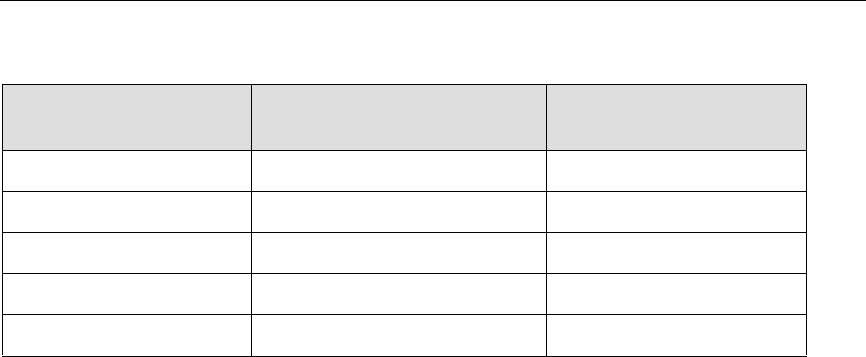
Factual Information 24 Highway Accident Report
Table 5. Motor carrier safety rating table.
In September 2005, Safety Board staff met with the FMCSA and learned that it is
currently evaluating the compliance review process as part of the Comprehensive Safety
Analysis (CSA) 2010 Initiative. According to the FMCSA, the CSA 2010 Initiative is an
effort to evaluate the effectiveness of the FMCSA’s current safety compliance and
enforcement programs, such as compliance reviews and roadside inspections, and to
identify better methods of achieving a crash-free environment. The FMCSA indicated that
the evaluation is still in its early stages, no conclusions have been reached, and it is too
soon to speculate on what specific changes may be made in the safety rating process. Full
implementation of any changes proposed by the initiative is not expected until 2010.
Roadside Inspections. Most State roadside inspections are conducted under the
FMCSA-administered MCSAP, a Federal grant program that provides States with
financial assistance to hire staff and implement strategies to enforce the FMCSRs.
MCSAP provides funds to promote the detection and correction of commercial motor
vehicle safety defects, commercial vehicle driver deficiencies, and unsafe motor carrier
practices before they become contributing factors to accidents or HM incidents. Under the
FMCSA roadside inspection program, qualified safety inspectors carry out commercial
vehicle roadside inspections in compliance with the North American Standard Inspection
Program guidelines, which were developed by the CVSA and the FMCSA. During
roadside inspections, an inspector examines vehicles or their drivers or both to determine
whether they meet the FMCSRs. The five levels of inspection are:
• Level I: Examination of the driver’s license, medical examiner’s certificate and
waiver (if applicable), alcohol and drugs, driver’s record-of-duty status (as
required), hours of service, seat belt, vehicle inspection report, brake system,
coupling devices, exhaust system, frame, fuel system, turn signals, brake
lamps, tail lamps, head lamps, lamps on projecting loads, safe loading, steering
mechanism, suspension, tires, van and open-top trailer bodies, wheels and
rims, windshield wipers, emergency exits on buses, and HM requirements.
• Level II: A walk-around driver/vehicle inspection that includes each of the
items specified under the North American Standard Inspection Program
guidelines. At a minimum, level II inspections must include level I items; it is
assumed that the walk-around driver/vehicle inspection includes only those
items that can be inspected without physically getting under the vehicle.
Number of factors with
unsatisfactory ratings
Number of factors with
conditional ratings
Resultant overall
safety rating
0 2 or less Satisfactory
0 More than 2 Conditional
1 2 or less Conditional
1 More than 2 Unsatisfactory
2 or more 0 Unsatisfactory

Factual Information 25 Highway Accident Report
• Level III: A driver/credential examination that includes, at a minimum, as
required or applicable, examination of the driver’s license, medical
certification, skill performance evaluation certificate, driver’s record-of-duty
status, hours of service, seat belt, and HM requirements. Those items not
indicated in the North American Standard level III driver/credential inspection
procedure are not included in a level III inspection.
• Level IV: A “special inspection,” normally in support of a study or to verify or
refute a suspected trend, that typically includes a one-time examination of a
particular item—for example, a postaccident examination of commercial
vehicles involved in an accident.
• Level V: A vehicle-only inspection that includes each of the vehicle inspection
items specified under level I, without a driver present, conducted at any
location.
Once an inspection is completed, the finding of serious safety violations can result
in the issuance of driver or vehicle OOS orders. Any such violations must be corrected
before the affected driver or vehicle can return to service. (See table 6 for roadside
inspection data.)
Table 6. Registered vehicles, roadside inspections, and OOS data.
According to 49 CFR 350.213(b)(4), to obtain MCSAP funding, a State must
conduct activities to enforce registration requirements under 49 United States Code
(U.S.C.) 13902 and 49 CFR Part 365 and financial responsibility requirements under 49
U.S.C. 31138 and 31139 and 49 CFR Part 387.
40
In addition, to qualify for MCSAP basic
program funds under 49 CFR 350.201, a State must enforce financial responsibility
requirements under 49 U.S.C. 13906, 31138, and 31139 and 49 CFR Part 387. In FY 2004,
the State of Illinois received $5.6 million in MCSAP funding.
41
Type of
vehicle
2003
Registered
vehicles
A
FY 2003
Roadside
inspections
FY 2004
Roadside
inspections
B
FY 2004
Driver
inspections
(OOS rate)
FY 2004
Vehicle
inspections
(OOS rate)
FY 2005
Roadside
inspections
Large
trucks
7,912,018 2,991,788
(37.8%)
2,949,487
(37.3%)
2,859,219
(6.7%)
2,159,368
(23.9%)
2,950,640
(37.3%)
Buses 776,550 42,377
(5.5%)
42,864
(5.5%)
23,568
(5.1%)
36,731
(9.5%)
48,625
(6.3%)
SOURCE: See <www.fmcsa.dot.gov/facts-research/facts-figures/analysis-statistics/mcspr-03-01-06.htm> and Motor
Carrier Safety Progress report, June 30, 2004.
A
Registered vehicles are those that have been registered through a State motor vehicle department; as of December
23, 2005, the most recent year for which data are available is 2003.
B
Roadside inspections may include driver and vehicle within the same inspection count.
40
See <www.fmcsa.dot.gov/rules-regulations/administration/fmcsr/350.213.htm>, January 31, 2006.
41
Information obtained from Safety Programs Office, FMCSA.

Factual Information 26 Highway Accident Report
Insurance Compliance and Operating Authority Revocation. According to
FMCSA safety regulations at 49 CFR 387.33, any for-hire motor carrier of passengers
operating in interstate or foreign commerce with a seating capacity of 16 persons or more
must have minimum insurance coverage of $5 million. When a passenger carrier no longer
carries the minimum insurance, or a policy is set to expire, the insurance company notifies
the FMCSA, which then sends a letter to the carrier, giving it 90 days to either renew or
change insurance. If the carrier fails to comply, the FMCSA revokes the carrier’s
operating authority and changes its operating status to “inactive” within FMCSA
databases.
42
According to the FMCSA,
43
a carrier that continues to operate while inactive
is “rarely prosecuted through compliance reviews or roadside inspections.”
44
The FMCSA has indicated that, in January 2004, as part of its insurance
compliance initiatives, it implemented a policy change for revocation of operating status
that reduced the notice period from 90 days to 30 days. If a carrier fails to renew its policy
by the 30th day, the FMCSA immediately revokes its authority to operate, which places
the carrier in OOS status. In addition, the FMCSA stated to Safety Board staff that a
carrier’s OOS status appears in bold red in the Motor Carrier Management Information
System (MCMIS) if its safety data are checked by an MCSAP inspector during a roadside
inspection. The FMCSA also said that it maintains a list of cancellations in the MCMIS
licensing and information report, which shows all carriers currently operating with
canceled insurance—in effect, operating without authority.
On February 8, 2004, the FMCSA Administrator made a speech to the United
Motorcoach Association in Atlanta, Georgia, in which she pledged to work with
association members to get uninsured and “other illegal motorcoach operators” off the
highways. The Administrator further stated:
FMCSA will start to cross-match insurance revocations with inspection and crash
databases, and generate automated claim letters for prompt field enforcement
action. Where a carrier shows inspection or crash activity during the time that its
insurance is suspended, FMCSA will know the company is operating without
authority and enforcement action will be swift. These matches will be done
electronically, supplementing field observations of motor carrier operations.
These changes underscore FMCSA’s commitment to increased safety.
42
The active or inactive designation refers to the status of the motor carrier number assigned to a
company that has applied for operating authority. “Inactive” applies when a carrier either has had its
operating authority involuntarily revoked by the FMCSA or has requested a revocation.
43
E-mail correspondence from Office of Policy and Program Development, FMCSA, September 22,
2005.
44
According to FMCSA regulation 49 CFR 387.41, the penalty for violation of the insurance minimum
is that any person (except an employee who acts without knowledge) who knowingly violates the rules of
this subpart is liable to the United States for civil penalty of no more than $11,000 for each violation, and if
any such violation is a continuing one, each day of violation constitutes a separate offense. In determining
the amount of such penalty, the Administrator or his/her designee takes into account the nature,
circumstances, extent, and gravity of the violation committed and, with respect to the person found to have
committed such violation, the degree of culpability, history of prior offenses, ability to pay, effect on ability
to continue to do business, and such other matters as justice may require.

Factual Information 27 Highway Accident Report
Performance and Registration Information Systems Management. The
Performance and Registration Information Systems Management (PRISM) program is a
voluntary Federal–State partnership that makes safe performance a requirement for
obtaining and keeping commercial vehicle registration. PRISM links Federal motor carrier
safety records with a State’s vehicle registration system.
45
The DOT number of the carrier
responsible for safety is identified at the vehicle level, allowing the State to determine a
carrier’s safety fitness before issuing license plates. Safety performance is continuously
monitored, and carriers prohibited by the FMCSA from operating in interstate commerce
may have their ability to register vehicles denied. According to the FMCSA, PRISM plays
a key role in its effort to remove high-risk carriers from highways. As of December 31,
2005, 42 States—including Illinois—were participating in the PRISM program.
46
The PRISM commercial vehicle registration process establishes a system of
accountability to verify that no vehicle is license-plated without identifying the carrier
responsible for its safety.
47
The use of registration sanctions serves as an incentive for
unsafe carriers to improve their safety performance, according to the FMCSA.
48
In
addition, through monitoring, carriers that do not improve their safety performance face
progressively more stringent penalties, which may result in unfit or imminent hazard
determinations and the possible suspension of vehicle registrations by the State.
Highway Information
General
The accident occurred on I-90 east at MP 41.6, approximately 2,600 feet west of
the Hampshire–Marengo toll plaza. I-90—a divided, straight, and level four-lane asphalt
roadway—is classified as an urban principal arterial road.
49
As part of the Illinois State
Toll Highway, this section of roadway is referred to as the “Northwest Tollway,” 76.5
miles stretching from I-294 in Chicago northwest to the Wisconsin State line. At the
accident location, the 41-foot-wide paved portion of roadway comprised two main travel
lanes (25 feet total width), an 11-foot-wide right shoulder, and a 5-foot-wide left shoulder.
A 50-foot-wide depressed grassy median separated the eastbound and westbound lanes.
Because of a construction work zone that extended from MPs 25.5 to 62.5, the posted
45
In some States, legislation must be passed to provide the legal authority to impose vehicle
registration sanctions against motor carriers that have been prohibited from operation by the FMCSA.
46
States not participating in PRISM as of December 2005 are Maryland, Michigan, Mississippi,
Montana, Nevada, North Dakota, and Wisconsin. The State of New York had signed a letter of intent.
47
See <www.fmcsa.dot.gov/facts-research/facts-figures/analysis-statistics/prism.htm>, January 31, 2006.
48
E-mail correspondence from Office of Policy and Program Development, FMCSA, September 22,
2005.
49
The urban principal arterial road system serves the major centers of activity of urbanized areas, the
highest traffic volume corridors, and the longest trip desires, and carries a high proportion of the total urban
travel even though it constitutes a relatively small percentage of the total roadway network. American
Association of State Highway and Transportation Officials, A Policy on Geometric Design of Highways and
Streets (Washington, DC: AASHTO, 2004) 11.
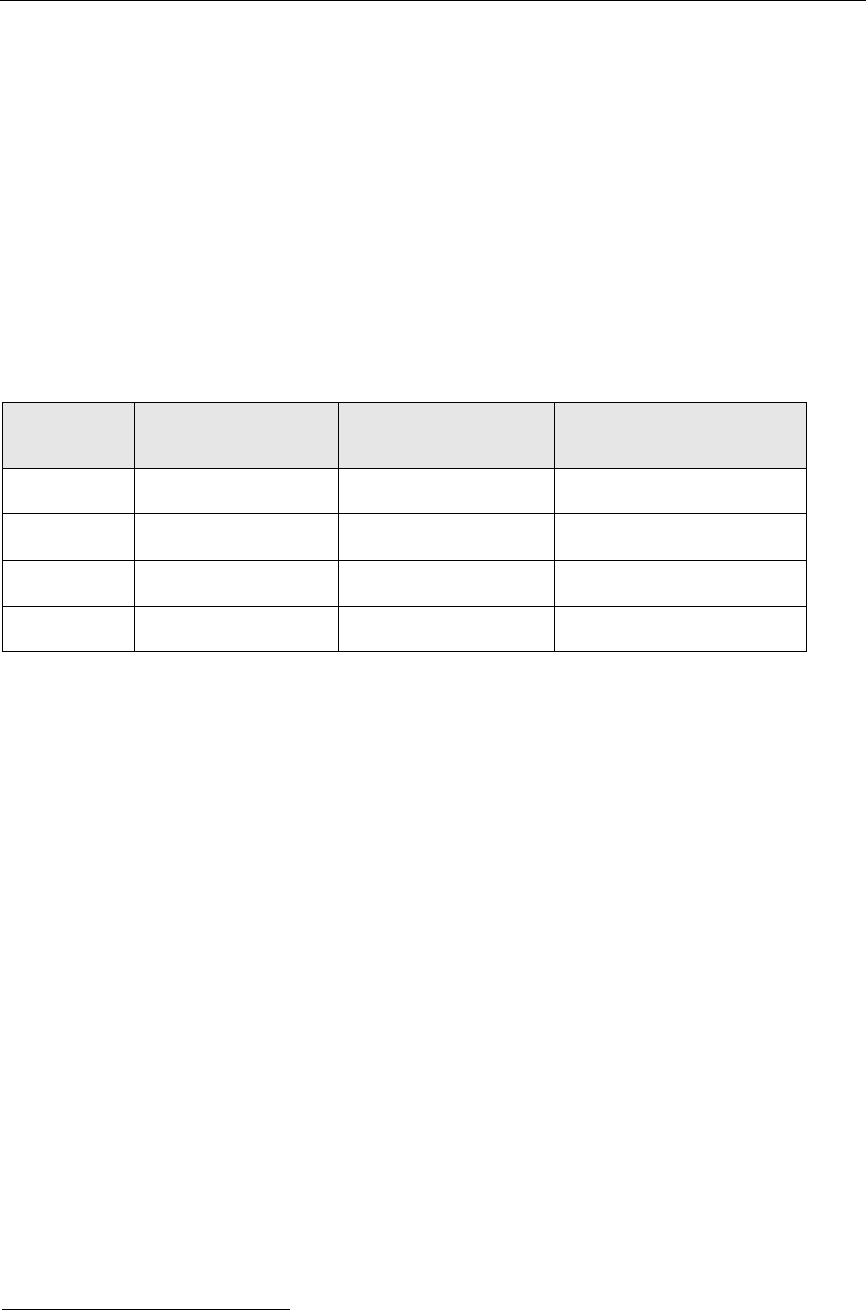
Factual Information 28 Highway Accident Report
speed limit for I-90 at the accident site was 45 mph. The signage for the reduced speed
limit began 5.3 miles prior to the accident site, and toll information signage began 0.5 mile
prior to the accident site (at MP 42.1).
Traffic
The ISP accident report stated that traffic at the time of the accident was moderate
to heavy and “normal for this road at this time” of day. According to the Illinois State Toll
Highway Authority (ISTHA), in 2002 the average daily traffic in the vicinity of the
accident site was 43,710 vehicles. (See table 7.)
Table 7. Number of passenger and commercial vehicles traveling through Hampshire–
Marengo toll plaza and average daily traffic count, 1999–2002.
In August 2003, ISTHA vehicle classification data showed that 1,391,327 vehicles
passed through the Hampshire–Marengo toll plaza, 224,767 (16.2 percent) of which were
commercial vehicles.
Illinois State Toll Highway Authority System
ISTHA, established in 1953 as the Illinois State Toll Highway Commission, was
created by a special act of the Illinois State Legislature. It is a user-financed administrative
agency of the State of Illinois, the purpose of which is to operate, maintain, and service a
system of toll roads located in northern Illinois. The tollway system encompasses 274
miles of mainline roadway and 20 mainline plazas.
Hampshire–Marengo Tollbooth Configuration
Figures 14 and 15 show the Hampshire–Marengo approach view and toll booth
and toll lane configuration at the time of the accident. Lanes 1–3 (from right to left) were
manual cash lanes with toll collectors for all vehicles, and lanes 4–6 (from right to left)
were automatic coin lanes for cars only. At the time of the accident, the only manual lane
available for commercial traffic was lane 3. Lane 1 was open weekdays during peak
commercial hours, from 6:00 a.m. to 2:00 p.m., and closed the rest of the day. At the time
of the accident, the toll collector for lane 2 was on break, and this lane was closed.
50
The
Year Passenger vehicles Commercial vehicles
Average daily traffic
count
2002
12,807,763 3,146,263 43,710
2001
12,137,871 3,194,329 42,000
2000
10,993,903 3,033,146 39,900
1999
11,430,000 3,133,781 38,470
50
The toll collector was in the toll plaza building’s restroom.
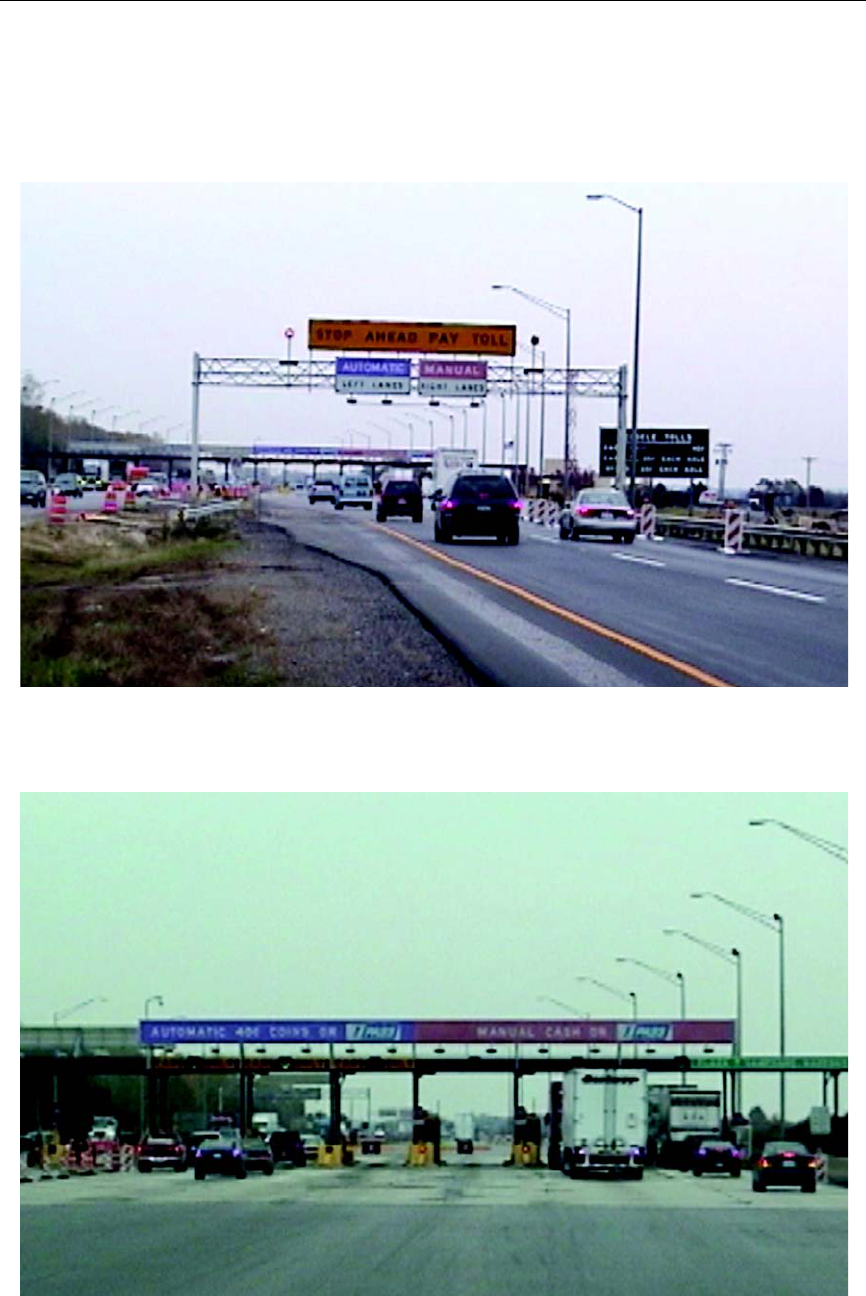
Factual Information 29 Highway Accident Report
lane 3 toll collector stated that he observed no unusual queuing of traffic in lane 3 before
the accident; he said that four or five tractor-semitrailers were in line to pass through the
toll plaza.
Figure 14. Approach view of accident toll plaza.
Figure 15. Accident scene toll plaza lanes.

Factual Information 30 Highway Accident Report
At the time of the accident, the Hampshire–Marengo toll plaza was under
construction for conversion of an existing manual lane (lane 3) to an I-PASS
51
-only lane
for use by both passenger and commercial vehicles. (See figure 15.) The Hampshire–
Marengo toll plaza I-PASS-only lane, completed in November 2003, was designed to
allow I-PASS participants to drive through at a posted speed of 5 mph without stopping.
I-PASS was in use on all lanes at the time of the accident; both passenger and
commercial vehicles were required to stop. When the transponder was detected, a gate was
activated in the automatic lanes or activated by the toll collector in the manual lanes, and the
vehicle could proceed. Eight mainline toll plazas were converted to open road tolling (ORT)
in 2005, and the remaining 12 plazas are expected to be completed by September 2006.
52
As a rule, after conversion each plaza will have as many ORT lanes as it has mainline
lanes leading into or exiting the plaza. Vehicles without an I-PASS will exit the new mainline
to pay tolls at express plazas located on the sides of the roadway. These plazas are located so
as not to affect the free flow of traffic on the mainline. The Hampshire–Marengo toll plaza
was scheduled to receive an estimated $42.7 million in 2005–2006 for reconstruction and
consolidation with the Belvidere toll plaza (plaza 5). According to ISTHA, this
reconstruction was part of its ORT conversion; the 10-year $5.3-billion plan is intended to
provide customers with faster, safer, and more reliable travel. ISTHA stated that the
conversion from traditional toll plazas to a barrier-free system, as a first in the United States,
“will allow I-PASS users to travel at highway speeds on the mainline while their tolls are
collected electronically by a gantry overhead, reducing traffic congestion and travel times.”
53
As of December 2005, construction work had started on the reconstruction and consolidation
of the two plazas. When the mainline toll plazas are removed, I-PASS customers will have
unimpeded travel over the entire 274-mile tollway. (See figure 16.)
Rumble Strips
The accident occurred at MP 41.6, approximately 2,600 feet west of the Hampshire–
Marengo toll plaza. Rumble strips
54
had been installed approximately 1,200 feet prior to the
toll plaza in both the eastbound and westbound directions. According to ISTHA, the rumble
strips were removed because they were not included in the construction plans for the
roadway resurfacing project that began in June 2003, which extended from MPs 36 to 53.
55
51
I-PASS is an electronic toll collection (ETC) program developed by ISTHA. Motorists enrolled in
I-PASS obtain a transponder device, which allows them to pay tolls electronically from a prepaid account. In
2001, I-PASS ETC accounted for more than 36 percent of all toll revenue; more than 700,000 transponders
were in use. The I-PASS lane was expected to process 2,000 vehicles per hour; the manual lanes at the
Hampshire–Marengo toll booths processed an average of 300 vehicles per hour. (See appendix D for a table
of States with and without toll facilities.)
52
Telephone communication with ISTHA manager of maintenance and traffic, December 8, 2005.
53
Illinois State Toll Highway Authority, Open Roads for a Faster Future (Springfield, IL: ISTHA, 2005) 4.
54
Rumble strips—intermittent narrow, transverse areas of rough-textured or slightly raised or
depressed road surface—are used to alert drivers to unusual vehicular traffic conditions. By means of noise
and vibration, they attract the driver’s attention to such features as unexpected changes in alignment and to
conditions requiring a stop. U.S. Department of Transportation, Federal Highway Administration, Manual
on Uniform Traffic Control Devices (MUTCD), (Washington, DC: FHWA, 2003) 6F–44F.
55
Illinois State Toll Highway Authority Contract RR-02-5062, Roadway Resurfacing, Northwest
Tollway (I-90).
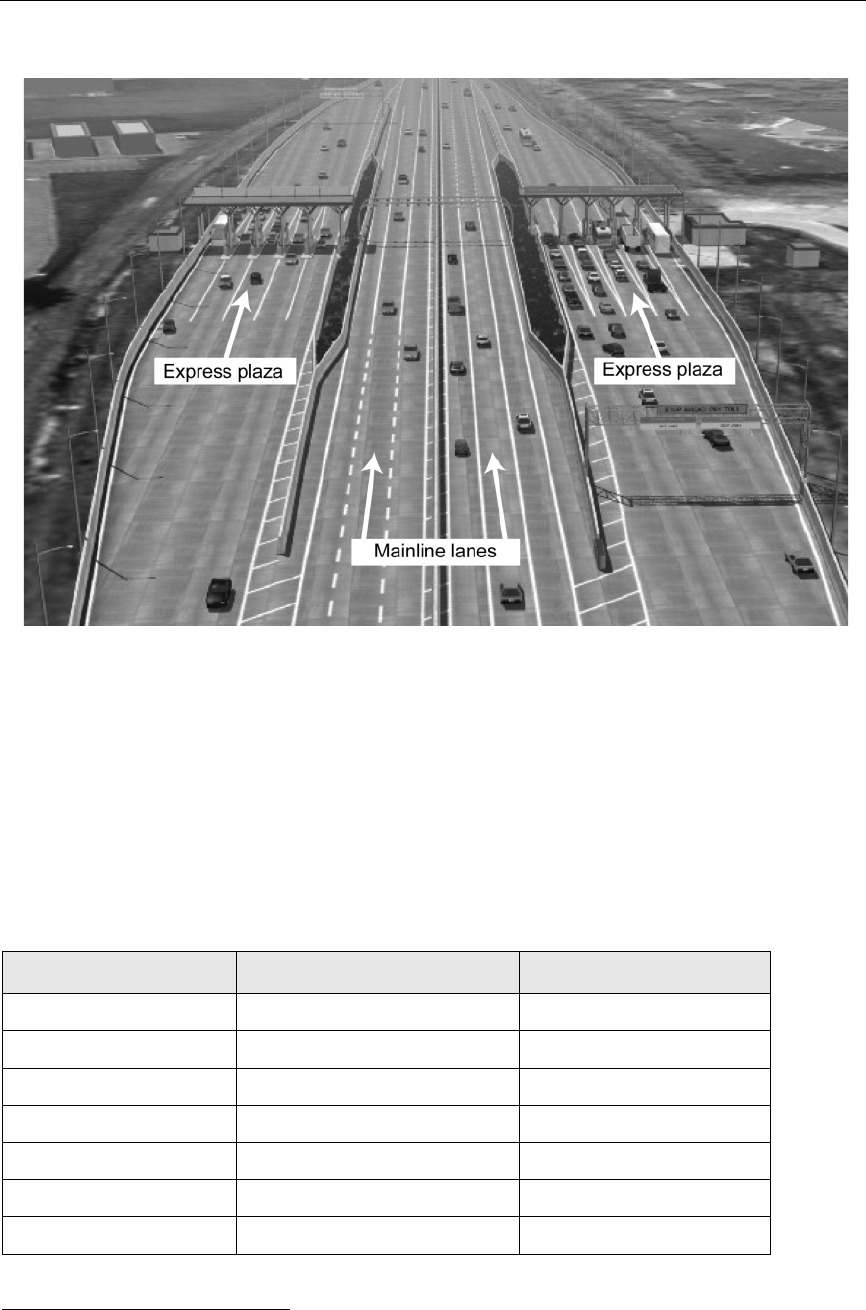
Factual Information 31 Highway Accident Report
Rumble strips were originally in place at every mainline toll plaza on I-90; ISTHA
started removing the strips in 1987 and 1988 because of pavement and resurfacing
projects and noise complaints from residential neighborhoods adjacent to the toll
highway.
56
As a result of the accident, ISTHA began reinstalling rumble strips at several
mainline plazas on I-90, including those at Belvidere, Hampshire–Marengo, and Elgin.
Currently, seven mainline plazas on the ISTHA system have rumble strips. (See table 8.)
Table 8. Current rumble strip locations on ISTHA tollway system.
Figure 16. Graphic depiction of open road toll system.
(Courtesy of Illinois State Toll Highway
Authority)
56
Telephone communication with ISTHA manager of maintenance and traffic, December 30, 2005.
Tollway section Mainline tollbooth plaza Traffic direction
Northwest South Beloit (plaza 1) Both
Northwest Belvidere (plaza 5) Both
Northwest Hampshire–Marengo (plaza 7) Both
Northwest Elgin (plaza 9) Eastbound only
East-west DeKalb (plaza 66) Both
East-west Dixon (plaza 69) Both
Tristate Waukegan (plaza 21) Both

Factual Information 32 Highway Accident Report
Meteorological Information
The National Weather Service at DeKalb-Taylor Municipal Airport, 21 miles south
of the accident site, reported the weather at 3:00 p.m. on October 1, 2003, as mostly sunny
and clear, with a temperature of 50 degrees Fahrenheit, 23 percent humidity, and winds
northwest at 15 mph.
Toxicological Information
Toxicological specimens were collected from the Freightliner driver at a local
hospital following the accident. The ISP laboratory tested the specimens and found the
driver’s blood and urine to be negative for alcohol and other drugs of abuse. The Safety
Board also had the specimens tested
57
and determined that no carbon monoxide, cyanide,
ethanol, or other drugs were present.
Toxicological specimens were collected from the bus driver 2 days after the
accident, on October 3, 2003. The specimens were evaluated locally and were found to be
negative for drugs of abuse. No alcohol testing was conducted. According to 49 CFR
382.303, the employer of a driver of a commercial motor vehicle operating on a public
road in commerce is required to conduct alcohol and controlled substance testing on that
driver if the vehicle is involved in a fatal accident. Safety Board investigators found no
evidence that Leisure completed any postaccident alcohol testing on the bus driver, as
required.
Tests and Research
Specialty Bus Tail Lights
The left and right tail light assemblies from the specialty bus were sent to the
Safety Board’s materials laboratory for examination, which revealed the identification
“CEC 1157” on the base of the right tail light bulb. According to a representative of
General Electric, a manufacturer of type 1157 bulbs, only one filament is used when the
tail lights are on, and both filaments are used when the brakes are applied. Examination of
the filaments within the right tail light bulb revealed that both were severely stretched and
deformed, consistent with their being hot at the moment of impact. Stretched and
deformed filaments indicate that the brakes were applied at impact.
57
The specimens were tested at the Federal Aviation Administration Civil Aeromedical Institute
toxicology laboratory for a wide range of licit and illicit substances, including amphetamines, opiates,
marijuana, antihistamines, meprobamate, methaqualone, and nicotine.
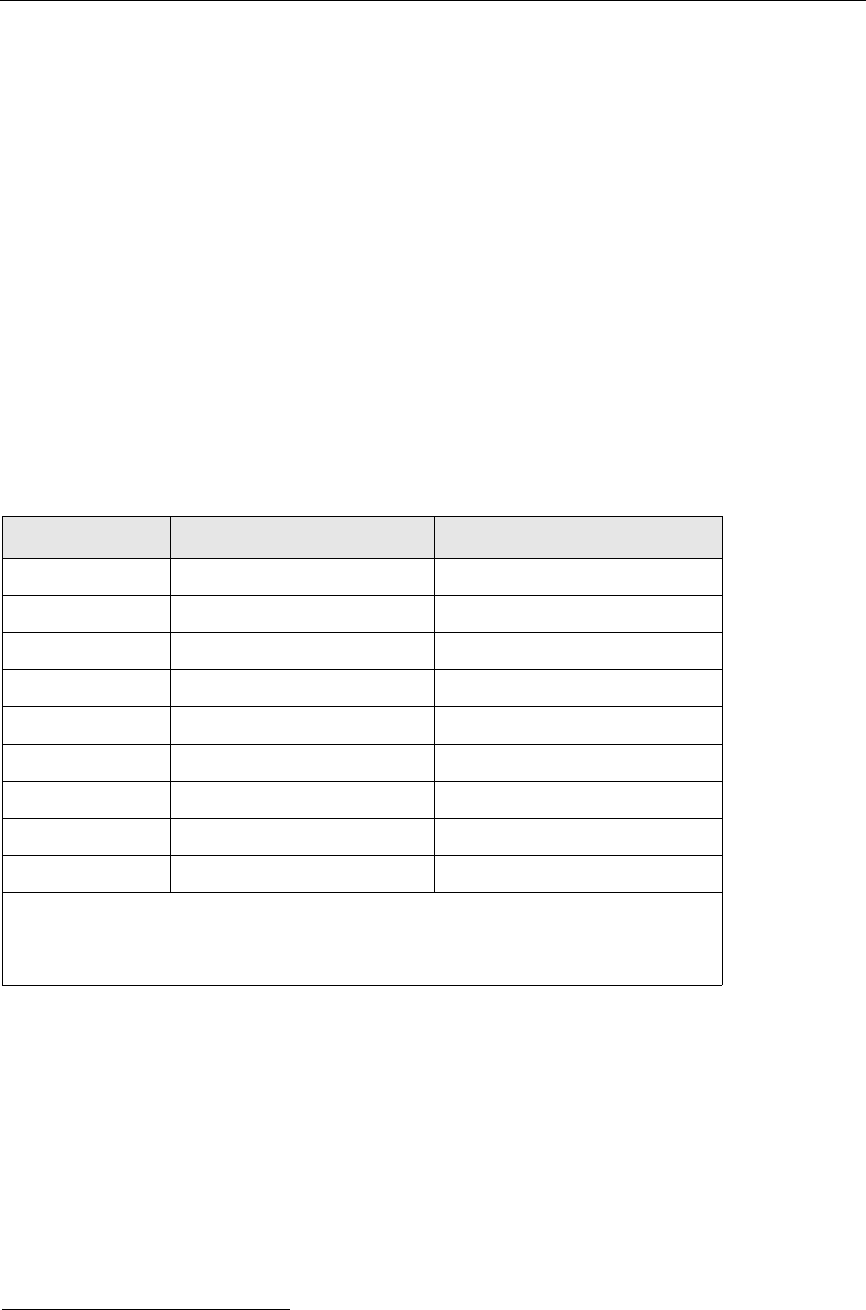
Factual Information 33 Highway Accident Report
Examination of the filaments within the left tail light bulb revealed that one
filament was stretched and deformed, though not as severely as the filaments within the
right tail light bulb.
58
The second filament in the left tail light bulb did not display
significant stretching or deformation.
Freightliner Gear Speed Calculations
The maximum rpm setting on the Freightliner tractor engine was read out through
the engine’s ECM as 2,030. The gear ratio of the Dana Spicer DS402 drive axle was 4.11.
The rpm of the tires on both the tractor and trailer (size 295/75R22.5) was 518. Using this
information, the Safety Board calculated various speeds for each transmission gear of the
Freightliner tractor. (See table 9.) According to the ISP report, the Freightliner driver
stated that his tractor was in eighth gear at the time of the accident. The driver also stated
that he was following the specialty bus in the right lane at a speed of 40 to 45 mph. The
posted speed limit in the work zone where the accident occurred was 45 mph.
Table 9. Freightliner gear speed calculations.
Forensic Evidence Documentation and Accident Simulation
Physical evidence found on the roadway included scrapes and gouges consistent
with similar evidence found on the undercarriage of the specialty bus. Curved tire marks
that varied in radius from 227 to 491 feet and had striations running perpendicular to the
direction of travel were also found on the roadway. The tire marks traveled from the right
lane to the left lane and terminated at the center median, where 113-foot-long tire furrows
ran to the final rest position of the Freightliner tractor-trailer. Subsequent to the on-scene
58
The lens on the left tail light was of a different style than the right tail light.
Gear
A
Transmission gear ratio Gear speed range (mph)
B
1 12.57 0–4.55
2 7.47 4.56–7.66
3 5.28 7.67–10.84
4 3.83 10.85–14.94
5 2.79 14.95–20.51
6 1.95 20.52–29.34
7 1.38 29.35–41.46
8 1.00 41.47–57.21
9 0.73 57.22–78.37
A
For each gear, the maximum engine rpm was 2,030, the tire rpm was 518, and the drive axle
gear ratio was 4.11.
B
Calculation: 60 times the maximum engine rpm (2,030), divided by the sum of the drive axle gear
ratio (4.11), multiplied by the transmission gear ratio, multiplied by the tire rpm (518).

Factual Information 34 Highway Accident Report
investigation, faint straight tire marks, 38 feet long, were observed in ISP photographs;
these straight tire marks preceded the curved tire marks.
One set of additional tire marks, 197 feet long, was located in the right lane,
terminating at the final rest position of the Kenworth tractor-tank trailer; and two sets of
tire marks—one 20 feet long, the other 113 feet long—were also located in the right lane,
terminating in the vicinity of the Kenworth tractor-tank trailer.
The Safety Board staff conducted simulations
59
of the accident to determine the
speeds of the specialty bus, pickup truck, and Ford tractor-box trailer as they were
approaching the Hampshire–Marengo toll plaza relative to the speeds of the approaching
Freightliner and Kenworth tractor-trailers. (See table 10.) The simulations used physical
evidence and data collected on scene, including tire marks, points of impact between the
vehicles, final rest positions, and data from the pickup’s SDM. After the accident, Safety
Board investigators interviewed the drivers of the accident vehicles and obtained their
estimated speeds prior to the collision.
Table 10. Driver-estimated preaccident speeds and simulation preaccident speed
comparison.
Based on the SDM data and other physical evidence, several scenarios were
identified and evaluated. The results of the simulations that most closely matched the
physical evidence indicate that the vehicles at the front of the accident queue—the
specialty bus, the pickup truck, and the Ford tractor-box trailer—were traveling at
substantially lower speeds (0 to 10 mph) than the Freightliner tractor-trailer (50 mph) and
the Kenworth tractor-tank trailer (55 to 62 mph), which were approaching from the rear.
(See figure 17.)
59
Software used for the simulations included the Human Vehicle Environment (HVE) system,
Simulation Model Nonlinear (SIMON), ReadDataFile by Collision Engineering Associates, Inc.,
Engineering Dynamics Corporation General Analysis Tool (EDGEN), Engineering Dynamics Corporation
Simulation of Automobile Collisions (EDSMAC4), and Autocad and Viewpoint models by Digimation, Inc.
Vehicle
Driver’s stated speed prior
to collision (mph)
Preaccident speed
simulation results
Freightliner tractor-trailer (vehicle 1) 40–45 50
Specialty bus (vehicle 2) 10 10
Pickup truck (vehicle 3) 50 3
Ford tractor-box trailer (vehicle 4) 30–35 0–3
Kenworth tractor-tank trailer (vehicle 5) 62 (had begun braking) 55–62
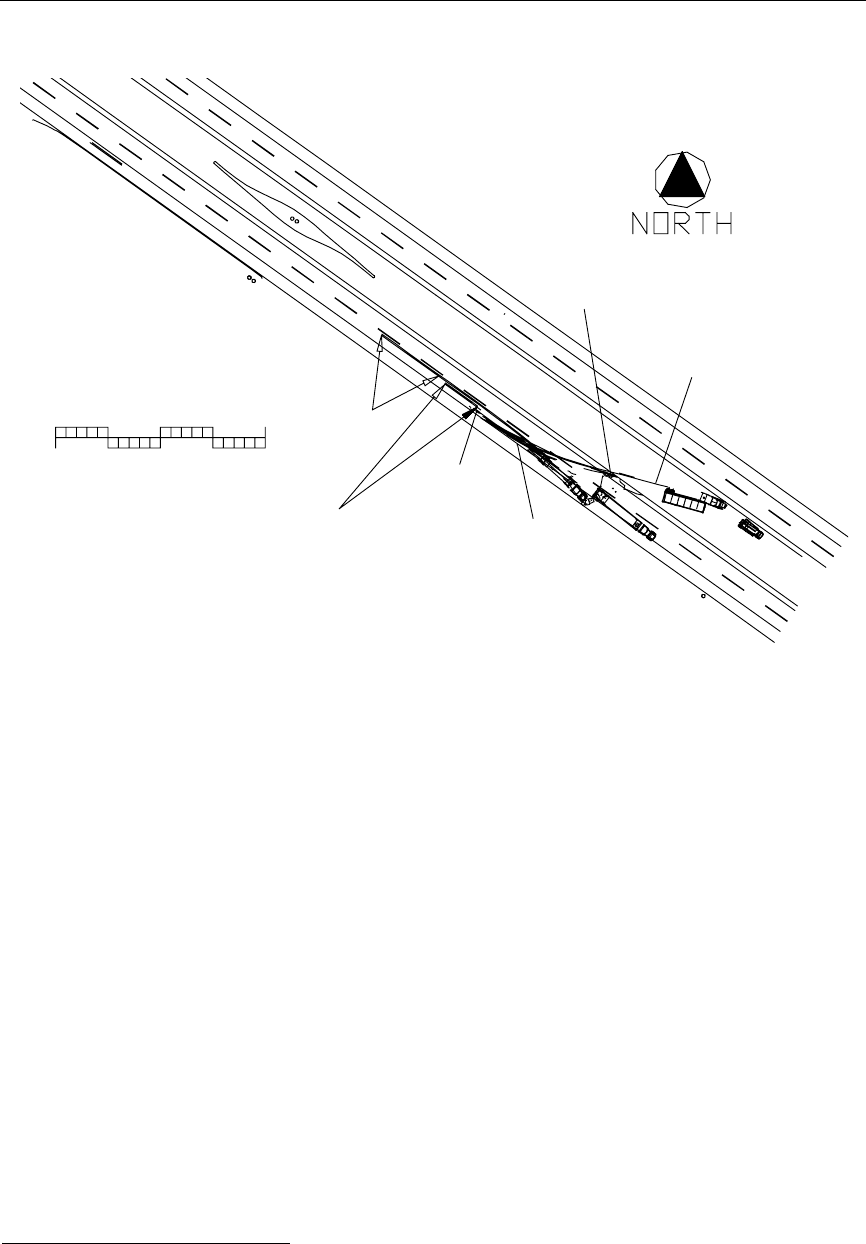
Factual Information 35 Highway Accident Report
The simulations indicated that the Freightliner tractor-trailer was traveling about
50 mph, slightly above the driver’s estimated speed of 40 to 45 mph, prior to striking the
rear of the specialty bus. The simulations showed that the specialty bus was traveling
about 10 mph, the bus driver’s estimated speed, as it approached the toll plaza behind a
pickup truck that was traveling about 3 mph
60
(the pickup truck driver recalled that he had
been traveling 50 mph before the accident). The simulations showed the Ford tractor-box
trailer traveling 0 to 3 mph in front of the pickup truck, with a maximum potential speed of
20 mph (the driver had reported traveling 30 to 35 mph before the accident). The
simulations also indicated that the driver of the final striking vehicle—the Kenworth
tractor-tank trailer—was traveling about 62 mph before applying his brakes and
subsequently striking the pickup truck and the Ford tractor-box trailer.
As the “bullet” vehicle, the Freightliner tractor-trailer (vehicle 1) was the first
striking vehicle into the rear of the secondary target vehicle, the specialty bus (vehicle 2).
As shown in table 10, the simulation results indicate a significant difference in speed
between the vehicles at the front of the accident (vehicles 2, 3, and 4), which were
traveling from 0 to 10 mph, and vehicles 1 and 5, which were approaching from the rear at
Figure 17. Accident scene diagram indicating physical evidence.
60
The pickup truck’s SDM indicated that the vehicle was traveling 3 mph for 3 seconds and then less
than 1 second later underwent a negative (rearward) change in velocity (delta-v) of at least 13.77 mph.
Vehicle speed data were sampled at 1-second intervals beginning 5 seconds prior to the collisions that
resulted in the rearward delta-v. See appendix C for further explanation of SDM data.
I-90
Westbound
I-90
Eastbound
Gouge and
scrape marks
Furrow and
plow marks
Gouge and
scrape marks
Location of tire
marks identified
in ISP photograph
Curved
tire marks
Tire
marks
Center median
Milepost
41.5
0 50 100 150 200
Scale in feet

Factual Information 36 Highway Accident Report
speeds of 50 to 62 mph. The simulations also indicate that vehicles 2, 3, and 4 were
traveling at speeds well below the posted 45-mph speed limit as they approached the toll
plaza and manual cash lane queue.
In addition, the physical evidence and the simulation results showed the following:
• Traveling approximately 50 mph, the Freightliner tractor-trailer struck the
specialty bus, which was traveling about 10 mph. (See figure 18.)
• Following the collision, as the specialty bus was moving about 40 mph, its
right front door area contacted the left rear corner of the pickup truck, which
was traveling about 3 mph. (See figure 19.)
• The collision with the pickup truck pushed it forward; and within less than 1
second, the front of the pickup truck struck the rear of the Ford tractor-box
trailer, which was traveling 0 to 3 mph.
61
(See figure 20.)
• As the Freightliner and the specialty bus veered toward the center median, the
Freightliner’s trailer rolled onto the bed-mounted camper of the pickup truck
and then onto the rear upper left corner of the Ford box trailer. (See figure 21.)
• The Freightliner and the specialty bus continued toward the median; the
Freightliner trailer overturned in the left lane, while the tractor remained
upright. Both vehicles then entered the median and came to rest.
• Meanwhile, a trailing vehicle—the Kenworth tractor-tank trailer—struck the
pickup truck, which had already been in contact with the rear of the Ford
tractor-box trailer from its initial impact and partial rotation, and pushed the
pickup truck and the Ford combination unit to their final rest positions. (See
figures 22 and 23.)
61
As indicated by the simulation results, the speed of the Ford tractor-box trailer was substantially
slower than the 30 to 35 mph reported by the driver. The simulations showed that if this vehicle had been
traveling any faster than 10 mph, the pickup truck would not have been able to “speed up” during the
collision in time to make contact with the rear of the trailer; the trailer’s speed, if 30 to 35 mph, would have
moved it forward, away from the slower vehicles colliding behind it.
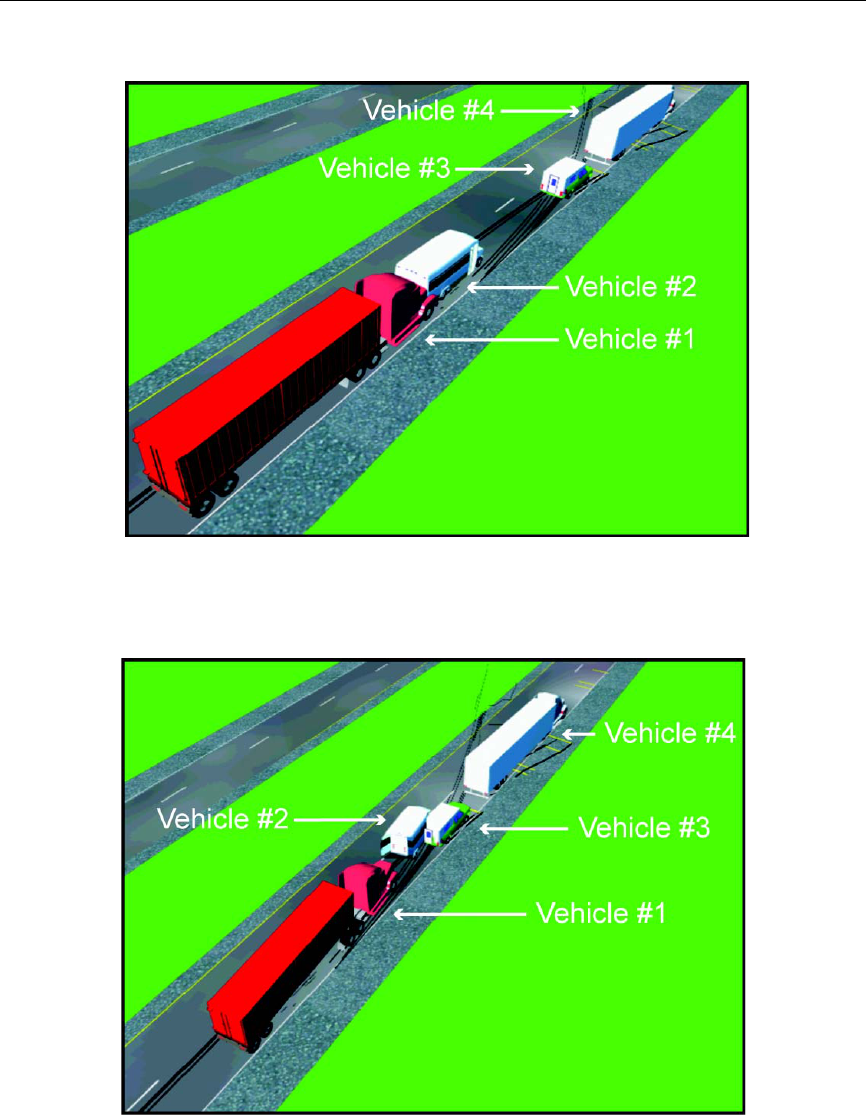
Factual Information 37 Highway Accident Report
Figure 18. Freightliner tractor-trailer strikes specialty bus.
Figure 19. Specialty bus contacts left rear corner of pickup truck.
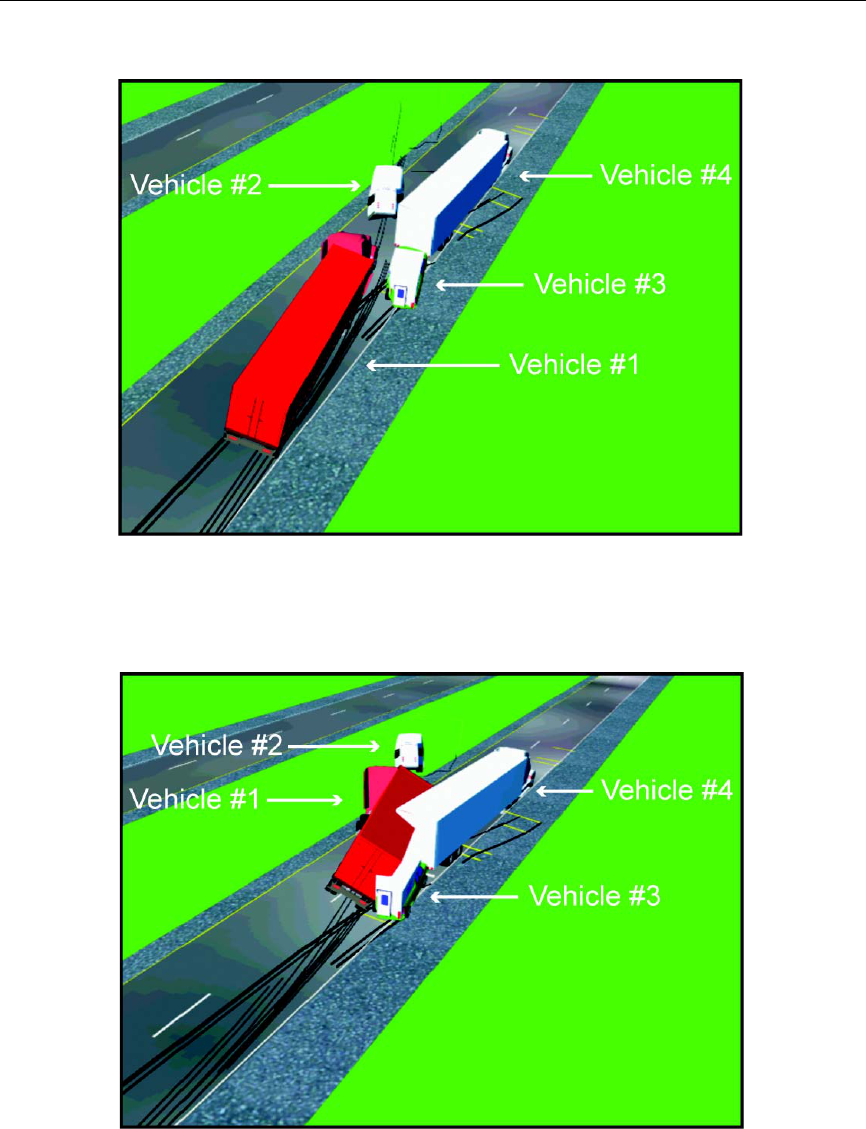
Factual Information 38 Highway Accident Report
Figure 20. Pickup truck, pushed forward, strikes Ford tractor-
box trailer.
Figure 21. Freightliner trailer rolls onto pickup truck camper and
box trailer.

Factual Information 39 Highway Accident Report
Figure 22. Freightliner and specialty bus come to rest in median
and Kenworth tractor-tank trailer strikes pickup truck, already in
contact with box trailer.
Figure 23. Final rest positions of all five vehicles.

Factual Information 40 Highway Accident Report
Other Information
Toll Roads
Accident Statistics. According to FHWA estimates, the United States has 4,927
miles of toll roads, compared to 46,334 miles of interstate highway and 9,213 miles of
urban freeways and expressways. Toll roads constitute approximately 9 percent of the
motorway-standard mileage. Mileage and accident data by vehicle type are routinely
collected on ticket-controlled segments of many toll roads; these tickets distinguish
between commercial and passenger motor vehicles and document miles traveled.
A 2002 study reported that, on most toll roads, tractor-trailers and other
commercial vehicles were involved in more multivehicle accidents than passenger cars.
62
In Illinois, commercial vehicles were 57 percent more likely to be in a multivehicle
accident than a passenger car. The study concluded that the difference in accident rates
between large commercial motor vehicles and passenger vehicles appeared to depend on
type of collision, specific toll road, and traffic density.
63
Rear-end accidents and
sideswipes were the two most common types of collisions among commercial motor
vehicles. Rear-end accidents accounted for about 30 percent of all collisions, regardless of
vehicle type. From 1998–2002, the rear-end accident rate within a 5-mile radius of the
Hampshire–Marengo toll plaza averaged approximately 40 percent, exceeding any other
type of collision, including sideswipes (at approximately 20 percent). In 2002, the rear-
end accident rate on the entire ISTHA toll system was 49.6 percent.
64
Also in 2002, the
Pennsylvania Turnpike and the New Jersey Turnpike recorded rear-end accident rates
within a 1-mile radius of mainline plazas at 30.2 percent and 37.8 percent, respectively.
65,66
Electronic Toll Collection and Open Road Tolling. ETC uses electronic
equipment instead of manual cash collection or automatic coin machine collection. By
means of automatic vehicle identification technology, customers subscribe to a program
that allows their vehicle to be automatically identified in a toll lane by an electronic
transponder. If the customer does not have an electronic transponder, a camera digitally
photographs the license plate, and the registered owner is subsequently billed for the
trip—or, if a cash lane was available, the customer is ticketed or fined for failure to pay the
toll. Benefits of ETC include reduced staffing levels (compared to manually collecting
tolls), increased throughput of vehicles, and reduced operating costs.
67
The number of toll
62
Elisa R. Braver, Mark G. Solomon, and David S. Preusser, “Toll Road Crashes of Commercial and
Passenger Motor Vehicles,” Accident Analysis and Prevention, Vol. 34 (2002): 293–303.
63
Insurance Institute for Highway Safety, “Commercial and Passenger Motor Vehicle Crashes on Toll
Roads,” IIHS Status Report, Vol. 34, No. 7 (1999): 4–5.
64
Wilbur Smith Associates, 2000–2002 Traffic Crash Data Report for the Illinois State Toll Highway
Authority (Chicago, IL: 2003), 2–8.
65
E-mail correspondence from traffic engineering manager, Pennsylvania Turnpike Commission,
January 16, 2004.
66
E-mail correspondence from director of operations, New Jersey Turnpike Authority, January 20, 2004.
67
University of South Florida–Florida Department of Transportation, Center for Urban Transportation
Research, Feasibility of Open Road Tolling in Florida (Tampa, FL: USF–Florida DOT, 2001) 10–11.

Factual Information 41 Highway Accident Report
facilities with electronic technology has increased from 49 in 1995 to about 160 in 2003.
68
From 1989 until 2004, the proportion of tolls collected by ETC had increased from 0 to 50
percent or more at almost all U.S. toll facilities. A 1996 study determined that a manual
lane processes 300 to 500 vehicles per hour, and an automated coin lane processes 600 to
900 vehicles per hour.
69
A dedicated automated vehicle identification lane can average
1,000 to 1,500 vehicles per hour.
The definition of ORT varies among toll authorities. For example, the Florida
Turnpike Enterprise defines ORT as a method and system of collecting tolls on
expressways and other facilities that essentially involves no toll collectors in traditional
toll booths,
70
and ISTHA defines ORT as a method of collecting tolls electronically while
driving nonstop at posted highway speeds.
71
Generally, ORT refers to a toll collection
scenario in which vehicles are identified electronically instead of having to stop for
manual payment of a toll.
Proponents of ETC and ORT cite reduced congestion, reduced accident rates,
improved fuel economy, and reduced pollution as benefits.
72
Cash-paying toll traffic now
constitutes the minority traffic segment.
73
Some toll roads provide nonstop travel in lanes
adjacent to the median for ETC or ORT customers, while requiring cash-paying customers
to exit the mainline toll highway to the right and pay tolls at express plazas located along
the sides of the highway. Some States with ORT currently in use, or planned, are Florida
(Florida Turnpike, Orlando–Orange County Expressway, Miami–Dade County
Expressway), New Jersey (Garden State Parkway, New Jersey Turnpike), Colorado (E-470
Beltway, Northwest Parkway), Texas (Dallas North Tollway), Illinois (Illinois Toll
Highway System), Virginia (Pocahontas Parkway), Pennsylvania (Pennsylvania
Turnpike), and California (Transportation Corridor Agency).
74
In July 2003, the Florida DOT completed a case study of a conventional mainline
barrier toll plaza renovation on the Orlando–Orange County Expressway that included
ORT.
75
Prior to renovation, the plaza was operated during normal conditions (nonpeak
traffic hours) with four lanes in each direction—two manual cash lanes, one automatic
coin machine lane, and one dedicated ETC lane. The ETC lane was located to the left of
68
U.S. Department of Transportation, Federal Highway Administration, Toll Facilities in the United
States: Bridges–Roads–Tunnels–Ferries, FHWA-PL-03-017 (Washington, DC: FHWA, 2003) 4–7.
69
Intelligent Transportation Systems Society of Canada, Electronic Toll Collection (Toronto, Ontario:
SRI Consulting, 1996). See <www.itscanada.ca/english/2reps2e.htm>, January 31, 2006.
70
Feasibility of Open Road Tolling in Florida, 10–11.
71
Open Roads for a Faster Future, 5.
72
Electronic Toll Collection.
73
U.S. Department of Transportation, Federal Highway Administration, Developing Traffic Control
Strategies: Geometric and Safety Design, Plaza Operations and Toll Lane Configurations (Washington, DC:
FHWA, 2005) 4.
74
Data obtained from deputy program director, Post, Buckley, Schuh & Jernigan, consultants to the
Florida Turnpike Enterprise, Florida DOT, September 14, 2005.
75
Data obtained from Post, Buckley, Schuh & Jernigan, consultants to the Orlando–Orange County
Expressway Authority, Florida DOT, September 19, 2005.

Factual Information 42 Highway Accident Report
the other three lanes and had a speed limit of 35 mph. Renovation included demolishing
the middle lanes of the barrier plaza to incorporate four lanes of express ETC. The lanes
were elevated to permit a 70-mph speed limit and were separated from the coin machine
lanes by a barrier. Postconstruction, the plaza configuration consisted of six toll lanes per
direction—two manual cash lanes and two coin machine lanes to the right and two express
ETC lanes to the left. The rear-end accident rate at this location declined from
27 accidents prerenovation (1 year before construction)
76
to 12 accidents postrenovation
(1 year after construction).
77
In 1999, ISTHA converted two mainline barrier toll plazas on the I-355
North/South Tollway in Chicago to ORT plazas. The Boughton Road plaza renovation
was completed in February of that year, and the Army Trail Road plaza was completed in
December. Prior to construction of the ORT lanes, both plazas operated with six toll lanes
in each direction—three manual cash lanes and three automatic coin machine lanes. The
renovation involved widening the plaza to accommodate four express ETC lanes in the
median. A barrier separated these lanes from the automatic coin machine lanes. The final
plaza configurations consist of eight toll lanes in each direction—three manual cash lanes
on the right, three automatic coin lanes in the middle, and two express ETC lanes on the
left. Prior to renovation of the Army Trail Road plaza, the average daily traffic was 7,150
vehicles per hour in both directions; after renovation, the traffic volume increased to
10,600 vehicles per hour. Prior to renovation of the Boughton Road plaza, the average
daily traffic was 6,500 vehicles per hour in both directions; after renovation, the traffic
volume increased to 9,800 vehicles per hour. The rear-end accident rate at each plaza
declined following renovation.
78
(See table 11.)
Table 11. Rear-end accidents at two I-355 North/South Tollway plazas, pre- and post-
ORT renovation.
Toll Plaza Design.
Several factors are considered in toll plaza design, such as
proposed location on the roadway, right-of-way, traffic demand, method of toll collection,
infrastructure, and approach and departure geometrics. Other factors taken into account
76
February 1, 2001, through January 31, 2002.
77
August 1, 2003, through July 31, 2004.
78
Data obtained from Wilbur Smith and Associates, consultant to the ISTHA, September 22, 2005.
Year
Number of accidents
(Army Trail Road)
Number of accidents
(Boughton Road)
Time frame
1996
34 31 2 yr prerenovation
1997
56 34 1 yr prerenovation
2000
15 20 1 yr postrenovation
2001
12 14 2 yr postrenovation

Factual Information 43 Highway Accident Report
include violation enforcement, environmental issues (water, air, noise, and lighting),
budget, staffing, safety, and capacity options; these factors can vary considerably across
toll plazas.
79
American Association of State Highway and Transportation Officials
AASHTO is a nonprofit, nonpartisan association founded in 1914 as the American
Association of State Highway Officials. It represents highway and transportation
departments in the 50 States, the District of Columbia, and Puerto Rico. The association’s
mission is to advocate transportation-related policies and to provide technical services to
support States in efficiently and safely moving people and goods.
80
AASHTO also publishes the guidance for highway geometric design in its book, A
Policy on Geometric Design of Highways and Streets,
81
commonly known as the “Green
Book.” An FHWA office memorandum dated February 23, 2005, established that the fifth
edition (2004) of the AASHTO Green Book “should be applied as the design standard for
all projects on the National Highway System (NHS).”
82,83
The Green Book is the basis for
the geometric design standards of most transportation agencies.
84
The fifth edition of the
Green Book contains no guidance on the design of toll plazas or dedicated lanes.
According to FHWA staff,
85
the Green Book will be updated in 2007 or 2008, a process
that entails extensive research and data analysis. One approach to provide the research and
analysis required for an update is the development of written AASHTO guidelines on
particular research subjects.
Federal Highway Administration
As established in 23 CFR Part 655, Subpart F, the FHWA administrator approves
the MUTCD as the national standard for all traffic control devices installed on any street,
highway, or bicycle trail open to public travel in accordance with 23 U.S.C. 109(d) and
402(a). The MUTCD contains the design, application, and placement standards for all
traffic control devices and is the standard used by State and local transportation
professionals in selecting, installing, and maintaining such devices.
86
The current edition
of the MUTCD (2003, with Revision No. 1) contains no guidance on the design of toll
plazas or the use of dedicated lanes.
79
Developing Traffic Control Strategies: Geometric and Safety Design, Plaza Operations and Toll
Lane Configuration, 1.
80
See <www.transportation.org/?siteid=37&pageid=330>, February 24, 2006.
81
American Association of State Highway and Transportation Officials, A Policy on Geometric Design
of Highways and Streets, 5th ed. (Washington, DC: AASHTO, 2004).
82
See <www.fhwa.dot.gov/programadmin/022305.cfm>, January 9, 2006.
83
AASHTO established the National Highway Task Force in December 1988 to look beyond interstate
completion; the board of directors recommended the creation of a National Highway System. The NHS
Designation Act was enacted in November 1995.
84
Transportation Research Board of the National Academies, National Cooperative Highway Research
Program, Leveraging Resources for Better Transportation (Washington, DC: TRB, 2005) 11.
85
Information obtained from Office of Program Administration, FHWA, November 2, 2005.
86
Traffic control devices include signs, signals, and pavement markings used to guide or warn road users.

Factual Information 44 Highway Accident Report
In January 2003, the FHWA met with representatives of the International Bridge,
Tunnel and Turnpike Association (IBTTA)
87
to begin discussing how to achieve
uniformity, efficient traffic flow, and improved safety at toll plazas. The FHWA and
IBTTA agreed to pursue the goal of developing a compendium of best practices and
control strategies for handling traffic within these complex roadway environments. In
January 2004, the FHWA initiated a contract study to identify and define current practices,
to develop guidelines based on multiple sources of information, to achieve consensus
among toll agencies, and to determine possible MUTCD language for traffic control
devices at toll plazas. The study is expected to result in a consistent national traffic control
strategy for toll plazas, enhanced plaza safety and operations, and improved driver
comprehension and reaction at toll plazas.
The study results are to be published in a report entitled State of the Practice and
Recommendations on Traffic Control Strategies at Tollbooth Plazas, which is planned for
completion and distribution by summer 2006.
88
The FHWA does not expect operating
agencies to immediately adopt all recommendations and convert existing plazas. Rather, it
advises that the recommendations be seriously considered for future facility retrofits or
reconstructions, as well as any new construction.
The FHWA anticipates including information from the traffic control strategies
report, such as language about express ETC lanes, in the next edition of the MUTCD.
89
No
date has been set for publication of a revised MUTCD. Once funding has been obligated,
the rulemaking activities associated with publishing a new edition can begin; this process
generally takes about 3 years.
International Toll Roads
Several fully automated toll roads, with no toll booths or plazas, are already in
operation around the world. Toronto’s highway 407, which runs 65 miles east–west just
north of the city, is one of the world’s first open-access, all-electronic toll highways. It
opened in October 1997. Transponders are required for all commercial vehicles. The
entrances and exits of nontransponder-equipped, noncommercial vehicles are recorded via
license plate optical character recognition high-speed cameras; customers’ addresses are
obtained through the Canadian motor vehicle department, and the users are billed
directly.
90
In Norway, drivers entering the city of Oslo have been paying tolls via an ETC
system since 1990. In France, Italy, and Portugal—which have established freeway tolling
infrastructures—the decision to implement ETC is made by toll authorities, primarily as
an aid to reducing operating costs, increasing toll revenue, and providing improved
87
According to IBTTA, the association is a worldwide alliance of toll operators and associated
industries that provides a forum for sharing knowledge and ideas to promote and enhance toll-financed
transportation services. IBTTA has 280 members in 24 countries. See <www.ibtta.org>, March 7, 2006.
88
E-mail correspondence from Office of Transportation Operations, FHWA, October 12, 2005.
89
E-mail correspondence from Office of Transportation Operations, FHWA, October 12, 2005.
90
See <www.roadtraffic-technology.com/projects/407>, January 31, 2006.

Factual Information 45 Highway Accident Report
customer service.
91
In Mexico, in addition to limited ETC installations on selected
portions of the roadway system running between Tijuana and Guatemala, interest is
growing in the installation of electronic systems at border crossings between Mexico and
the States of California and Texas.
92
In Australia, toll roads can be found in the cities of
Brisbane, Sydney, and Melbourne. CityLink is a tolled freeway system in Melbourne on
which tolls are collected electronically by e-TAG, and there are no toll booths along the
entire length of the system. In the Philippines, on the main island of Luzon, the 84-
kilometer North Luzon expressway uses ETC.
93
Safe, Accountable, Flexible, Efficient Transportation Equity Act
The Safe, Accountable, Flexible, Efficient Transportation Equity Act: A Legacy
for Users (SAFETEA-LU) was signed by the President on August 10, 2005, and provides
over $201 billion in funding for highway and safety programs and nearly $46 billion for
public transportation from FYs 2005–2009. These programs include toll road safety
research and motor carrier oversight.
Passenger Carrier Roadside Inspections. The motor carrier safety grants
provisions under SAFETEA-LU amend the State Plan Contents section of 49 U.S.C.
Section 31102(b)(1) to include language that (except in the event of imminent danger or
obvious safety hazards) prohibits the inspection of a vehicle transporting passengers for a
motor carrier of passengers unless the inspection is conducted at a station, terminal, border
crossing, maintenance facility, destination, or other location where a motor carrier may
make a planned stop.
Toll Road Safety. The toll provisions under SAFETEA-LU require the Secretary
of Transportation to conduct a study of the safety of highway toll collection facilities,
including toll booths. The act requires consideration of (1) the effect of design or
construction of facilities on the likelihood of vehicle collisions with the facilities; (2) the
safety of crosswalks used by toll collectors in transit to and from toll booths; (3) the extent
of the enforcement of speed limits in the vicinity of facilities; (4) the use of warning
devices, such as vibration and rumble strips, to alert approaching drivers; (5) the law
enforcement practices and jurisdictional issues that affect safety in the vicinity of
facilities; and (6) the incidence of accidents and injuries in the vicinity of toll booths. (See
appendix E.)
Intermodal Equipment Oversight. The roadability
94
provisions under
SAFETEA-LU that relate to the inspection, repair, and maintenance of intermodal
equipment require the Secretary of Transportation, within 1 year, to issue regulations
91
See <www.itscanada.ca/english/2res2e.htm>, January 31, 2006.
92
See <www.itscanada.ca/english/2res2e.htm>, January 31, 2006.
93
See <en.wikipedia.org/wiki/Toll_road>, January 31, 2006.
94
Typically, the term “roadability” is defined as the ability of a motor vehicle to maintain a steady,
balanced, and comfortable ride, especially under a variety of road conditions. For motor carrier safety, it is
viewed as the roadworthiness of the vehicle—that is, whether the vehicle meets certain systems
requirements to safely operate on the Nation’s highways.

Factual Information 46 Highway Accident Report
establishing a program to ensure that equipment used to transport intermodal containers is
safe and systemically maintained. In the United States, intermodal chassis are used to
transport cargo valued at more than $450 billion annually.
95
Cargo containers hauled by
rail and shipping companies are regularly transferred to trucks before final delivery. Most
chassis are not owned by trucking companies and are not included as part of the existing
compliance review process for truck operators. Data collected by the FMCSA suggest that
trucks hauling intermodal equipment receive OOS notices more frequently than heavy
trucks in general. Intermodal equipment providers own 750,000 chassis nationwide, which
handled more than 20 million container movements in 2002.
96
(See appendix E.)
State Vehicle Codes for Intermodal Trailer, Chassis, and Safety
Four States—California, South Carolina, Louisiana, and Illinois—have State laws
under which an intrastate intermodal chassis, trailer, or container owner is responsible for
the maintenance and condition of equipment. In Illinois, the law became effective in July
2000 and prohibits the interchange of intermodal equipment in violation of FMCSRs. (See
appendix F for the full text.) The Illinois law gives the owner of the equipment
responsibility for its upkeep and requires the owner to reimburse truckers for any fines,
penalties, or repair costs incurred because of defects specified by the law. Violations may
result in fines of up to $500. The law, codified in 625 Illinois Compiled Statutes 5/18b–
112(b), states, in part:
It is the responsibility of the equipment provider to inspect and, if a vehicle at the
time of inspection does not comply with all federal motor carrier safety regulation
requirements, perform the necessary repairs on all vehicles prior to interchange or
offering for interchange.
Vehicle Incompatibility and Heavy Truck Aggressivity
Vehicle incompatibility is defined as design differences among vehicle types that
result in disproportionate damage patterns following a collision. These differences include
weight, stiffness, and geometry aspects.
97
If any of these factors vary significantly
between two impacting vehicles, the vehicles will not be compatible in a collision. One
vehicle will probably absorb more of the impact energy, either through crush or large
accelerations, while the other vehicle is considered to have high aggressivity.
“Crashworthiness” refers to how well a vehicle protects its occupants in an
accident. This protection involves aspects such as the crash behavior of structures and
materials and impact biomechanics. Crashworthiness is a function of the compatibility of
the impacting vehicles and the methods of energy management for occupant protection,
among other factors.
95
National Highway Traffic Safety Administration, January 26, 2004, press release (Washington, DC:
NHTSA, 2004).
96
Alan M. Robinson, Intermodal Truck Equipment Safety: Legislation in the 108th Congress,
Congressional Research Service (Washington, DC: CRS, May 6, 2004) 1–3.
97
S. Acierno and others, “Vehicle Mismatch: Injury Patterns and Severity,” Accident Analysis and
Prevention, Vol. 36 (2004): 761.

Factual Information 47 Highway Accident Report
In April 2000, the 21st Century Truck Program was announced at a gathering of
U.S. truck and supporting industries, environmentalists, and Federal agency
representatives, including the U.S. Department of Energy (DOE) and the DOT. This
multiagency and industry partnership released a “roadmap” for developing a viable
technology for the improvement of safety in the Nation’s trucking industry.
98
One of the
program’s many goals and research objectives is to improve truck and bus safety by
fostering advancements in vehicle design and performance, such as reducing truck frontal
aggressivity in multivehicle collisions.
99
According to the roadmap, the milestone for
improving crashworthiness—including the completion of laboratory tests and field trials
of systems to reduce the destructive effects of accidents—is mid-2009.
100
98
See <www.dieselnet.com/news/2001/01doe2.php>, January 31, 2006.
99
See <www.eere.energy.gov/vehiclesandfuels/pdfs/program/21ct_roadmap.pdf>, January 31, 2006.
100
See <www.eere.energy.gov/vehiclesandfuels/pdfs/program/21ct_roadmap.pdf>, January 31, 2006.

48 Highway Accident Report
Analysis
The Safety Board considered several factors that may have caused or contributed
to the severity of the multivehicle collision, including the Freightliner driver’s
performance, Federal oversight of intermodal chassis operations and passenger carriers,
lack of collision warning systems on commercial vehicles, and vehicle incompatibility and
heavy truck aggressivity. In addition, this accident raised concerns about toll road design
and operation. The Safety Board is responsible for investigating transportation safety
issues of national significance. Thirty-one States have at least one State or local toll
facility. Of the remaining 19 States, many are planning to create toll authorities. Toll
plazas can be prone to sudden stops and lane changes and to unsafe approach and
departure speeds, particularly in an environment of merging and queuing vehicles, which
effectively increases the probability of a collision.
101
Following a brief discussion of
factors that were determined not to be causal to the accident, this analysis discusses toll
plazas and other causal issues.
Exclusions
The weather was clear and dry at the time of the accident. Postaccident inspection
of the specialty bus, pickup truck, Ford tractor-box trailer, and Kenworth tractor-tank
trailer indicated no mechanical problems with the vehicles. No defects in highway road
design were found. The Safety Board concludes that the weather; the mechanical
condition of the specialty bus, pickup truck, Ford tractor-box trailer, and Kenworth
tractor-tank trailer; and the design and condition of the roadway did not cause or
contribute to the accident.
Following the accident, the ISP required a blood sample to be taken from the
Freightliner driver and the specialty bus driver; both samples tested negative for
controlled substances. In addition, the Freightliner driver’s sample tested negative for
alcohol. The bus driver was not tested for alcohol because the ISP investigating officers
detected no evidence of alcohol use. Although 49 CFR Part 382 required Leisure to
conduct postaccident testing for alcohol, the company failed to do so, and the Safety
Board therefore could not determine whether the bus driver was under the influence of
alcohol at the time of the accident. Because the specialty bus was rear-ended, the driver—
whether impaired or unimpaired—probably could not have taken any action that might
have prevented or mitigated the accident. According to the FMCSA, Leisure Pursuit
Charters is no longer in operation; nevertheless, the Safety Board is concerned that the
company failed to fulfill its responsibility to ensure that its driver was tested for alcohol
following the accident.
101
U.S. Department of Transportation, Federal Highway Administration, Developing Traffic Control
Strategies at Toll Plazas: Signing and Markings (Washington, DC: FHWA, 2005) 1.

Analysis 49 Highway Accident Report
When interviewed by the Safety Board, the Freightliner driver reported that he was
not taking any prescription medications at the time of the accident. In addition, he
possessed a valid medical certificate and a CDL. The 72-hour history for both the
Freightliner driver and the specialty bus driver indicated no fatigue-inducing events or
activities, and neither driver reported sleeping problems. The specialty bus driver did not
have a valid medical certificate at the time of the accident, but he did pass a medical
examination and receive a certificate 9 days later. Although the Safety Board is concerned
that Leisure did not identify that one of its drivers had been operating a passenger carrier
for 2 years on an expired medical certificate, the evidence does not indicate that the bus
driver’s health contributed to the accident.
Emergency responders and medical personnel were expeditiously dispatched to the
accident scene. The injured received medical care on scene and were transported to local
hospitals in a timely manner. The Safety Board therefore concludes that neither the
Freightliner driver nor the specialty bus driver was adversely affected by medications,
medical conditions, or fatigue and that the emergency response was timely and effective.
Accident Discussion
The physical evidence at the accident scene, vehicle damage, and simulation
results indicate that the vehicles at the front of the accident—the specialty bus, the pickup
truck, and the Ford tractor-box-trailer (vehicles 2, 3, and 4)—were traveling at
substantially lower speeds (0 to 10 mph) than vehicle 1, the Freightliner tractor-trailer
(50 mph), and vehicle 5, the Kenworth tractor-tank trailer (55 to 62 mph), which were
approaching from the rear. The simulations also indicate that the three vehicles at the front
of the accident were traveling at speeds well below the posted 45-mph speed limit,
probably because they were approaching the toll plaza and manual cash lane queue.
Based on the pickup truck’s SDM and physical evidence, the simulations showed
that the Freightliner was traveling about 50 mph, slightly above the driver’s estimated
speed of 40 to 45 mph, prior to striking the rear of the specialty bus. This impact caused
the right front door area of the specialty bus (now accelerated to approximately 40 mph) to
contact the left rear corner of the pickup truck, which was traveling about 3 mph. As the
pickup truck was pushed forward, it struck the rear of the Ford tractor-box trailer, which
had been traveling 0 to 3 mph.
As the Freightliner and the specialty bus veered toward the center median, the
Freightliner trailer rolled onto the bed-mounted camper of the pickup truck and then onto
the rear left upper corner of the Ford tractor unit’s box trailer. As the Freightliner and the
specialty bus continued toward the median, the Freightliner trailer overturned in the left
lane, while the tractor remained upright. Both vehicles then entered the median and came
to rest. The simulation also indicated that the final striking vehicle—the Kenworth tractor-
tank trailer—had been traveling about 62 mph before braking and subsequently hitting the
pickup truck (which had already made contact with the rear of the Ford box trailer from its

Analysis 50 Highway Accident Report
initial impact and partial rotation) and pushing it and the Ford combination unit to their
final rest positions.
The Safety Board identified factors, including physical evidence from the scene
and the driver’s own statements, that indicate the Freightliner driver was traveling at a rate
of speed too fast for traffic conditions. Because the driver stated that he did not observe
brake lights on the specialty bus, the Safety Board examined whether the sun may have
impaired his ability to detect the brake lights and whether it may have contributed to his
inability to recognize the slowed vehicles in front of him. The Safety Board also examined
whether the three out-of-adjustment brakes on the intermodal chassis trailer may have
prevented the driver from being able to stop his vehicle to avoid a collision with the
specialty bus.
Freightliner Driver Performance
When interviewed after the accident, the Freightliner driver stated that he was
following the specialty bus by approximately two car lengths, had maintained a constant
view ahead, and was startled by the appearance of the bus stopped ahead of him and not
displaying brake lights. Safety Board investigators determined that the position of the sun
was above and behind the truck and the driver—opposite to that which would have
interfered with the driver’s vision. Further, the rear-view mirrors on the Freightliner were
set normally to facilitate a horizontal view of traffic to the driver’s rear, at an angle that
probably would not have produced a reflection of the sun into the eyes of the driver.
Although the Freightliner driver reported that he had not observed brake lights on
the specialty bus while approaching the toll plaza, laboratory examination of the brake
light bulbs established that the right tail and brake lights and the left tail and brake lights
of the bus were illuminated at the time of rear-end impact. The angle, altitude, and
intensity of the sun are unlikely to have degraded the effective brightness or contrast of the
bus’s brake lights in a manner that would have contributed to the cause of the accident.
The Freightliner driver stated to Safety Board investigators that he braked “hard
and steered to the left” to avoid a collision with the specialty bus. However, postaccident
examination of the roadway showed no evidence of preimpact tire marks. Physical
evidence at the scene did include 38-foot-long tire marks in the right traffic lane eastbound
that were straight and preceded the curved tire marks, which had striations running
perpendicular to the direction of travel. These tire marks were located on the roadway
west of the location where the Freightliner tractor struck the rear of the bus. Although the
postimpact brake marks are indicative of the driver using his brakes, their location and the
impact in the center of the right lane are evidence that the driver’s steering to the left and
the vehicle’s braking occurred after the collision between the front of the Freightliner
tractor and the rear of the bus.
For commercial vehicle air brake systems, such as the Freightliner’s pneumatic
brake system, a delay occurs between the driver applying the brake pedal and the delivery

Analysis 51 Highway Accident Report
of full air pressure to apply the brakes at the wheels. This delay, known as “air brake lag
time,” typically ranges from 0.6 to 0.8 second for a tractor to 1.0 second for a trailer. Three
of the 10 brakes on the Freightliner combination unit (all located on the trailer) were found
to be not properly maintained within adjustment limits. Brake force calculations showed
that, even with the three defective brakes, had the driver been applying the brakes for
longer than 1 second prior to impact, in-adjustment brakes would have locked up and left
preimpact tire marks. The left side of the vehicle’s fourth axle on the trailer did in fact
leave tire marks on the roadway surface; however, these marks were made after the front
bumper of the tractor had already struck the rear of the specialty bus.
Given the absence of preimpact tire marks, the Freightliner driver must have been
braking for less than 1 second prior to impact. During this time, air pressure in the braking
system would have been building from 0 pound per square inch (psi) to about 90 to 100
psi for a hard (emergency) brake application. At 90 psi, it was calculated that the
Freightliner could have decelerated at a rate of 0.435 g; however, only about two-thirds of
this value would have been available through the first second of braking because of the
nonlinear rise in air pressure, bringing the preimpact deceleration rate to 0.290 g. If all of
the Freightliner vehicle’s brakes had been in proper adjustment, the calculated preimpact
deceleration rate would have been 0.591 g, two-thirds of which is 0.394 g.
When the preimpact deceleration rate is combined with the approximate 50-mph
Freightliner impact speed, the preimpact speed with the defective brakes is about 56 mph.
Using 56 mph as an initial speed, in 1 second at a deceleration rate of 0.394 g, had all the
brakes been in proper adjustment, the impact speed would have been approximately 47
mph—a difference of only about 3 mph from the 50-mph impact speed with defective
brakes. The Freightliner driver most likely applied his brakes either at or just before
impact. Because of the short amount of time the driver was braking, the braking system
did not have an opportunity to significantly reduce the speed of the Freightliner at impact,
regardless of its mechanical condition. Therefore, the Safety Board concludes that brake
force calculations, together with the physical evidence on scene, indicate that the
Freightliner’s out-of-adjustment brakes did not contribute to the accident.
The Freightliner driver admitted that he usually maintained a distance of only two
car lengths from vehicles he was following to prevent other vehicles from crossing into his
path. Two car lengths is normally about 40 feet, and even at a conservative speed of 40
mph (for a tractor-trailer transporting a load in excess of 76,000 pounds), the driver should
have been maintaining a distance of at least 10 times 40 feet. According to the Illinois
DMV, at 40 mph, a driver would need a headway of 410 feet and, at 45 mph, 462 feet to
stop.
102
Thus, to have adequate stopping distance, the Freightliner driver should have been
following the vehicle ahead of him by well over 400 feet. Moreover, numerous traffic
controls in the area warned of the toll plaza, traffic was moderate to heavy at the time of
the accident, and the vehicles ahead of him were traveling at a rate much slower than the
posted 45-mph speed limit because of the toll plaza queue. The Freightliner driver, who
had driven this route on four or five previous occasions, was aware that he would be
102
Illinois Commercial Driver’s License Study Guide, 43–44.

Analysis 52 Highway Accident Report
required to stop at the Hampshire–Marengo toll plaza on his return trip. Therefore, the
Safety Board concludes that the Freightliner driver had ample cues indicating that he
needed to allow more space between his heavy vehicle and those ahead, and his failure to
maintain adequate following distance and to reduce the speed of his vehicle relative to the
slowing traffic ahead contributed to this accident.
Collision Warning Systems
According to the DOT, preliminary analyses have shown that 1,836,000 police-
reported crashes, or about 48 percent of accidents, could be prevented by rear-end
103
or
run-off-the-road and lane change collision warning systems (CWSs).
104
Although the 1995
Freightliner truck was an older model year vehicle, this accident and resultant loss of life
might have been avoidable if the vehicle had been equipped with a CWS. The Freightliner
driver did not perceive the slowing and stopped vehicles ahead and, as a result, did not
apply the brakes in time to slow his vehicle to avoid an accident. If the accident tractor had
been equipped with a warning system based on rear-end CWS design, the system should
have detected the slower moving traffic directly ahead and warned the driver of the
impending collision, providing more time for him to decelerate and avoid a rear-end
accident. The Safety Board concludes that the Freightliner driver did not detect the
slowing traffic ahead of his vehicle, and had the Freightliner truck been equipped with a
CWS designed to detect this type of situation and alert drivers, that technology might have
prevented this accident.
In May 2001, the Safety Board adopted the report Vehicle- and Infrastructure-
Based Technology for the Prevention of Rear-End Collisions.
105
In 1999 and 2000, the
Safety Board investigated nine rear-end collisions in which 20 people died and 181 were
injured. Common to all nine accidents was the following driver’s degraded perception of
traffic conditions ahead. As the Safety Board had already reported in 1995
106
and further
discussed in its 1999 public hearing,
107
existing technology in the form of intelligent
transportation systems (ITS) can help prevent rear-end collisions. In the nine such
accidents investigated by the Board, one (and sometimes more) of the available
technologies would have helped alert the drivers to the vehicles ahead and would have
prevented or mitigated the circumstances of the collisions.
103
Rear-end CWS devices use electronic sensors to detect the motion of a lead vehicle, compute
whether a collision is likely, and trigger an alarm to alert the driver to an impending collision. Auditory
warnings are helpful in improving reaction times during deceleration events.
104
See <www.its.dot.gov/ivbss/ivbss_workplan.htm>, February 24, 2006.
105
National Transportation Safety Board, Vehicle- and Infrastructure-Based Technology for the
Prevention of Rear-End Collisions, Special Investigation Report NTSB/SIR-01/01 (Washington, DC:
NTSB, 2001).
106
National Transportation Safety Board, Multiple Vehicle Collision With Fire During Fog Near
Milepost 118 on Interstate 40, Menifee, Arkansas, January 9, 1995, Special Investigation of Collision
Warning Technology, Highway Accident Report NTSB/HAR-95/03 (Washington, DC: NTSB, 1995).
107
National Transportation Safety Board, Docket No. DCA-99-SH-002.

Analysis 53 Highway Accident Report
As a result of its investigations, the Safety Board issued two recommendations to
NHTSA in May 2001:
H-01-6
Complete rulemaking on adaptive cruise control and collision warning
system performance standards for new commercial vehicles. At a
minimum, these standards should address obstacle detection distance,
timing of alerts, and human factors guidelines, such as the mode and type
of warning.
H-01-7
After promulgating performance standards for collision warning systems
for commercial vehicles, require that all new commercial vehicles be
equipped with a collision warning system.
On July 6, 2005, NHTSA responded to the Safety Board that the DOT had established an
intelligent vehicle initiative (IVI) as a major component of the ITS program and was
evaluating the performance of adaptive cruise control (ACC) and CWS. The goal of the
IVI is to improve the safety and efficiency of motor vehicle operations by reducing
accidents through the use of advanced driver assistance systems, such as ACC and CWS.
To achieve this objective, NHTSA—along with the FHWA and the FMCSA—completed
field operational tests to evaluate the performance of advanced safety systems under
normal fleet conditions and released the results report in August 2005. According to
NHTSA, it is evaluating the results data to determine how to improve commercial vehicle
safety, which will allow it to further address the Safety Board’s recommendations; a final
report was expected to be published in fall 2005.
The Safety Board replied to NHTSA on October 31, 2005, informing it that the
status of the recommendations will remain “Open—Acceptable Response” pending
publication of the final report on the field operational tests, application of test results to
improve commercial and passenger vehicle safety through the use of ACC and CWS, and
development of IVI performance standards. As of April 1, 2006, the Safety Board is still
awaiting the final report from NHTSA. To date, though NHTSA has finished field
operational tests and awarded grant funds for further research, it has been 5 years since the
Safety Board issued the recommendations pertaining to collision warning technology.
According to NHTSA’s program milestones, full evaluation of the safety benefits of
vehicles equipped with safety systems to address multiple crash types will not be
completed until 2009—10 years after the Safety Board held its public hearing on existing
ITS technology that could help prevent rear-end accidents. Accidents such as the
Hampshire rear-end collision, with high loss of life, underscore the need for NHTSA to
move forward more expeditiously. Therefore, the Safety Board is reiterating Safety
Recommendations H-01-6 and -7, urging NHTSA to complete rulemaking on ACC and
CWS performance standards for new commercial vehicles, addressing obstacle detection
distance, timing of alerts, and human factors guidelines, such as the mode and type of

Analysis 54 Highway Accident Report
warning; and, after promulgating performance standards, to require that all new
commercial vehicles be equipped with CWS.
Highway
The Hampshire–Marengo toll plaza created a situation in which traffic backed up
in the right lane 0.5 mile from the toll plaza itself; this queue caused vehicles that had been
traveling in a 45-mph zone to come to almost a complete stop. Backups at toll plazas
present a safety hazard; in particular, they tend to increase the incidence of rear-end
collisions.
For example, in 2002, rear-end collisions represented 49.6 percent of all collisions
on the ISTHA system, the highest rate for all types of collisions, exceeding the next
highest category, sideswipes, which accounted for 21.4 percent of all collisions. Further,
from 1998–2002, rear-end accidents within a 5-mile radius of the Hampshire–Marengo
toll plaza ranged from 34.0 to 41.4 percent of total collisions.
108
Toll authorities
nationwide experience rear-end collision rates that exceed other types of collisions, in part
because toll plazas interrupt the flow of high-speed traffic to intermittently collect tolls. In
2002, rear-end accidents within a 1-mile radius of mainline plazas on the Pennsylvania
Turnpike and the New Jersey Turnpike accounted for 30.2 percent and 37.8 percent,
respectively, of all accidents.
109,110
One advantage of ETC is the elimination of queuing,
and ORT systems improve safety for the motoring public by eliminating the traffic queue
at toll collection locations and significantly reducing the likelihood of rear-end accidents.
According to the DOT, it takes “39 percent longer, on average, to make a peak
period trip in urban areas compared with the time it would take if traffic were flowing
freely.”
111
The demand for expansion of the current highway system—both to relieve
congestion in densely populated areas and to meet transportation needs in rapidly growing
areas—continues to increase at a significant rate and shows no signs of slowing.
112
The
acceptance of electronic tolling as a strategy to meet and manage demand is growing in
popularity among the general public.
113
108
Wilbur Smith Associates, 2000–2002 Traffic Crash Data Report for the Illinois State Toll Highway
Authority (Chicago, IL: 2003) 2–8.
109
Data obtained from traffic engineering manager, Pennsylvania Turnpike Commission, January 16, 2004.
110
Data obtained from director of operations, New Jersey Turnpike Authority, January 20, 2004.
111
Emilio Suarez and Kevin Hoeflich, “The End of the Tollbooth?” Public Roads, Vol. 68, No. 6 (May–
June 2005): 3–4.
112
Peter A. Kopac, “Dispelling Highway Construction Myths,” Public Roads, Vol. 68, No. 6 (May–June
2005): 3–4.
113
National Cooperative Highway Research Program, Tolling Practices for Highway Facilities, A
Synthesis of Highway Practice, Synthesis Report 262 (Washington, DC: Transportation Research Board of
the National Academies, 1998) 3.

Analysis 55 Highway Accident Report
Current toll industry practices and policies can be a useful frame of reference for
government entities or organizations that are contemplating or implementing tolls on
transportation facilities or retrofitting tolling facilities to increase efficiency and reduce
congestion.
114
In the United States, toll plazas have been designed and constructed for
more than 50 years without national design standards.
115
An extensive literature search
revealed that no general standards exist for the design of toll plazas.
116
The standards
developed by individual toll operators have been based on years of experience in
improving or expanding their facilities.
117
Consequently, the design practices and safety of
toll plazas vary considerably nationwide.
Toll authorities are becoming more prevalent across the country, and the Federal
Government supports them through policies
118
contained in the Transportation Equity Act
for the 21st Century (TEA-21) and SAFETEA-LU. The new SAFETEA-LU legislation
charges the Secretary of Transportation to address toll plaza safety, focusing on toll
worker safety. Although the Safety Board is confident that the FHWA will appropriately
incorporate information and data derived from its study of toll plaza safety for workers
into the MUTCD, the Board remains concerned about the safety of the traveling public.
Historically concentrated in the eastern States, toll roads operate across the country
today. As more toll roads are built and many toll plazas are retrofitted for ETC, the need
for standards and guidelines to ensure uniformity and safety becomes paramount.
AASHTO is a preeminent source of technical information on highways and other
transportation facilities.
119
According to AASHTO staff, the next update of the Green
Book will be in 2007 or 2008. The development of an AASHTO guide document is one
approach used by AASHTO to fulfill the research and analysis requirements for updating
the Green Book.
The FHWA’s MUTCD sets national standards for traffic control devices placed on
streets and highways by authority of a public body or official having jurisdiction to
regulate, warn, or guide traffic. The FHWA expects to release State of the Practice and
Recommendations on Traffic Control Strategies at Tollbooth Plazas in 2006. The purpose
of this report is to provide recommended safety and operations guidelines for agencies that
operate or are planning to operate toll facilities. Although the FHWA plans to incorporate
information from this report into the next edition of the MUTCD, as appropriate, the
MUTCD revision process can take 3 or more years. Currently, neither AASHTO’s Green
Book nor FHWA’s MUTCD contains any guidance or discussion of toll plaza design
techniques or ETC systems.
114
NCHRP Synthesis Report 262, 4.
115
Developing Traffic Control Strategies at Toll Plazas: Signing and Markings, 2.
116
National Cooperative Highway Research Program, Toll Plaza Design, A Synthesis of Highway
Practice, Synthesis Report 240 (Washington, DC: Transportation Research Board of the National
Academies, 1997) 1.
117
NCHRP Synthesis Report 240, 1.
118
See <www.fhwa.dot.gov/tea21/index.htm>, April 19, 2006.
119
Leveraging Resources for Better Transportation, 5.

Analysis 56 Highway Accident Report
Much has changed in the tolling industry since 1997–1998, when the most recent
NCHRP synthesis reports were published. Information and guidance on current practices
should be a priority, given the increasing demand for highway expansion and the removal
of toll plazas or incorporation of ETC on existing toll roads. Toll plazas with manual and
coin-operated collection booths create sudden stops in traffic flow. The resultant traffic
queues on high-speed interstates increase the likelihood of accidents and present a safety
hazard to the traveling public that ETC systems largely eliminate. Other benefits of ETC
include reduced congestion, improved fuel economy, and reduced pollution. Some toll
roads even provide ETC customers with nonstop travel lanes adjacent to the median. The
Safety Board concludes that traditional toll plazas, such as the Hampshire–Marengo toll
plaza (as configured on the day of the accident), create traffic backups that present a safety
hazard; the conversion of traditional plazas to ETC systems should greatly reduce such
hazards and improve safety on toll roads.
When either building or redesigning a toll plaza, the responsible authority needs
up-to-date guidelines and standards to help ensure the safety of the traveling public.
NCHRP Synthesis Report 240 identifies problems associated with electronic tolling, many
of which, such as the following, have been resolved since its publication in 1997:
• Differences in systems and protocols between adjacent toll facilities (in Texas,
for example, customers can now buy a TollTag for interoperable use on toll
roads in Dallas, in Houston, at Dallas–Fort Worth International Airport, and at
Dallas Love Field Airport), and
• Incentives to encourage ETC program participation (on the ISTHA system in
Illinois, automobile customers are given a 50-percent discount for using I-PASS
lanes ($0.40) rather than cash lanes ($0.80), and commercial vehicles receive a
discount for traveling during nonpeak hours).
Technology has thus evolved since 1997. To present the current practice in toll plaza
design, a cooperative research and analysis effort among the FHWA, AASHTO, and the
IBTTA (representing the toll industry) is needed to establish new AASHTO guidelines
that will eventually be used in updating the next edition of the Green Book.
The Safety Board believes that the FHWA, AASHTO, and the IBTTA should
cooperate to develop written guidelines on toll plaza design that provide information on
current tolling practices, ETC strategies, and other equipment designed to eliminate
queuing at toll plazas and to improve toll road safety. The Safety Board further believes
that AASHTO should include the information from the written guidelines on toll plaza
design in the next update of the Green Book.

Analysis 57 Highway Accident Report
Federal Motor Carrier Safety Administration
During the investigation of this accident, the Safety Board examined the FMCSA’s
oversight of intermodal chassis operations and passenger carriers operating on revoked
authority, such as Leisure Pursuit Charters.
Intermodal Chassis
Although the Freightliner driver reported to Safety Board investigators that he
conducted a 14-minute inspection of the accident trailer prior to operating the equipment,
postaccident inspection revealed three out-of-adjustment brakes on the intermodal chassis.
When a tractor driver picks up an intermodal chassis, as was the case in this accident, he
or she has the federally mandated responsibility to be satisfied that the vehicle is in safe
operating condition. Although the accident driver visually inspected the trailer brakes, this
pretrip inspection did not identify the out-of-adjustment brakes, which are a safety hazard
because they reduce a vehicle’s braking efficiency. Had the accident trailer been pulled
over by law enforcement for a roadside vehicle inspection, the out-of-adjustment brakes
would have placed the entire vehicle out of service until they were properly adjusted.
The Freightliner driver worked for Frontline Transportation Company, which was
under contract to COSCO, a company that operates a fleet of vessels engaged in
international shipping to U.S. ports. The freight arrives at the ports in cargo containers and
is loaded onto chassis trailers for transport to customers or to rail yards. Once the freight
arrives at the final rail yard, the motor carrier—Frontline in this accident—transports it in
cargo containers on chassis trailers (also known as intermodal equipment) owned or leased
by COSCO, to COSCO customers. The owners or lessees of the intermodal equipment are
usually shipping companies that are not considered motor carriers; therefore, they are not
required to register with the FMCSA, obtain a DOT number, adhere to the FMCSRs, or
undergo compliance reviews, including on-site safety inspections.
Trucking companies and drivers that offer contract transport service to intermodal
equipment owners use the chassis trailers or cargo containers provided, and this
equipment may not comply with the FMCSRs. In this accident, though the Freightliner
driver did visually inspect the trailer provided by COSCO, a quick pretrip inspection was
inadequate to determine whether the brakes were roadworthy. Although motor carriers
and drivers transport such equipment in interstate commerce, they are not the owners of
the equipment and do not have control or authority over its routine inspection, systemic
maintenance, or repair to ensure compliance with Federal safety regulations. However, if
these carriers and drivers are subjected to a roadside inspection, they are cited and fined
for the intermodal equipment safety violations and their safety record is negatively
affected for failure of the equipment owner to provide safe equipment. The owner of the
accident trailer—TRAC Lease—owns more than 200,000 intermodal chassis trailers, and
an average of 54,000 such trailers are being transported daily over our Nation’s
highways.
Recent Federal legislation will help close this safety loophole. Under SAFETEA-
LU, intermodal equipment owners will be required to obtain a DOT number and adhere to

Analysis 58 Highway Accident Report
the FMCSRs. The SAFETEA legislation mandates that the FMCSA enact rulemaking
120
to
require that equipment providers meet all safety regulations prior to providing the
equipment for transport and certify and document that inspections and repairs have been
performed. In addition, the FMCSA will be given authority to enter the port facility that
provides the equipment to review the inspection process and ensure compliance with
Federal safety regulations. Further, if a tractor-trailer combination unit is pulled over for a
roadside inspection, and the trailer chassis and container are owned by an intermodal
equipment company, any violations or defects found during the inspection will be assessed
to the owner of the equipment, thus affecting the intermodal carrier’s safety record. The
Safety Board concludes that, by requiring intermodal equipment owners to obtain a DOT
number and adhere to the FMCSRs, the new rulemaking required by SAFETEA-LU will
help close the gap in the FMCSA’s oversight of intermodal equipment, such as that
involved in this accident, and improve freight transportation safety.
Oversight of Passenger Carriers Operating on Revoked Authority
The Leisure-owned specialty bus was rear-ended and thus did not initiate the
accident. Nonetheless, the Safety Board reviewed the motor carrier’s operations as part of
the accident investigation. In addition, the FMCSA conducted a postaccident compliance
review of Leisure and issued the company a safety rating of “conditional” because of its
violation of safety regulations for both drivers and their vehicles. These violations
included:
• Failing to randomly test drivers for controlled substances and alcohol,
• Failing to investigate a driver’s background,
• Failing to maintain a list or certificate relating to violations of motor vehicle
laws and ordinances,
• Failing to maintain medical examiners’ certificates in drivers’ qualification
files,
• Operating a motor vehicle providing transportation without the required
registration or beyond the scope of the registration,
• Requiring or permitting a driver to drive after having been on duty for more
than 70 hours in 8 consecutive days,
• Failing to keep a record of tests on push-out windows, emergency doors, and
emergency door marking lights on buses, and
• Using a commercial vehicle not periodically inspected.
By the very nature of these violations—all of which are safety-related—Leisure placed its
passengers at risk, along with the general public who shared the road with Leisure’s
vehicles and drivers.
120
According to the FMCSA, a Notice of Proposed Rulemaking is expected to be published in the
Federal Register on June 1, 2006.

Analysis 59 Highway Accident Report
During its investigation, the Safety Board determined that Leisure had been
operating on a revoked interstate authority at least eight times before the accident. On
January 29, 2002, the FMCSA had revoked Leisure’s operating authority because of
inadequate insurance; however, according to Leisure’s president, he had not received the
revocation letter due to an office move. During the FMCSA postaccident compliance
review, inspectors discovered that Leisure had conducted at least eight interstate charters
after having its operating authority revoked. On one of these trips, a driver for Leisure had
been pulled over for an MCSAP roadside inspection (driver only); because of the limited
nature of the inspection, the company’s revoked operating status was not identified, and
the FMCSA was not notified that the company was operating on revoked authority.
Because of the safety violations found during Leisure’s postaccident compliance review,
and the fact that the company had been operating without authority during these
violations, the Safety Board reviewed the process by which the FMCSA monitors
passenger carriers that have lost operating authority to verify that they are no longer
providing for-hire interstate charter services to the public.
According to the FMCSA, once a company receives a final notification of
operating status revocation, it is listed in the FMCSA databases as “inactive.” Although
Leisure’s operating status was revoked and its assigned motor carrier number was
inactive, the company continued to provide charters to the public. Leisure was knowingly
operating without proper authority and in violation of safety requirements, while being
paid by customers to whom it was providing uninspected vehicles and drivers who lacked
medical examination certificates or background checks, as documented in the FMCSA
compliance review. Had the accident not occurred, these violations probably would have
continued because Leisure was not listed as active in FMCSA databases, and the databases
provided no link between roadside inspection and the inactive operating status of the
carrier. The FMCSA believed that the company had stopped operating as a result of the
notice of revocation; however, it had no measures in place to verify that the company had
indeed ceased operations. This situation represents a breakdown in the FMCSA process of
operating authority revocation meant to protect the public from illegally operating and
potentially unsafe companies.
Further, once a carrier becomes inactive—even though it is not removed from the
FMCSA databases that are used to determine the need for a compliance review or safety
audit—it is no longer targeted for a compliance review because it is not registered as
active. Given the inactive designation and in the absence of roadside inspection statistics,
the FMCSA is unlikely to identify an illegally operating carrier as a high-risk carrier for a
compliance review. The FMCSA programs to protect passengers and the traveling public
are directed to carriers with an active operating status.
In a 2004 address to the United Motorcoach Association, the FMCSA
administrator stated that the agency recognizes the reality of passenger carriers operating
without proper authority and promised to work with association members to get uninsured
and other illegal motorcoach operators off the highways. The method discussed to prompt
field action was cross checking insurance revocations with roadside inspection and
accident databases. The Safety Board has received no indication from the FMCSA that it

Analysis 60 Highway Accident Report
has initiated this process. In January 2004, the FMCSA informed the Safety Board that
inactive passenger carriers would be discovered and subsequently placed in OOS status by
means of roadside inspections. However, in 2004, of the approximately 776,550 registered
buses, only 5.5 percent underwent roadside inspections. Further, as a result of new
SAFETEA-LU legislation, the FMCSA cannot conduct roadside inspections of passenger
carriers. In light of such numbers and the new legislation, the likelihood of inspectors
detecting a passenger carrier operating on a revoked authority is extremely low. The
Safety Board is very concerned that the FMCSA does not have a method to guarantee that
passenger carriers whose authority has been revoked will be expeditiously identified and
prevented from further unsafe operations or that they will cease operations.
PRISM is a voluntary Federal–State partnership that makes safe performance a
requirement for obtaining and keeping commercial vehicle registration. PRISM links
FMCSA records on motor carrier safety with a State’s vehicle registration system. The
DOT or motor carrier number of the carrier responsible for the vehicle’s safety is
identified at the vehicle level, allowing the State to determine a carrier’s safety fitness
before issuing license plates. The program monitors safety performance, and carriers
prohibited by the FMCSA from operating in interstate commerce may not be allowed to
register their vehicles. PRISM plays a key role in the FMCSA’s effort to remove high-risk
carriers from highways; however, not all States participate in PRISM.
The use of registration sanctions serves as an incentive for unsafe carriers to
improve their safety performance. However, at the time of the accident, Illinois was not
part of the PRISM program. Even if Illinois had participated in PRISM then, Leisure still
would have been able to continue operating until the vehicle’s registration expired. In
addition, under PRISM, if Leisure was not stopped for a roadside inspection and did not
become a priority for an FMCSA compliance review, the FMCSA would not have
identified it as an unsafe carrier.
Without a process to verify that the operations of revoked passenger carriers have
ceased, undetected inactive carriers can continue to provide unsafe service to the public
and operate on the Nation’s highways without oversight. Other motor carriers can
similarly circumvent the system, operating on revoked authority without the required
amount of insurance and violating key safety regulations. Such motor carriers would not
be identified unless one of their vehicles was either inspected at a “planned stop,” as
dictated in the new SAFETEA-LU legislation, or involved in a fatal accident, a situation
that allows commercial passenger buses to essentially travel unchecked. An agency whose
mission is to ensure safe transportation must close this loophole, which undermines the
effectiveness of Federal safety regulations. The FMCSA process of notifying the operator
in violation of its revocation is only a first step in preventing unsafe carriers from
continuing operation. Relying on the possibility of an inspection or involvement in a fatal
accident to catch those carriers operating without authority is not sufficient as a safety net.

Analysis 61 Highway Accident Report
The Safety Board concludes that the FMCSA’s process for revocation of operating
authority is inadequate because, as this accident demonstrates, it fails to follow up and
verify that the OOS carrier has ceased operations. The Safety Board believes that the
FMCSA should establish a program to verify that motor carriers have ceased operations
after the effective date of revocation of operating authority.
The FMCSA indicates that it has begun a project to develop a more effective
operational model for its enforcement and compliance activities, referred to as the CSA
2010 Initiative. However, full implementation of any changes in the safety rating process
is not expected until 2010. The Safety Board is concerned that this long time frame
jeopardizes the safety of the traveling public through unnecessary exposure to possibly
unsafe commercial motor vehicles.
Moreover, though FMCSA staff have indicated that the CSA 2010 Initiative is a
top-to-bottom evaluation of the compliance review system, Safety Board staff have
identified the separate issue of passenger carriers operating on revoked licenses as another
problem area within the FMCSA’s oversight of commercial motor carriers. The Safety
Board understands that all changes resulting from the FMCSA’s compliance review
evaluation would be implemented by 2010, with proposed rulemaking notices issued in
the time leading up to the effective date. However, the CSA 2010 Initiative was first
announced almost 2 years ago, and the Board has received no information regarding the
FMCSA’s plans to implement the initiative, nor is the Board aware of any public
document outlining the specific steps the agency plans to take to accomplish the review
and to implement changes.
The Safety Board believes that waiting 4 more years for significant action to be
taken to amend the troubled motor carrier compliance review system is unacceptable.
Failing to expeditiously implement a program to verify that revoked passenger carriers do
not continue to operate will continue to negatively affect the safety of the traveling public.
Given the lengthy implementation process for the CSA 2010 Initiative and the uncertainty
of results, the Safety Board fully expects that the FMCSA will not wait to develop a
program based on the outcome of the CSA 2010 project, but will instead take action now
to implement the Board’s recommendation for a followup program.
Vehicle Incompatibility and Heavy Truck Aggressivity
During the Hampshire–Marengo accident sequence, the Freightliner driver stated
that he did not see the brake lights on the specialty bus, that the bus suddenly stopped in
front of him, and that—though he braked—he was unable to avoid a collision with the rear
of the bus. When the Freightliner tractor struck the rear of the specialty bus, it overrode
the bus bumper and entered the passenger compartment because of differences in vehicle
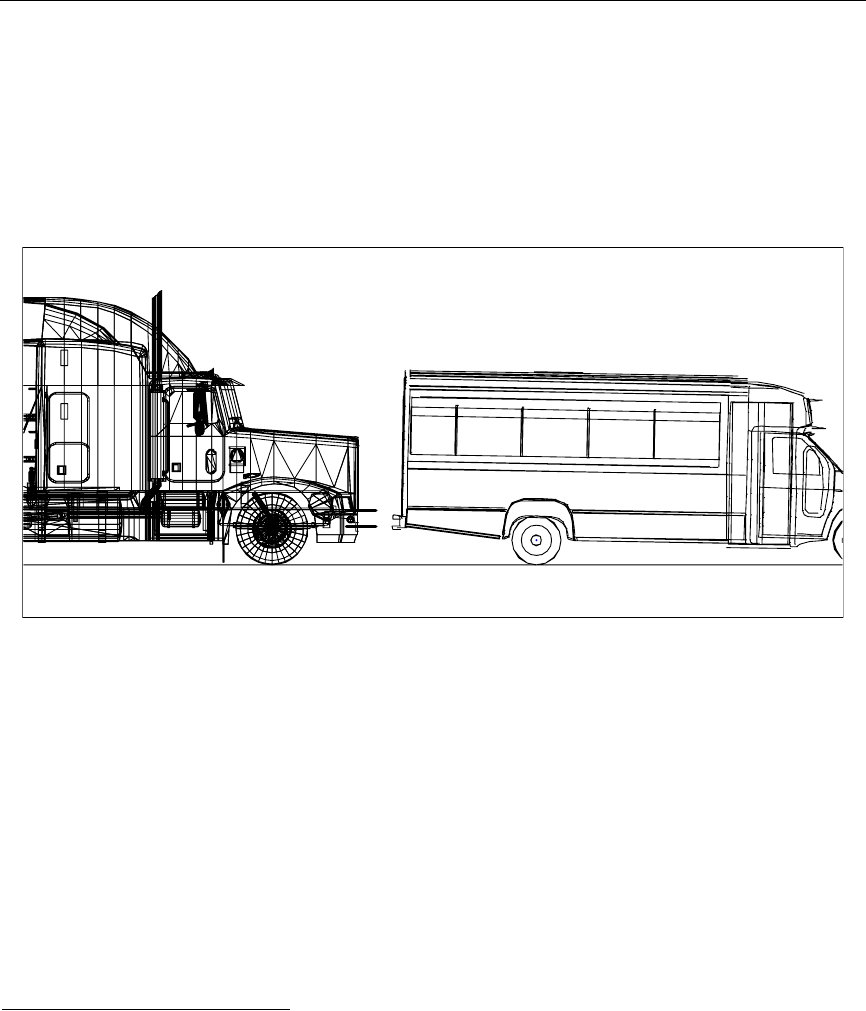
Analysis 62 Highway Accident Report
weights
121
and structural stiffness and because of geometric mismatch. (See figure 24.)
The differences in weight and stiffness and the geometric mismatch are often referred to as
vehicle “aggressivity.” NHTSA’s Web page, “Heavy Vehicle Aggressivity Program,”
122
last updated in June 2000, states that the common belief is that not much can be done to
diminish the consequences of crashes between smaller vehicles and large trucks because
of the significant differences in vehicle mass.
However, research has shown that geometric height differences and a lack of
forgiving front truck structures can be modified to help reduce heavy truck aggressivity
and to mitigate the severity of these types of accidents.
123,124,125
Examples of these
modifications, often referred to as “front underride protection systems”—which can result
in reduced intrusion or occupant injury—include energy-absorbing front structures to
offset the weight differences between two impacting vehicles, as well as bumpers
designed to deflect the impacted vehicle away from the front of the truck, thereby
reducing the total change in velocity of the smaller vehicle.
121
Of the 10 passengers interviewed who provided estimates of their weight, the average weight was
144 pounds. The driver weighed about 200 pounds. The total weight of an exemplar bus (including driver)
was 10,420 pounds. Combined with an average weight of 150 pounds for 20 passengers, the difference
between the specialty bus weight of 13,420 pounds and the combination unit at 76,480 pounds was 63,060
pounds, or a ratio of about 6 to 1.
122
See <www-nrd.nhtsa.dot.gov/departments/nrd-01/summaries/havp_02.html>, March 23, 2006.
Figure 24. Freightliner and specialty bus bumper height comparison.
123
A. Berg, M. Krehl, L. Riebeck, and U. Breitling, “Passive Safety of Trucks in Frontal and Rear-End
Collisions With Cars,” Proceedings, 18th International Technical Conference on Enhanced Safety of
Vehicles, Nagoya, Japan (Washington, DC: NHTSA, 2003).
124
A. K. Prasad, R. M. Clarke, D. Willke, and M. Monk, Reducing Heavy Truck Aggressivity in
Collisions With Passenger Cars, DOT HS 808 476 (Washington, DC: NHTSA, 1995).
125
K. Mendis, A. Mani, A. K. Prasad, D. Willke, M. Mond, and R. M. Clarke, “Concepts to Reduce
Heavy Truck Aggressivity in Truck-to-Car Collisions, Proceedings, 15th International Technical
Conference on Enhanced Safety of Vehicles, Melbourne, Australia (Washington, DC: NHTSA, 1996).

Analysis 63 Highway Accident Report
In this accident, as a result of the heavy truck’s aggressivity, an almost 5-foot
intrusion into the bus’s passenger compartment led to loss of survivable space for many
passengers seated in the rear; seven of the eight passengers seated in the last three rows of
the bus were fatally injured. Except for the ejected passenger seated in row 1, the
passengers seated forward in the bus (in rows 1–3) sustained minor-to-serious injuries. In
other words, the crash forces experienced by the passengers seated away from the
intrusion area were mitigated by the crushing of the rear of the bus. The Safety Board
concludes that the combination of the large weight difference (almost 6 to 1) between the
Freightliner tractor-trailer and the specialty bus, the impact speed of the tractor-trailer into
the specialty bus, the difference in stiffness between the tractor front end and the bus body,
and the geometric mismatch during the dynamic collision led to the truck overriding the
bus’s rear structure and resulted in extensive intrusion damage into the rear passenger
compartment, a loss of survivable space in that area, and the deaths of seven passengers.
Occupant protection requires that survivable space be maintained for all
passengers, and that the interior structure provide sufficient support and energy absorption
so that crash forces are survivable. Vehicles with high aggressivity, such as heavy trucks,
often compromise the survivable space in the vehicles they hit. Currently, the United
States does not have a requirement for front underride protection
126
on heavy trucks.
Europe began studying and testing such devices in 1994 and subsequently established
regulations requiring these protection devices on heavy vehicles. Regulations of the
Economic Commission for Europe (ECE) are in place for both front underride and rear
underride protection (ECE-R 93 and ECE-R 58, respectively); the regulations provide
standard specifications for the mount, dimensions, and static stability performance of
these devices.
In the United States, a 2004 study conducted by the NCHRP, entitled A Guide for
Reducing Collisions Involving Heavy Trucks, noted that combination-unit trucks (usually
tractor-semitrailers) were found to have a markedly different crash involvement profile
than vehicles in general. According to the study, these vehicles
have relatively low crash rates per mile traveled, but with much greater crash
costs per year, and over their operational lives, more than four times higher than
most other vehicle types. This means that from a cost-benefit standpoint, safety
investments in tractor-trailers are likely to have much greater per-vehicle benefits
than similar investments in other vehicle types.
127
A 1998 NHTSA overview report on vehicle compatibility and light truck (light
trucks and vans [LTV]
128
) issues stated that the number of LTVs has grown dramatically
since the early 1980s. A 2003 study of vehicle mismatch and injury indicated that motor
126
A front underride protection system is an energy-absorbing structure on the front of a truck that
reduces injuries to occupants in a vehicle struck by the front of the truck.
127
Transportation Research Board of the National Academies, National Cooperative Highway Research
Program, Guidance for Implementation of the AASHTO Strategic Safety Plan, Volume 13: A Guide for
Reducing Collisions Involving Heavy Trucks, NCHRP Report 500 (Washington, DC: TRB, 2004) III-3.
128
According to NHTSA, the LTV category consists of trucks of 10,000 pounds GVWR or less and
includes pickups, vans, minivans, truck-based station wagons, and sport utility vehicles.

Analysis 64 Highway Accident Report
vehicle registrations for the year 2000 showed 77.8 million light trucks in the United
States, a 63.8 percent increase since 1990; LTVs now account for 40 percent of all
registered motor vehicles. During the same 10-year period, the number of registered
passenger vehicles increased by 1 percent.
129
In addition to the increase in LTVs, the
number of registered large trucks increased by 30 percent between 1993 and 2003, and
miles traveled by large trucks increased 35 percent.
130
If these trends continue, LTVs and
large trucks will soon constitute the majority of vehicles on the road, resulting in even
greater occurrences of vehicle incompatibility in accidents.
In 2003, approximately 457,000 large trucks (GVWR exceeding 10,000 pounds)
were involved in traffic accidents and accounted for 8 percent of vehicles involved in fatal
accidents. These traffic accidents resulted in 4,669 fatalities and 122,000 injuries; 85
percent of those killed and 78 percent of those injured were the occupants of other
vehicles (passenger cars and LTVs), pedestrians, or bicyclists.
131
The initial point of
impact for 62.8 percent of the fatal accidents involved the front of the truck.
132
In
accidents involving a large truck during 2004, some 4,006 occupants of passenger cars and
LTVs were killed, and 85,000 such occupants were injured.
133
According to the DOT, its
goal is to reduce highway fatality rates from 1.46 persons per 100 million vehicle miles
traveled (VMT) in 2004 to 1 person per 100 million VMT by 2008. The FMCSA’s goal is
to reduce commercial motor vehicle-related fatalities from 2.3 per 100 million commercial
motor VMT in 2004 to 1.65 per 100 million commercial motor VMT by 2008.
134
Achieving these ambitious goals will clearly require a large reduction in fatalities resulting
from accidents between large trucks and passenger vehicles.
NHTSA has made some progress in testing and evaluating measures to reduce
heavy truck aggressivity; however, the agency has published little recently to indicate
continued testing or the intent to implement changes in the industry. The Safety Board
recognizes that NHTSA has discussed the need to reduce fatalities resulting from large
truck accidents and has stated that research and implementation of ITS technologies for
accident avoidance is a priority. But the agency has not included large truck
incompatibility among its priorities for rulemaking or research support for calendar years
2005–2009.
The 21st Century Truck Program, of which the DOT is a partner, announced in its
“roadmap” in December 2000 the goal to improve truck safety by fostering advancements
in vehicle design and performance, such as reducing truck frontal aggressivity in
multivehicle collisions. However, the milestone set for completing laboratory tests and
129
Acierno, “Vehicle Mismatch: Injury Patterns and Severity,” 761.
130
See <ai.fmcsa.dot.gov/carrierresearchresults/html/2003crashfacts/chap1.htm>, March 28, 2006.
131
See <www.nhtsa.dot.gov/cars/rules/rulings/PriorityPlan-2005.html>, March 23, 2006.
132
See <ai.fmcsa.dot.gov/carrierresearchresults/html/2003crashfacts/tbl42.htm>, March 28, 2006.
133
A total of 761 truck occupants were killed, and about 27,000 were injured. See <www-
nrd.nhtsa.dot.gov/pdf/nrd-30/NCSA/TSFAnn/TSF2004EE.pdf>, March 28, 2006.
134
See (a) <www.fmcsa.dot.gov/facts-research/research-technology/report/rt-5year-strategicplan. htm>,
March 23, 2006. (b) <www.fmcsa.dot.gov/facts-research/facts-figures/mcspr-12-31-05.htm>, March 23,
2006.

Analysis 65 Highway Accident Report
field trials of systems designed to reduce the destructive effects of truck accidents is not
until midyear 2009. The incompatibility of large trucks with passenger cars is not a new
issue, and the Europeans have been doing work in this area since at least 1994. In keeping
with the DOT’s own goals to reduce fatalities resulting from large truck accidents and the
21st Century Truck Program’s goal to foster advancements in vehicle design and reduction
of truck frontal aggressivity, both the department and the truck program need to increase
their investments in truck design initiatives that could ameliorate the severity of collisions
with large trucks.
The Safety Board therefore concludes that although NHTSA has acknowledged
the seriousness of the vehicle incompatibility problem in contributing to the severity of
traffic accidents, it has not allocated adequate resources to that issue as it affects heavy
trucks, a major cause of death for occupants in both passenger cars and LTVs. Therefore,
the Safety Board believes that the DOT should include heavy vehicles in its research,
testing, and eventual rulemaking on highway vehicle incompatibility, especially as that
incompatibility affects the severity of accidents. In addition, the Safety Board believes that
the DOE should report to the Safety Board the 21st Century Truck Program’s plans and
timetable for prioritizing research, testing, and design enhancements that address heavy
truck aggressivity.

66 Highway Accident Report
Conclusions
Findings
1. The weather; the mechanical condition of the specialty bus, pickup truck, Ford
tractor-box trailer, and Kenworth tractor-tank trailer; and the design and condition of
the roadway did not cause or contribute to the accident.
2. Neither the Freightliner driver nor the specialty bus driver was adversely affected by
medications, medical conditions, or fatigue; and the emergency response was timely
and effective.
3. Brake force calculations, together with the physical evidence on scene, indicate that
the Freightliner’s out-of-adjustment brakes did not contribute to the accident.
4. The Freightliner driver had ample cues indicating that he needed to allow more space
between his heavy vehicle and those ahead, and his failure to maintain adequate
following distance and to reduce the speed of his vehicle relative to the slowing traffic
ahead contributed to this accident.
5. The Freightliner driver did not detect the slowing traffic ahead of his vehicle, and had
the Freightliner truck been equipped with a collision warning system designed to
detect this type of situation and alert drivers, that technology might have prevented
this accident.
6. Traditional toll plazas, such as the Hampshire–Marengo toll plaza (as configured on
the day of the accident), create traffic backups that present a safety hazard; the
conversion of traditional plazas to electronic toll collection systems should greatly
reduce such hazards and improve safety on toll roads.
7. By requiring intermodal equipment owners to obtain a U.S. Department of
Transportation number and adhere to the Federal Motor Carrier Safety Regulations,
the new rulemaking required by the Safe, Accountable, Flexible, Efficient
Transportation Equity Act: A Legacy for Users will help close the gap in the Federal
Motor Carrier Safety Administration’s oversight of intermodal equipment, such as
that involved in this accident, and improve freight transportation safety.
8. The Federal Motor Carrier Safety Administration’s process for revocation of
operating authority is inadequate because, as this accident demonstrates, it fails to
follow up and verify that the out-of-service carrier has ceased operations.

Conclusions 67 Highway Accident Report
9. The combination of the large weight difference (almost 6 to 1) between the
Freightliner tractor-trailer and the specialty bus, the impact speed of the tractor-trailer
into the specialty bus, the difference in stiffness between the tractor front end and the
bus body, and the geometric mismatch during the dynamic collision led to the truck
overriding the bus’s rear structure and resulted in extensive intrusion damage into the
rear passenger compartment, a loss of survivable space in that area, and the deaths of
seven passengers.
10. Although the National Highway Traffic Safety Administration has acknowledged the
seriousness of the vehicle incompatibility problem in contributing to the severity of
traffic accidents, it has not allocated adequate resources to that issue as it affects
heavy trucks, a major cause of death for occupants in both passenger cars and light
trucks and vans.
Probable Cause
The National Transportation Safety Board determines that the probable cause of
the accident was the failure of the Freightliner truck driver, who was operating his vehicle
too fast for traffic conditions, to slow for traffic. Contributing to the accident was the
traffic backup in a 45-mph zone, created by vehicles stopping for the Hampshire–Marengo
toll plaza. The structural incompatibility between the Freightliner tractor-trailer and the
specialty bus contributed to the severity of the accident.

68 Highway Accident Report
Recommendations
As a result of its investigation, the National Transportation Safety Board makes the
following safety recommendations:
New Recommendations
To the U.S. Department of Energy:
Report to the National Transportation Safety Board the 21st Century Truck
Program’s plans and timetable for prioritizing research, testing, and design
enhancements that address heavy truck aggressivity. (H-06-15)
To the U.S. Department of Transportation:
Include heavy vehicles in your research, testing, and eventual rulemaking
on highway vehicle incompatibility, especially as that incompatibility
affects the severity of accidents. (H-06-16)
To the Federal Motor Carrier Safety Administration:
Establish a program to verify that motor carriers have ceased operations
after the effective date of revocation of operating authority. (H-06-17)
To the Federal Highway Administration:
Cooperate with the American Association of State Highway and
Transportation Officials and the International Bridge, Tunnel and Turnpike
Association to develop written guidelines on toll plaza design that provide
information on current tolling practices, electronic toll collection
strategies, and other equipment designed to eliminate queuing at toll plazas
and to improve toll road safety. (H-06-18)
To the American Association of State Highway and Transportation Officials:
Cooperate with the Federal Highway Administration and the International
Bridge, Tunnel and Turnpike Association to develop written guidelines on
toll plaza design that provide information on current tolling practices,
electronic toll collection strategies, and other equipment designed to
eliminate queuing at toll plazas and to improve toll road safety. (H-06-19)

Recommendations 69 Highway Accident Report
Include the information from the written guidelines on toll plaza design in
the next update of A Policy on Geometric Design of Highways and Streets
(Green Book). (H-06-20)
To the International Bridge, Tunnel and Turnpike Association:
Cooperate with the Federal Highway Administration and the American
Association of State Highway and Transportation Officials to develop
written guidelines on toll plaza design that provide information on current
tolling practices, electronic toll collection strategies, and other equipment
designed to eliminate queuing at toll plazas and to improve toll road safety.
(H-06-21)
Reiterated Recommendations
The National Transportation Safety Board also reiterates the following
recommendations:
To the National Highway Traffic Safety Administration:
Complete rulemaking on adaptive cruise control and collision warning
system performance standards for new commercial vehicles. At a
minimum, these standards should address obstacle detection distance,
timing of alerts, and human factors guidelines, such as the mode and type
of warning. (H-01-6)
After promulgating performance standards for collision warning systems
for commercial vehicles, require that all new commercial vehicles be
equipped with a collision warning system. (H-01-7)
BY THE NATIONAL TRANSPORTATION SAFETY BOARD
MARK V. ROSENKER ELLEN ENGLEMAN CONNERS
Acting Chairman Member
DEBORAH A. P. HERSMAN
Member
KATHRYN O’LEARY HIGGINS
Member
Adopted: April 18, 2006

this page intentionally left blank

71 Highway Accident Report
Appendix A
Investigation
The National Transportation Safety Board was notified of the Hampshire, Illinois,
accident on October 1, 2003. An investigative team was dispatched with members from
the Washington, D.C.; Atlanta, Georgia; and Arlington, Texas, offices. Groups were
established to investigate human performance; motor carrier operations; and highway,
vehicle, and survival factors.
Participating in the investigation were representatives of the Federal Motor Carrier
Safety Administration; the Federal Highway Administration; the Illinois State Police; the
Illinois State Toll Highway Authority; the International Bridge, Tunnel and Turnpike
Association; Leisure Pursuit Charters, Inc.; Frontline Transportation Company; Ford
Motor Company; Goshen Coach Division of McCoy Miller, Inc.; and the Hampshire Fire
Department.
No public hearing was held; no depositions were taken.

72 Highway Accident Report
Appendix B
Freightliner Combination Vehicle Information
Freightliner FLD tractor
Manufacturer: Freightliner Corporation
Model: FLD 120064S T
Date of manufacture: August 1994
Gross vehicle weight rating: 46,000 pounds (lbs)
Gross axle weight rating: 12,000 lbs (steer axle)
Gross axle weight rating: 16,000 lbs (rear axles, each)
Curb weight: 16,160 lbs (8,609 lbs front, 7,551 lbs rear)
Unsprung tractor weight: 5,000 lbs (total, approximate)
Theurer trailer chassis
Manufacturer: Theurer Inc. (Subsidiary Kiddie, Inc.)
Model: 220-CC-40GN
Date of manufacture: September 1984
Gross vehicle weight rating: 72,715 lbs
Gross axle weight rating: 19,040 lbs (tandem axles, each)
Tare weight: 16,500 lbs
Curb eight: 16,160 lbs (8,609 lbs front, 7,551 lbs rear)
Overall length, width 40.7 feet (ft), 8.0 ft
Overall height driver side: 48.0 inches (in) (from ground)
Overall height right side: 44.5 in (from ground)
Cargo container
Manufacturer: Yangzhou Tangyun Container Co., LTD.
Type: TYC-112B
Date of manufacture: October 2002
Maximum gross weight: 67,200 lbs
Tare weight: 8,780 lbs

Appendix B 73 Highway Accident Report
Payload: 58,420 lbs
Allowable stack weight: 476,200 lbs
Exterior length, height, width 40.0 ft, 9.5 ft, 8.0 ft
On October 1, 2003, the Illinois State Police weighed the Freightliner tractor-
trailer using in-ground scales at Arrowhead Shell in Hampshire, Illinois. The steer axle
weighed 9,280 pounds, the second and third axles weighed 38,780 pounds, and the fourth
and fifth axles weighed 28,420 pounds—for a total vehicle weight of 76,480 pounds.

74 Highway Accident Report
Appendix C
SDM Data
Sensing Diagnostic Module
The 2000 Chevrolet Silverado 1500 extended cab pickup truck was equipped with
an advanced frontal occupant protection system, which incorporated manual three-point
safety belts, along with a driver and passenger supplemental restraint system, which
consisted of frontal air bags at both the driver and passenger positions. Under such a
system, crash detection, as well as air bag deployment, is managed by an electronic
control module identified as a sensing diagnostic module (SDM) by the General Motors
Corporation. The primary purpose of the SDM is to “sense” an impending crash event and
to determine when and if air bag deployment is warranted. The SDM does not sense a
rear-end collision as a crash event. Rather, a crash event is sensed when the vehicle rapidly
decreases speed, experiencing a rearward (negative) change in velocity (delta-v).
In addition to its primary function, the accident SDM was equipped with
nonvolatile electronically erasable programmable read-only memory (EEPROM) used to
preserve critical operating data, including precrash data, crash severity data, and air bag
deployment, as well as diagnostic trouble codes. According to the SDM, the pickup truck
was traveling 3 mph for at least 3 seconds. It was then most likely struck from behind by
the specialty bus, which had accelerated to about 40 mph from the first rear-end crash.
This rear impact into the pickup truck caused it to increase speed. The pickup truck was
then forced into the rear of the Ford tractor-box trailer. The SDM quite likely sensed the
crash event from this rear impact, activated the driver’s air bag, and recorded a maximum
rearward (negative) delta-v of 13.77 mph. The actual delta-v may have been higher than
this value because the SDM may not have recorded the entire crash pulse.
The information retrieved from the accident vehicle’s SDM revealed 5 seconds of
precrash data. The SDM receives various data, including precrash parameters, from the
vehicle’s class II communications bus
1
asynchronously
2
at 1-second intervals. Because the
data are asynchronous, the actual time interval has been determined to vary +/–0.02
second, providing an interval closer to about every 0.8 to 1.2 seconds. Vehicle speeds that
fall within these precrash data intervals are not recorded and therefore are unavailable. By
design, the precrash data obtained from the accident represent the time before the
algorithm enable (AE) occurs. Table C-1 summarizes precrash data from the accident
SDM for vehicle speed and engine speed.
1
A communications bus is a network arrangement in which all devices are directly attached, and all
data pass through each of the devices; each device has a unique identity and can recognize those signals
intended for it.
2
“Asynchronous” pertains to a transmission technique that does not require a common clock between
the communicating devices; timing signals are derived from special characters in the data stream itself.

Appendix C 75 Highway Accident Report
As shown in the table, the data retrieved from the SDM indicated that at 5, 4, 3,
and 2 seconds before AE, the pickup truck’s operational information showed the vehicle
traveling 3 mph.
3
The data further indicate that, about 1 second prior to AE, the vehicle
slowed to 1 mph and the engine speed was reported as 0 rpm.
4
Other SDM data showed a
recorded crash pulse indicating that the pickup truck experienced a maximum recorded
rearward (negative) deceleration delta-v of at least 13.77 mph within the recorded data.
Table C-1. Partial list of SDM-derived precrash data from Chevrolet pickup truck.
According to information obtained by the Safety Board during the investigation,
the type of SDM on the pickup truck records only a rearward (negative) delta-v. It would
not have recorded an impact to the rear of the vehicle that resulted in a vehicle forward
(positive) delta-v. Because the SDM does not record forward delta-v, the pickup truck was
most likely struck from behind prior to experiencing AE without the SDM detecting the
collision. For example, the specialty bus could have struck the pickup truck between 0.0
and 1.0 second prior to AE. Because the SDM records only whole-second increments
before AE, it would not have detected the speed change as a result of such a collision. As
shown in table C-1, the SDM data indicate that the vehicle’s speed dropped to 1 mph and
the engine rpm dropped to 0 approximately 1.0 second prior to AE. At this point in the
precrash data, the time prior to AE is very possibly between 0.001 and 0.999 second—not
1.0 second. AE is generally located at a value less than 1.0 second and more than 0.999
second.
Safety Board investigators examined the SDM data, along with other evidence.
They applied the reported SDM data to the known accident circumstances and found that,
most likely, just prior to being struck from behind by the specialty bus, the pickup truck
was in the process of slowing to a stop and was traveling 3 mph for a least 3.0 seconds.
This time frame is represented within the SDM precrash data as –5 through –2 seconds.
3
These data are intended to represent the forward, or longitudinal, speed of the vehicle.
4
The SDM receives speed data from the vehicle’s power train control module, which calculates road
speed.
Seconds before AE
A
Vehicle
speed (mph)
Engine
speed (rpm)
–5 3 640
–4 3 512
–3 3 512
–2 3 512
–1 1 0
A
Algorithm enable (AE), or “wake-up,” refers to negative acceleration (about
–1 to –2 g’s over two consecutive samples) observed by the air bag’s control
module microcomputer. A negative acceleration results in a decrease in the
vehicle’s speed. The module then begins running the “algorithm,” leading to
the deployment decision.

Appendix C 76 Highway Accident Report
(See table C-1.) At this point (somewhere between –2 and –1 seconds), the pickup truck
was struck from behind, pushing it into the rear of the vehicle in front of it, resulting in a
rearward (negative) change in velocity (negative acceleration). If this occurred, the pickup
truck would have traveled at 3 mph for approximately 3.0 seconds and then,
approximately 0.999 to 0.001 second later, undergone a rearward acceleration that resulted
in a recorded delta-v of at least 13.77 mph.
Because of data rebuffering,
5
the SDM “precrash” data reported at –1 second to
AE is believed to have occurred “after” AE and, therefore, the reported data would have
occurred after initial impact and during vehicle engagement. In the simulations described
in this report, the pickup truck is traveling 3 mph prior to AE; however, even if the SDM
reported vehicle speed at –1 second, of the 1 mph that occurred prior to AE, this reduction
in speed would not significantly affect the simulation results. Safety Board investigators
obtained no physical evidence to indicate that the reported SDM data were erroneous or
invalid.
Air Bag Deployment
According to the SDM data, the pickup truck underwent a rearward delta-v as a
result of the collision that caused the air bag to deploy. Based on the physical evidence
documented from the accident scene and the Safety Board’s simulations, only two of the
collisions that occurred during this multivehicle accident would have resulted in a
rearward delta-v and decelerations:
1. When the specialty bus pushed the pickup truck forward into the rear of the
Ford tractor-box trailer, and
2. When the Kenworth tractor-tank trailer subsequently struck the pickup truck,
causing it to move forward again and strike the Ford tractor-box trailer in a
secondary collision.
The other collision occurred when the pickup truck was struck from behind by the
specialty bus, following the Freightliner’s collision with the bus. This collision caused the
pickup truck to accelerate forward, increasing its speed, and did not cause the rearward
deceleration and change in velocity needed to deploy the air bag.
5
The accident SDM was identified as belonging to a family of modules in which some precrash data
may actually be recorded after, rather than before, AE. This potential for anomalous precrash data is caused
by a phenomenon known as “data rebuffering,” which may result in some precrash data being recorded after
AE.

77 Highway Accident Report
Appendix D
State Toll Facilities
Table 12. States with and without toll facilities.
A
With 1 toll facility More than 1 toll facility No toll facilities
Alaska California Alabama
Arkansas Colorado Arizona
Kansas Delaware Connecticut
Kentucky Florida Hawaii
Maine Georgia Idaho
Missouri Illinois Iowa
Nevada Indiana Minnesota
New Hampshire Louisiana Mississippi
Ohio Maryland Montana
Oklahoma Massachusetts New Mexico
Rhode Island Michigan North Carolina
South Carolina Nebraska North Dakota
New Jersey South Dakota
New York Tennessee
Oregon Utah
Pennsylvania Vermont
Texas Washington
Virginia Wisconsin
West Virginia Wyoming
SOURCE: U.S. Department of Transportation, Federal Highway Administration, Highway Statistics, 2003 (Washington,
DC: FHWA, 2004).
A
“Toll facilities” exclude ferry facilities.
Table D-1.

78 Highway Accident Report
Appendix E
SAFETEA-LU 2005
The following language is a verbatim excerpt from the Safe, Accountable,
Flexible, Efficient Transportation Equity Act: A Legacy for Users, signed into law on
August 10, 2005:
SEC. 4106 MOTOR CARRIER SAFETY GRANTS
(a) State Plan Contents. Section 31102(b)(1) of title 49, United States Code, is amended–
(7) By adding at the end the following:
“(X) except in the case of an imminent or obvious safety hazard, ensures that an
inspection of a vehicle transporting passengers for a motor carrier of passengers is
conducted at a station, terminal, border crossing, maintenance facility, destination,
or other location where a motor carrier may make a planned stop.”
SEC. 4118 ROADABILITY
(a) In General. Subchapter III of chapter 311 of title 49, United States Code (as amended
by sections 4116 and 4117 of this Act) is amended by adding at the end of the following:
§ 31151. Roadability
(b) Inspection, Repair, and Maintenance of Intermodal Equipment.
(1) In General. Not later than 1 year after the date of enactment of this
section, the Secretary of Transportation, after providing notice and opportunity for
comment, shall issue regulations establishing a program to ensure that intermodal
equipment used to transport intermodal containers is safe and systemically
maintained.
(2) Intermodal Equipment Safety Regulations. The Secretary shall issue the
regulations under this section as a subpart of the Federal motor carrier safety
regulations.
(3) Contents. The regulations issued under this section shall include, at a
minimum–
(A) a requirement to identify intermodal equipment providers
responsible for the inspection and maintenance of intermodal equipment

Appendix E 79 Highway Accident Report
that is interchanged or intended for interchange to motor carriers in
intermodal transportation;
(B) a requirement to match intermodal equipment readily to an
intermodal equipment provider through a unique identifying number;
(C) a requirement that an intermodal equipment provider identified
under subparagraph (A) systemically inspect, repair, and maintain, or cause
to be systemically inspected, repaired, and maintained, intermodal
equipment described in subparagraph (A) that is intended for interchange
with a motor carrier;
(D) a requirement to ensure that each intermodal equipment provider
identified under subparagraph (A) maintains a system of maintenance and
repair records for such equipment;
(E) requirements that–
(i) a specific list of intermodal equipment components or items be identified
for the visual or audible inspection of which a driver is responsible before
operating the equipment over the road; and
(ii) the inspection under clause (i) be conducted as part of the Federal
requirement in effect on the date of enactment of this Act that a driver be
satisfied that the intermodal equipment components are in good working
order before the equipment is operated over the road;
(F) a requirement that a facility at which an intermodal equipment
provider regularly makes intermodal equipment available for interchange
have an operational process and space readily available for a motor carrier
to have an equipment defect identified pursuant to subparagraph (E)
repaired or the equipment replaced prior to departure;
(G) a program for the evaluation and audit of compliance by
intermodal equipment providers with applicable Federal motor carrier
safety regulations;
(H) a civil penalty structure consistent with section 521(b) of title 49,
United States Code, for intermodal equipment providers that fail to attain
satisfactory compliance with applicable Federal motor carrier safety
regulations; and
(I) a prohibition on intermodal equipment providers from placing
intermodal equipment in service on the public highways to the extent such
providers or their equipment are found to pose an imminent hazard;

Appendix E 80 Highway Accident Report
(J) a process by which motor carriers and agents of motor carriers
shall be able to request the Federal Motor Carrier Safety Administration to
undertake an investigation of an intermodal equipment provider identified
under subparagraph (A) that is alleged to be not in compliance with the
regulations under this section;
(K) a process by which equipment providers and agents of equipment
providers shall be able to request the Administration to undertake an
investigation of a motor carrier that is alleged to be not in compliance with
the regulations issued under this section
(L) a process by which a driver or motor carrier transporting
intermodal equipment is required to report to the intermodal equipment
provider or the provider’s designated agent any actual damage or defect in
the intermodal equipment of which the driver or motor carrier is aware at
the time the intermodal equipment is returned to the intermodal equipment
provider or the provider’s designated agent;
(M) a requirement that any actual damage or defect identified in the
process established under subparagraph (L) be repaired before the
equipment is made available for interchange to a motor carrier and that
repairs of this equipment made pursuant to the requirements of this
subparagraph and reports made pursuant to this subparagraph (L) process
be documented in the maintenance records for such equipment; and
(N) a procedure under which motor carriers, drivers and intermodal
equipment providers may seek correction of their motor carrier safety
records through the deletion from those records of violations of safety
regulations attributable to deficiencies in the intermodal chassis or trailer
for which they should not have been held responsible.
(4) Deadline for Rulemaking Proceeding. Not later than 120 days after the date of
enactment of this section, the Secretary shall initiate a rulemaking proceeding for issuance
of the regulations under this section.
(c) Inspection, Repair, and Maintenance of Intermodal Equipment. The Secretary or an
employee of the Department of Transportation designated by the Secretary may inspect
intermodal equipment, and copy related maintenance and repair records for such
equipment, on demand and display of proper credentials.
(d) Out-Of-Service Until Repair. Any intermodal equipment that is determined under this
section to fail to comply with applicable Federal safety regulations may be placed out of
service by the Secretary or a Federal, State, or government official designated by the
Secretary and may not be used on a public highway until the repairs necessary to bring
such equipment into compliance have been completed. Repairs of equipment taken out of
service shall be documented in the maintenance records for such equipment.

Appendix E 81 Highway Accident Report
(e) Preemption Generally. Except as provided in subsection (e), a law, regulation, order, or
other requirement of a State, a political subdivision of a State, or a tribal organization
relating to commercial motor vehicle safety is preempted if such law, regulation, order, or
other requirement exceeds or is inconsistent with a requirement imposed under or
pursuant to this section.
(f) Pre-Existing State Requirements.
(1) In General. Except as provided in paragraph (2), a State requirement for the
periodic inspection of intermodal chassis by intermodal equipment providers that was in
effect on January 1, 2005, shall remain in effect only until the date which requirements
prescribed under this section take effect.
(2) Nonpreemption Determinations.
(A) In General. Notwithstanding subsection (d), a State requirement
described in paragraph (1) is not preempted by a Federal requirement
prescribed under this section if the Secretary determines that the State
requirement is as effective as the Federal requirement and does not unduly
burden interstate commerce.
(B) Application Required. Subparagraph (A) applies to a State
requirement only if the State applies to the Secretary for a determination
under this paragraph with respect to the requirement before the date on
which the regulations issued under this section take effect. The Secretary
shall make a determination with respect to any such application within 6
months after the date on which the Secretary receives the application.
(C) Amended State Requirements. Any amendment to a State
requirement not preempted under this subsection because of a
determination by the Secretary under subparagraph (A) may not take effect
unless–
(i) it is submitted to the Secretary before the effective date of the
amendment; and
(ii) the Secretary determines that the amendment would not cause the
State requirement to be less effective than the Federal requirement and
would not unduly burden interstate commerce.
(g) Definitions. In this section the following definitions apply:
(1) Intermodal Equipment. The term “intermodal equipment” means
trailing equipment that is used on the intermodal transportation of containers over
public highways in interstate commerce, including trailers and chassis.

Appendix E 82 Highway Accident Report
(2) Intermodal Equipment Interchange Agreement. The term “intermodal
equipment interchange agreement” means the Uniform Intermodal Interchange
and Facilities Access Agreement or any other written document executed by an
intermodal equipment provider or its agency and a motor carrier or its agent, the
primary purpose of which is to establish the responsibilities and liabilities of both
parties with respect to the interchange of the intermodal equipment.
(3) Intermodal Equipment Provider. The term “intermodal equipment
provider” means any person that interchanges intermodal equipment with a motor
carrier pursuant to a written interchange agreement or has a contractual
responsibility for the maintenance of the intermodal equipment.
(4) Interchange. The term “interchange”
(A) means the act of providing intermodal equipment to a motor
carrier pursuant to an intermodal equipment interchange agreement for the
purpose of transporting the equipment for loading or unloading by any
person or repositioning the equipment for the benefit of the equipment
provider; but
(B) does not include the leasing of equipment to a motor carrier for
primary use in the motor carrier’s freight hauling operations.
(b) Clerical Amendment. The analysis for such subchapter (as amended by sections 4116
and 4117 of this Act) is amended by adding at the end the following:
“31151. Roadability.”
SEC. 1403 TOLL FACILITIES WORKPLACE SAFETY STUDY
(a) In General. The Secretary shall conduct a study on the safety of highway toll collection
facilities, including toll booths, to determine the safety of the facilities for the toll
collectors who work in and around the facilities, including consideration of-
(1) the effect of design or construction of the facilities on the likelihood of
vehicle collisions with the facilities;
(2) the safety of crosswalks used by toll collectors in transit to and from toll
booths;
(3) the extent of the enforcement of speed limits in the vicinity of the
facilities;
(4) the use of warning devices, such as vibration and rumble strips to alert
drivers approaching the facilities;

Appendix E 83 Highway Accident Report
(5) the use of cameras to record traffic violations in the vicinity of the
facilities;
(6) the use of traffic control arms in the vicinity of the facilities;
(7) law enforcement practices and jurisdictional issues that affect safety in
the vicinity of the facilities; and
(8) the incidence of accidents and injuries in the vicinity of toll booths.
(b) Data Collection. As part of the study, the Secretary shall collect data regarding the
incidence of accidents and injuries in the vicinity of highway toll collection facilities.
(c) Report. Not later than 1 year after the date of enactment of this Act, the Secretary shall
submit to the Committee on Transportation and Infrastructure of the House of
Representatives and the Committee on Environment and Public Works of the Senate a
report on the results of the study, together with recommendations for improving toll
facilities workplace safety.
(d) Funding.
(1) Authorization of Appropriations. There is authorized to be appropriated
to carry out this section, out of the Highway Trust Fund (other than the Mass
Transit Account), $500,000 for fiscal year 2006.
(2) Contract Authority. Funds authorized to be appropriated by this section
shall be available for obligation in the same manner and to the same extent as if the
funds were apportioned under chapter 1 of title 23, United States Code, except that
the Federal share of the cost of the project shall be 100 percent, and the funds shall
remain available until expended and shall not be transferable.

84 Highway Accident Report
Appendix F
Illinois Vehicle Code, Intermodal Equipment Exchange
The following language is a verbatim excerpt from the Illinois Vehicle Code, P.A.
91-622, effective July 1, 2000:
625 ILCS 5/18b-112
Sec. 18b-112. Intermodal trailer, chassis, and safety.
(a) Definitions. For purposes of this Section:
“Department” means the Department of State Police.
“Equipment interchange agreement” means a written document executed by the
intermodal equipment provider and operator at the time the equipment is interchanged by
the provider to the operator.
“Equipment provider” is the owner of the intermodal trailer, chassis, or container.
This includes any forwarding company, water carrier, steamship line, railroad, vehicle
equipment leasing company, and their subsidiary or affiliated companies, owning the
equipment.
“Federal motor carrier safety regulations” means regulations promulgated by the
United States Department of Transportation governing the condition and maintenance of
commercial motor vehicles contained in Title 49 of the United States Code of Federal
Regulations on the day of enactment of this Act or as amended or revised by the United
States Department of Transportation thereafter.
“Interchange [means] the act of providing a vehicle to a motor carrier by an
equipment provider for the purpose of transporting the vehicle for loading or unloading by
another party or the reposition of the vehicle for the benefit of the equipment provider.
“Interchange” does not include the leasing of the vehicle by a motor carrier from an
owner-operator pursuant to subpart B of Part 376 of Title 49 of the Code of Federal
Regulations or the leasing of a vehicle to a motor carrier for use in the motor carrier’s
over-the-road freight hauling operation.
“Operator” means a motor carrier or driver of a commercial motor vehicle.
“Vehicle” means an intermodal trailer, chassis, or container.
(b) Responsibility of equipment provider. An equipment provider shall not interchange or
offer for interchange a vehicle with an operator for use on a highway which vehicle is in
violation of the requirements contained in the federal motor carrier safety regulations. It is

Appendix F 85 Highway Accident Report
the responsibility of the equipment provider to inspect and, if a vehicle at the time of
inspection does not comply with all federal motor carrier safety regulation requirements,
perform the necessary repairs on, all vehicles prior to interchange or offering for
interchange.
(c) Duty of inspection by the operator. Before interchanging a vehicle with an operator, an
equipment provider must provide the operator the opportunity and facilities to perform a
visual inspection of the equipment. The operator must determine if it complies with the
provisions of the federal motor carrier safety regulation capable of being determined from
an inspection. If the operator determines that the vehicle does not comply with the
provisions of the federal motor carrier safety regulations, the equipment provider shall
immediately perform the necessary repairs to the vehicle [so] that [it] complies with the
federal motor carrier safety regulations or shall immediately provide the operator with
another vehicle. . . .
(e) Fines and penalties. Any person violating the provisions of this Section shall be fined
no less than $50 and not more than $500 for each violation.
(f) Obligation of motor carrier. Nothing in this Section is intended to eliminate the
responsibility and obligation of a motor carrier and operator to maintain and operate
vehicles in accordance with the Federal Motor Carrier Safety Regulations and applicable
State and local laws and regulations.
(g) This Section shall not be applied, construed, or implemented in any manner
inconsistent with, or in conflict with, any provision of the Federal Motor Carrier Safety
Regulations.

this page intentionally left blank
